29.1: Introducing the Financial System
29.1.1: Institutions, Markets, and Intermediaries
A financial intermediary is an institution that facilitates the flow of funds between individuals or other economic entities.
Learning Objective
Review the purpose and types of financial intermediaries
Key Points
- Financial intermediaries provide access to capital.
- Banks convert short-term liabilities (demand deposits) into long-term assets by providing loans; thereby transforming maturities.
- Through diversification of loan risk, financial intermediaries are able to mitigate risk through pooling of a variety of risk profiles.
Key Terms
- pooling
-
grouping together of various resources or assets
- financial intermediary
-
A financial institution that connects surplus and deficit agents.
A financial intermediary is an institution that facilitates the flow of funds between individuals or other economic entities having a surplus of funds (savers) to those running a deficit of funds (borrowers). Banks are a classic example of financial institutions.
Banks provide a safe and accessible environment for individuals and economic entities to deposit excess funds Additionally, banks also provide a service by packaging deposits into loans that are made available to economic agents (individuals and entities) in need of funds.
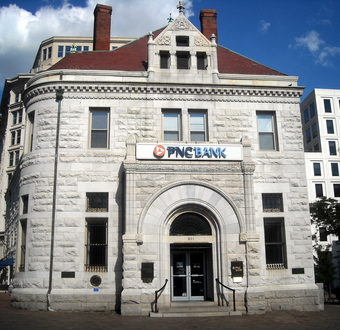
Banks are the most common financial intermediaries
Banks convert deposits to loans and thereby increase access to capital by serving as a financial intermediary between savers and borrowers.
Though, perhaps the most well-known of financial intermediaries, banks represent only one intermediary within a larger group. Other financial intermediaries include: credit unions, private equity, venture capital funds, leasing companies, insurance and pension funds, and micro-credit providers.
Major functions of financial intermediaries
As noted, financial intermediaries provide access to capital. However, in conjunction with increasing access to funds, through their ability to aggregate funds, intermediaries also reduce the transaction and search costs between lenders and borrowers.
By repurposing funds from savers to borrowers financial intermediaries are able to promote economic growth by providing access to capital. Through diversification of loan risk, financial intermediaries are able to mitigate risk through pooling of a variety of risk profiles and through creating loans of varying lengths from investor monies or demand deposits, these intermediaries are able to convert short-term liabilities to assets of varying maturities.
Returning to the example of a bank used above, banks convert short-term liabilities (demand deposits) into long-term assets by providing loans; thereby transforming maturities. Additionally, through diversified lending practices, banks are able to lend monies to high-risk entities and by pooling with low-risk loans are able to gain in yield while implementing risk management.
29.1.2: Role in Matching Savings and Investment Spending
Savings are income after-consumption and investment is what is facilitated by saving.
Learning Objective
Explain the connection between savers and investors
Key Points
- The marginal propensity to save (MPS), the percentage of after-tax income that an economic agent will choose to save.
- Savings marketed by financial intermediaries, all consist of stocks, bonds, and cash balances, which in turn pay for the investment capital that increases productivity, efficiency and output of goods and services.
- Financial intermediaries are a significant component to the transformation of savings into investment.
Key Term
- real interest rates
-
The rate of interest an investor expects to receive after allowing for inflation.
A popular national income accounting framework for discussing the economy is the GDP expenditure equation:
Y = C + I + G + (X – M), where C refers to consumption spending, I references investment spending, G is government spending, and X – M is net imports (X, exports; M, imports). Savings is defined as income that is not consumed. C, is consumption. Investment, I, is made into capital (plant and machinery, also ‘human capital’ – training and education), with intent to increase productivity, efficiency and output of goods and services. I can be generally defined as purchases of good that will be used to produce more goods and services in the future. In national accounting terms, stocks, bonds, mutual funds, and other cash equivalents, are not classified as investments but rather are classified as savings. Savings from this perspective facilitates capital purchase which are included in investments
Saving is what households (participants in the consumption account) do. The level of saving in the economy depends on a number of factors:
- A higher real interest rates increases returns to saving.
- Poor expectations for future economic growth, increase households’ savings as a precaution.
- More disposable income after fixed expenditures (such as mortgage, heating bill, basic goods purchases) have been made increases saving.
- Perceived likelihood of reduced return through regulation or taxation on savings will make saving less attractive.
Marginal propensity to save
The factors as stated affect the marginal propensity to save (MPS), the percentage of after-tax income that an economic agent will choose to save. The greater the MPS, the more saving households will do as a proportion of each additional increment of income. Stocks and bonds are considered to be important intermediary forms of savings as these get transformed into a capital investment that produces value .
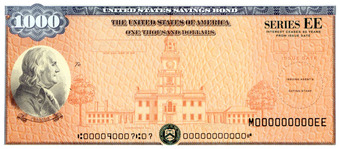
Bonds are a type of savings
Savings are used to fund investments, where investments are defined as expenditures on factory plants, equipment and homes.
Savings and Investment
Assuming a closed economy, one where there is no export or impart activity to interfere with the domestic savings level, on an aggregate basis individual savings creates the supply of loanable funds available for investment purposes. The amount of savings available in the economy is equal to the amount of funding available for investment activity. The higher the level of savings, typically the lower the relative interest rate, ceteris paribus. On a macroeconomic theory basis, a higher the savings rate promotes business activity my lessening the cost of money and increasing risk taking activities to facilitate growth or production of goods and services.
Financial intermediaries can assist with increasing the incentive to save through developing financial products that offer ease of liquidation but provide a higher return than a savings account. In this manner, financial intermediaries are a significant component to the transformation of savings into investment. Mutual funds, pension obligations, insurance annuities, and other forms of savings marketed by financial intermediaries all consist of stocks, bonds, and cash balances, which in turn pay for the investment capital that increases productivity, efficiency and output of goods and services.
29.1.3: Role in Providing a Market for Loanable Funds
The loanable funds market is a conceptual market where savers (suppliers) and borrowers (demanders) are able to establish a market clearing.
Learning Objective
Summarize the mechanics of the loanable funds market.
Key Points
- In the loanable funds market, market clearing is defined as the interest rate/loanable funds quantity where savings equal investment (the amount of capital needed for property, plant, and equipment based investments).
- The interest rate is the cost of borrowing or demanding loanable funds and is the amount of money paid for the use of a dollar for a year.
- Loanable funds are often used to invest in new capital goods. Therefore, the demand and supply of capital is usually discussed in terms of the demand and supply of loanable funds.
Key Term
- loanable funds
-
Money available to be issued as debt.
In economics, the loanable funds market is a conceptual market where savers (suppliers) and borrowers (demanders) are able to establish a market clearing quantity and price (interest rate). In the loanable funds market, market clearing is defined as the interest rate/loanable funds quantity where savings equal investment (the amount of capital needed for property, plant, and equipment based investments) . Loanable funds are typically cash, but can also include other financial assets to serve as an intermediary.
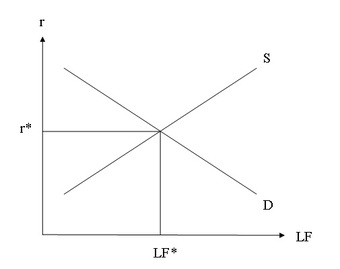
Equilibrium in the loanable funds market
When the supply and demand for loanable funds are equal, savings is equal to investment and the loanable funds market is in equilibrium at the prevailing interest rate.
For instance, buying bonds will transfer savers’ money to the institution issuing the bond, which can be a firm or government. In return, the borrower’s (institution issuing the bond) demand for loanable funds is satisfied when the institution receives cash in exchange for the bond.
Loanable funds are often used to invest in new capital goods. Therefore, the demand and supply of capital is usually discussed in terms of the demand and supply of loanable funds.
Interest rate
The interest rate is the cost of borrowing or demanding loanable funds and is the amount of money paid for the use of a dollar for a year. The interest rate can also describe the rate of return from supplying or lending loanable funds.
As an example, consider this: a firm that borrows $10,000 in funds for one year, at an annual interest rate of 10%, will have to pay the lender $11,000 at the end of the year. This amount includes the original $10,000 borrowed plus $1,000 in interest; in mathematical terms, this can be written as $10,000 × 1.10 = $11,000.
29.2: Tools of Finance
29.2.1: Present Value and the Time Value of Money
The time value of money is the principle that a certain amount of money today has a different buying power (value) than in the future.
Learning Objective
Calculate the present and future value of money
Key Points
- Time value of money: (1 + r)t x (the value of the initial investment) = future value; where r is the annual interest rate and t is the number of years.
- The time value of money is the central concept in finance theory. However, the explanation of the concept typically looks at the impact of interest and assumes, for simplicity, that inflation is neutral.
- The time value of money is the principle that a certain amount of money today has a different buying power (value) than the same currency amount of money in the future.
Key Terms
- time value of money
-
The principle that a certain currency amount of money today has a different buying power (value) than the same currency amount of money in the future.
- present value
-
The value of an asset in today’s dollars after adjusting for an increase in the asset values as a result of interest earned during the period.
The time value of money is the principle that a certain amount of money today has a different buying power (value) than the same currency amount of money in the future. The value of money at a future point of time would take account of interest earned or inflation accrued over a given period of time. This notion exists both because there is an opportunity to earn interest on the money and because inflation will drive prices up, thus changing the “value” of the money.
For example, assume that an investor has $100 today and can invest this money at a 5% return for one year. A year from now the original investment will equal $105, (100)*(1.05). The return of $5 represents the time value of money over the one year interval .

Money
Assuming a 5% interest rate, $100 invested today will be worth $105 in one year ($100 multiplied by 1.05). Conversely, $100 received one year from now is only worth $95.24 today ($100 divided by 1.05), assuming a 5% interest rate.
Time value of money: (1 + r)t x (the value of the initial investment) = future value; where r is the annual interest rate and t is the number of years.
Alternatively, if an investment is valued at $125 and this value includes the 7% return generated over a one year time horizon, the original value of the investment or its present value is equal to (125)/(1.07) or 117.
Present value: (the value of the investment at a future time)/(1 + r)n; where r is the annual interest rate and n is the number of years the investment has occurred.
The time value of money is the central concept in finance theory. However, the explanation of the concept typically looks at the impact of interest and assumes, for simplicity, that inflation is neutral.
29.2.2: Measuring and Managing Risk
Risk is pervasive in the economy and is an essential component in the derivation of an asset’s investment return.
Learning Objective
Explain the relationship between time, money, and risk
Key Points
- Investment returns compensate holders for the time to maturity via a risk premium.
- Risk premium compensates holders for risks inherent to an investment and are incorporated in the rate of return quoted for an investment.
- To compensate investors for taking on reinvestment risk, issuers will provide a risk premium to incentivize the investor to purchase the investment.
Key Terms
- time horizon
-
A fixed point of time in the future where certain processes will be evaluated or assumed to end.
- risk premium
-
The minimum amount of money by which the expected return on a risky asset must exceed the known return on a risk-free asset
Assets can have varying maturity dates and potential for default, the attribution of time to maturity and timely payments involve an assessment of risk. Risk is pervasive in the economy and is an essential component in the derivation of an asset’s investment return.
Time and Risk
Time is a component of risk for varying reasons; however, the two most common are related to the increase in general uncertainty rising with the time horizon and reinvestment risk.
In our everyday lives, we are faced with momentary uncertainties that become increasingly harder to predict as we move from a five minute horizon to a five day, five month, or even five year period. This same phenomenon is true of financial assets. Though the attribution of acceptable inflation can be incorporated into an investment return, the actual pricing and resulting purchasing power of the investment at maturity is unknown and the uncertainty increases with time. Therefore, investment returns compensate holders for the time to maturity via a risk premium .
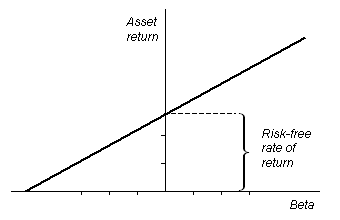
Return expectations are based on risk analysis
In finance and economics, as depicted in the graph above of the capital asset pricing model, risk is evaluated to set the boundary for acceptable return.
Risk premium compensates holders for risks inherent to an investment and are incorporated in the rate of return quoted for an investment. For example, if asset A and asset B both pay a 5% coupon on an annual basis, but asset B matures in 5 years and asset A matures in 1 year, all else equal (asset quality and issuer solvency), we would expect asset A to trade at a higher price than asset B. Remembering that yield and price are inversely related, the higher price on A implies that it has a lower yield than B. The differential in yield can be attributed to a risk premium for time to maturity.
Another aspect of time horizon is reinvestment risk. For some investments, there is a potential for an issuer to call or redeem a security prior to maturity. Given that at the time that the investment is called prevailing rates may be lower than at the purchase of the asset, the holder is taking a reinvestment risk at the time of purchase. To compensate investors for taking on this type of risk, the issuer will provide a risk premium to incentivize the investor to purchase the investment.
29.2.3: The Value of Diversification
The compensation adjustment for holding an asset of a given risk profile can be further enhanced through asset diversification.
Learning Objective
Explain the rationale for diversification
Key Points
- Diversification strategies can be as simple as not “placing all your eggs in one basket” or be as complex as routine evaluation of investment correlation and risk and dynamic rebalancing of investment holdings.
- Whether a common sense or highly quantitative approach is taken, the benefit of diversification is to limit risk and enhance consistency of return. A diversified portfolio will earn a return that is always higher than its lowest performing asset.
- Most asset managers would advocate holdings that are diversified across sectors and asset classes to further the benefit of growth and reduce the risk of performance volatility that may be attributable to a company, sector, or asset class.
- Investors may enter into hedging strategies in order to ensure a constant return over market volatility. For a fee, a hedging strategy offers a constant return on an investment. The party on the other side of the hedge absorbs the volatility of the investment and pays out a consistent return.
Key Terms
- asset clas
-
A group of economic resources sharing similar characteristics, such as riskiness and return.
- risk premium
-
The minimum amount of money by which the expected return on a risky asset must exceed the known return on a risk-free asset
- prospectus
-
A document, distributed to prospective members, investors, buyers, or participants, which describes an institution (such as a university), a publication, or a business and what it has to offer.
Each asset class has specific investment objectives; these are typically stated in a prospectus or investment description. However, all investments have some degree of risk in meeting the stated investment objectives or return.
The risks that are inherent to a specific investment can be compensated for by a market-assessed risk premium, whereby market participants adjust the price of an asset, impacting its overall return, based on the risk characteristics of the asset. However, the compensation adjustment for holding an asset of a given risk profile can be further enhanced through asset diversification.
The Value of Diversification
Diversification strategies can be as simple as not “placing all your eggs in one basket. ” It can also be as complex as a routine evaluation of investment correlation and risk, and dynamic rebalancing of investment holdings. However, whether a common sense or a highly quantitative approach is taken, the benefit of diversification is to limit risk and enhance consistency of return.
By holding varying investments, even if they are within the same company or sector, an investor still has the benefit of reducing risk inherent from the default of one asset. For example, stock and bonds provide different returns; while a stock may exhibit no growth for a period of time, the bond may continue to pay its coupon and provide a return. Through diversification, an investor’s entire portfolio can perform better than its worst-performing asset.
In general, most asset managers would advocate holdings that are diversified across sectors and asset classes to further the benefit of growth and reduce the risk of performance volatility that may be attributable to a company, sector, or asset class . In some cases where the return on investment needs to be met, managers may advocate for the use of hedging instruments to transfer risk of return objectives being met to another party in lieu of a consistent return.
Hedging strategies can be relatively complex but, in general, they serve the role of insuring that an investor is able to meet investment performance objectives. Typically, an investor pays a fee and enters into the hedging strategy, which transfer the risk inherent in an investment for a constant return. The party on the opposite side of the hedge absorbs both the upside and downside return potential of the asset, along with the fee for taking on the risk of uncertainty, and pays the first party a constant return as part of the agreement.
Systematic Risk
It’s important to note that diversification does not remove all of the risk from the portfolio. Diversification can reduce the risk of any single asset, but there will still be systematic risk (or undiversifiable risk). Systematic risk arises from market structure or dynamics which produce shocks or uncertainty faced by all agents in the market. For example, government policy, international economic forces, or acts of nature can shock the entire market. Systematic risk will affect the portfolio, regardless of how diversified it is.
29.2.4: The Relationship Between Risk and Return and the Security Market Line
The security market line is useful to determine if an asset being considered for a portfolio offers a reasonable expected return for risk.
Learning Objective
Explain how the security market line relates risk and return
Key Points
- In finance, the capital asset pricing model (CAPM) is used to determine the required rate of return of an asset taking into account an asset’s sensitivity to non-diversifiable risk.
- The security market line essentially graphs the results from the capital asset pricing model formula. The intercept of the SML is the nominal risk-free rate available for the market, while the slope is the market premium.
- If the security’s expected return versus risk is plotted above the SML, it is undervalued since the investor can expect a greater return for the inherent risk. A security plotted below the SML is overvalued since the investor would be accepting less return for the amount of risk assumed.
Key Terms
- systematic risk
-
The risk associated with an asset that is correlated with the risk of asset markets generally, often measured as its beta.
- non-systematic risk
-
Risk that is unique to a specific company; can be reduced through diversification.
- capital asset pricing model
-
Used to determine the required rate of return of an asset taking into account an asset’s sensitivity to non-diversifiable risk (also known as systematic risk or market risk).
- security market line
-
A line representing the relationship between expected return and systematic risk; thus a graphical representation of the capital asset pricing model.
Investment assets are typically characterized as having two performance risks: systematic (or market risk) and non-systematic risk. Systematic risk arises from market structure or dynamics, which produce shocks or uncertainty faced by all agents in the market. Non-systematic risk is unique to a specific company and can be reduced through diversification.
Capital Asset Pricing Model (CAPM)
In finance, the capital asset pricing model (CAPM) is used to determine the required rate of return of an asset, taking into account an asset’s sensitivity to non-diversifiable or systematic risk. Non-diversifiable risk is noted by the variable beta (β), where beta is greater than one if the asset’s price sensitivity is greater than the market; equal to one when the asset’s sensitivity is equal to the market; and less than one if the asset exhibits less pricing volatility than the market.
The CAPM is a model for pricing an individual security or portfolio. The expected return of an asset is equal to the risk free rate plus the excess return of the market above the risk-free rate, adjusted for the asset’s overall sensitivity to market fluctuations or its beta. Mathematically, the capital asset pricing model can be written as: E(Ri) = Rf + β(E(Rm) – Rf), where R is the return, E(R) is the expected return, i denotes any asset, f is the risk-free asset, and m is the market.
Security Market Line (SML)
For individual securities, the security market line (SML) and its relation to expected return and systematic risk (beta) depicts an individual security in relation to their security risk class . The SML essentially graphs the results from the capital asset pricing model formula. The x-axis represents the risk (beta), and the y-axis represents the expected return. The market risk premium is determined from the slope of the SML. The relationship between β and required return is plotted on the SML, which shows expected return as a function of β. The intercept is the nominal risk-free rate available for the market, while the slope is the market premium, E(Rm)− Rf.
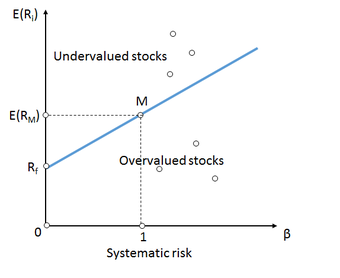
Security market line
The security market line depicts the the return on a security relative to its own risk.
The SML is a useful tool in determining if an asset being considered for a portfolio offers a reasonable expected return for risk. Individual securities are plotted on the SML graph. If the security’s expected return versus risk is plotted above the SML, it is undervalued since the investor can expect a greater return for the inherent risk. A security plotted below the SML is overvalued since the investor would be accepting a smaller return for the amount of risk assumed.
Chapter 28: Monetary Policy
28.1: Introduction to Monetary Policy
28.1.1: The Demand for Money
In economics, the demand for money is the desired holding of financial assets in the form of money (cash or bank deposits).
Learning Objective
Relate the level of the interest rate to the demand for money
Key Points
- Money provides liquidity which creates a trade-off between the liquidity advantage of holding money and the interest advantage of holding other assets.
- The quantity of money demanded varies inversely with the interest rate.
- While the demand of money involves the desired holding of financial assets, the money supply is the total amount of monetary assets available in an economy at a specific time.
- In the United States, the Federal Reserve System controls the money supply. The Fed has the ability to increase the money supply by decreasing the reserve requirement.
Key Terms
- money supply
-
The total amount of money (bills, coins, loans, credit, and other liquid instruments) in a particular economy.
- asset
-
Something or someone of any value; any portion of one’s property or effects so considered.
The Demand for Money
In economics, the demand for money is generally equated with cash or bank demand deposits. Generally, the nominal demand for money increases with the level of nominal output and decreases with the nominal interest rate.
The equation for the demand for money is: Md = P * L(R,Y). This is the equivalent of stating that the nominal amount of money demanded (Md) equals the price level (P) times the liquidity preference function L(R,Y)–the amount of money held in easily convertible sources (cash, bank demand deposits). Specific to the liquidity function, L(R,Y), R is the nominal interest rate and Y is the real output.
Money is necessary in order to carry out transactions. However inherent to the holding of money is the trade-off between the liquidity advantage of holding money and the interest advantage of holding other assets.
When the demand for money is stable, monetary policy can help to stabilize an economy. However, when the demand for money is not stable, real and nominal interest rates will change and there will be economic fluctuations.
Impact of the Interest Rate
The interest rate is the rate at which interest is paid by a borrower (debtor) for the use of money that they borrow from a lender (creditor). It is viewed as a “cost” of borrowing money. Interest-rate targets are a tool of monetary policy. The quantity of money demanded varies inversely with the interest rate. Central banks in countries tend to reduce the interest rate when they want to increase investment and consumption in the economy. However, low interest rates can create an economic bubble where large amounts of investments are made, but result in large unpaid debts and economic crisis. The interest rate is adjusted to keep inflation, the demand for money, and the health of the economy in a certain range. Capping or adjusting the interest rate parallel with economic growth protects the momentum of the economy.
Control of the Money Supply
While the demand of money involves the desired holding of financial assets, the money supply is the total amount of monetary assets available in an economy at a specific time. Data regarding money supply is recorded and published because it affects the price level, inflation, the exchange rate, and the business cycle.
Monetary policy also impacts the money supply. Expansionary policy increases the total supply of money in the economy more rapidly than usual and contractionary policy expands the supply of money more slowly than normal. Expansionary policy is used to combat unemployment, while contractionary is used to slow inflation.
In the United States, the Federal Reserve System controls the money supply. The reserves of money are kept in Federal Reserve accounts and U.S. banks. Reserves come from any source including the federal funds market, deposits by the public, and borrowing from the Fed itself. The Fed can attempt to change the money supply by affecting the reserve requirement and through other monetary policy tools .

Federal Funds Rate
This graph shows the fluctuations in the federal funds rate from 1954-2009. The Federal Reserve implements monetary policy through the federal funds rate.
28.1.2: Shifts in the Money Demand Curve
A shift in the money demand curve occurs when there is a change in any non-price determinant of demand, resulting in a new demand curve.
Learning Objective
Explain factors that cause shifts in the money demand curve, Explain the implications of shifts in the money demand curve
Key Points
- The real demand for money is defined as the nominal amount of money demanded divided by the price level.
- The nominal demand for money generally increases with the level of nominal output (the price level multiplied by real output).
- The demand for money shifts out when the nominal level of output increases.
- The demand for money is a result of the trade-off between the liquidity advantage of holding money and the interest advantage of holding other assets.
Key Terms
- asset
-
Something or someone of any value; any portion of one’s property or effects so considered.
- nominal interest rate
-
The rate of interest before adjustment for inflation.
Demand for Money
In economics, the demand for money is the desired holding of financial assets in the form of money. The nominal demand for money generally increases with the level of nominal output (the price level multiplied by real output). The interest rate is the price of money. The quantity of money demanded increases and decreases with the fluctuation of the interest rate. The real demand for money is defined as the nominal amount of money demanded divided by the price level. A demand curve is used to graph and analyze the demand for money.
Factors that Cause Demand to Shift
A demand curve has the price on the vertical axis (y) and the quantity on the horizontal axis (x). The shift of the money demand curve occurs when there is a change in any non-price determinant of demand, resulting in a new demand curve. Non-price determinants are changes cause demand to change even if prices remain the same. Factors that influence prices include:
- Changes in disposable income
- Changes in tastes and preferences
- Changes in expectations
- Changes in price of related goods
- Population size
Factors that change the demand include:
- Decrease in the price of a substitute
- Increase in the price of a complement
- Decrease in consumer income if the good is a normal good
- Increase in consumer income if the good is an inferior good
The demand for money shifts out when the nominal level of output increases. It shifts in with the nominal interest rate.

Shift of the Demand Curve
The graph shows both the supply and demand curve, with quantity of money on the x-axis (Q) and the price of money as interest rates on the y-axis (P). When the quantity of money demanded increase, the price of money (interest rates) also increases, and causes the demand curve to increase and shift to the right. A decrease in demand would shift the curve to the left.
Implications of Demand Curve Shift
The demand for money is a result of the trade-off between the liquidity advantage of holding money and the interest advantage of holding other assets. The demand for money determines how a person’s wealth should be held. When the demand curve shifts to the right and increases, the demand for money increases and individuals are more likely to hold on to money. The level of nominal output has increased and there is a liquidity advantage in holding on to money. Likewise, when the demand curve shifts to the left, it shows a decrease in the demand for money. The nominal interest rate declines and there is a greater interest advantage in holding other assets instead of money.
28.1.3: The Equilibrium Interest Rate
In a economy, equilibrium is reached when the supply of money is equal to the demand for money.
Learning Objective
Use the concept of market equilibrium to explain changes in the interest rate and money supply
Key Points
- The interest rate is the rate at which interest is paid by a borrower (debtor) for the use of money that they borrow from a lender (creditor).
- Factors that contribute to the interest rate include: political gains, consumption, inflation expectations, investments and risks, liquidity, and taxes.
- In the case of money supply, the market equilibrium exists where the interest rate and the money supply are balanced.
- The real interest rate measures the purchasing power of interest receipts. It is calculated by adjusting the nominal rate charge to take inflation into account.
Key Terms
- equilibrium
-
The condition of a system in which competing influences are balanced, resulting in no net change.
- interest rate
-
The percentage of an amount of money charged for its use per some period of time (often a year).
Interest Rate
The interest rate is the rate at which interest is paid by a borrower (debtor) for the use of money that they borrow from a lender (creditor). Equilibrium is reached when the supply of money is equal to the demand for money. Interest rates can be affected by monetary and fiscal policy, but also by changes in the broader economy and the money supply.
Factors that Influence the Interest Rate
Interest rates fluctuate over time in the short-run and long-run . Within an economy, there are numerous factors that contribute to the level of the interest rate:

Fluctuation in Interest Rates
This graph shows the fluctuation in interest rates in Germany from 1967 to 2003. Interest rates fluctuate over time as the result of numerous factors. In Germany, the interest rates dropped from 14% in 1967 to almost 2% in 2003. This graph illustrates the fluctuations that can occur in the short-run and long-run. Interest rates fluctuate based on certain economic factors.
- Political gain: both monetary and fiscal policies can affect the money supply and demand for money.
- Consumption: the level of consumption (and changes in that level) affect the demand for money.
- Inflation expectations: inflation expectations affect a the willingness of lenders and borrowers to transact at a given interest rate. Changes in expectations will therefore affect the equilibrium interest rate.
- Taxes: changes in the tax code affect the willingness of actors to invest or consume, which can therefore change the demand for money.
Market Equilibrium
In economics, equilibrium is a state where economic forces such as supply and demand are balanced and without external influences, the equilibrium will stay the same. Market equilibrium refers to a condition where a market price is established through competition where the amount of goods and services sought by buyers is equal to the amount of goods and services produced by the sellers. In the case of money supply, the market equilibrium exists where the interest rate and the money supply are balanced. The money supply is the total amount of monetary assets available in an economy at a specific time. Without external influences, the interest rate and the money supply will stay in balance.
28.2: Monetary Policy Tools
28.2.1: The Reserve Ratio
The reserve ratio is the percentage of deposits that a bank is required to hold in reserves, or funds that are not allowed to be loaned.
Learning Objective
Identify the effects of reserve requirements on monetary policy
Key Points
- The required reserve ratio is a tool in monetary policy, given that changes in the reserve ratio directly impacts the amount of loanable funds available.
- Money growth in the economy can occur through the multiplier effect resulting from the reserve ratio.
- The higher the reserve requirement is set, the less the amount of funds banks will have to loan out, leading to lower money creation. Alternatively, the higher the reserve requirement the, lower the supply of loanable funds, the higher the interest rate and the slower the resulting economic growth.
Key Terms
- loanable funds
-
Money available to be issued as debt.
- money supply
-
The total amount of money (bills, coins, loans, credit, and other liquid instruments) in a particular economy.
- monetary policy
-
The process by which the central bank, or monetary authority manages the supply of money, or trading in foreign exchange markets.
Banks assume responsibility for consumer deposits and make money by loaning out deposited finds. Therefore, banks with relatively higher deposits are able to supply a larger amount of loanable funds. The supply of loanable funds directly impacts growth and interest rates in an economy. Typically, an increase in the supply of loanable funds is associated with a decrease in interest rates. The greater the accessibility of loanable funds, as conferred by access and cost, the greater opportunity for businesses and consumers to make investment purchases and increase production and labor supply, respectively.
However, in economic downturns the amount of outstanding loans may be counter to a bank’s longevity, as depositors may seek to cash-out holdings. In order to reduce the risk of a panic or “run on bank” from the perception that a bank may not have adequate liquidity to meet depositor access to cash deposits, central banks have adopted policies to ensure that banks use prudent judgement when assessing the amount of deposits to loan.
Reserve Ratio
The reserve ratio is a central bank regulatory tool employed by most, but not all, of the world’s central banks. The ratio is a set percentage of customer deposits that a bank is required to hold in reserves, or funds that are not allowed to be loaned. Required reserves are normally in the form of cash stored physically in a bank vault (vault cash) or deposits made with a central bank. The required reserve ratio is a tool in monetary policy, given that changes in the reserve ratio directly impact the amount of loanable funds available .
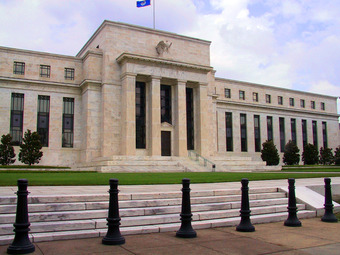
Federal Reserve-US Central Bank
The Federal Reserve is charged with maintaining sustainable economic growth. To carry out its responsibilities, the “Fed” uses policies including the reserve ratio to adjust the money supply to either incentivize growth or slow down growth, as needed.
Monetary policy tool
Money growth in the economy can occur through the multiplier effect resulting from the reserve ratio. For example, a reserve ratio of 20% will result in 80% of any given initial deposit being loaned out and if the process of loaning is assumed to continue, the maximum increase in money expansion specific to an initial deposit at a 20% reserve ratio will be equal to the reserve multiplier 1/(reserve ratio) x the initial deposit.
For example, with the reserve ratio (RR) of 20 percent, the money multiplier, m, will be calculated as:
This then signifies that any initial deposit will contribute to an expansion in money supply up to 5 times its original value.
The conventional view in economic theory is that a reserve requirement can act as a tool of monetary policy. The higher the reserve requirement is set, the theory supposes, the less the amount of funds banks will have to loan out, leading to lower money creation. Alternatively, the higher the reserve requirement the, lower the supply of loanable funds, the higher the interest rate and the slower the resulting economic growth.
28.2.2: The Discount Rate
The rate that member banks charge each other is the federal funds rate and the rate the Fed charges is referred to as the discount rate.
Learning Objective
Illustrate the effects of the discount rate on monetary policy
Key Points
- The Fed targets the rate for federal funds via its open market operations.
- The Fed seeks to be the lender of last resort by charging banks a higher rate than the federal funds rate.
- The discount rate difference over the fed funds rate can be varied by the Fed based on bank liquidity needs.
Key Terms
- fed funds rate
-
Short for Federal Funds rate. The interest rate at which depository institutions actively trade balances held at the Federal Reserve, called federal funds, with each other, usually overnight, on an uncollateralized basis.
- discount rate
-
An interest rate that a central bank charges to depository institutions that borrow reserves from it.
- open market operations
-
An activity by a central bank to buy or sell government bonds on the open market. A central bank uses them as the primary means of implementing monetary policy.
The central bank of the United States is the Federal Reserve (the Fed). The Fed employs monetary policy through direct controls on the money supply through open market operations to achieve economic stability and growth.
Open market operations entail Fed intervention in the buying and selling of government bonds to achieve a change in the money supply and the corresponding change in the interest rate. The Fed sells bonds to reduce the money supply and increase the prevailing interest rate and buys bonds to increase the money supply and reduce the prevailing interest rate. The interest rate is an active target and is set as a target rate range by the Fed; it is conveyed to the public by the Federal Reserve Open Market Committee (FOMC) as the fed funds target rate (short for the Federal Funds rate).
Coincident with the Fed’s open market operations is the Fed’s selection of a reserve requirement which corresponds to a required percentage of deposits (reserves) that banks must keep on site or at the Fed on a daily basis. Given their daily activities, banks may fall short of their required daily reserve requirement. When this occurs, banks may either turn to the Fed or Fed member banks for overnight or short-term loans to satisfy their liquidity short-fall. The rate that member banks charge each other is referred to as the federal funds rate and the rate the Fed charges banks is referred to as the discount rate.
This distinction is particularly important. The discount rate is the rate that the central bank actual controls. It is the rate the central bank charges its member banks to borrow overnight. However, the rate that the central bank actually cares about is the fed funds rate. That is the rate banks charge each other, and is influenced by the discount rate.
The Fed targets the rate for federal funds via its open market operations and seeks to be the lender of last resort by charging banks a higher rate than the federal funds rate .
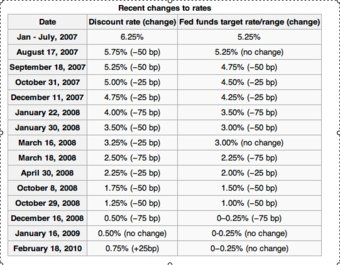
Historical discount and fed fund target rates
The discount rate is higher than the fed funds target rate and the variance serves as a disincentive for banks to seek funds or short-term borrowings from the Fed.
For example, the difference or spread of the primary credit rate (rate to member banks in solid financial standing) over the FOMC’s target federal funds rate was initially 1 percent. During the financial crisis, this spread was reduced to one-half of one percent on August 17, 2007, and was further reduced, to a quarter of 1 percent, on March 16, 2008.
Typically, the discount rate along with the fed funds target rate are mechanisms that the Fed uses to discourage banks from excess lending, as part of a contractionary or restrictive policy scheme. Given that lending has an expansionary effect, to the extent that the fed funds target rate and discount rate diminish the profitability of excess loaning, these parameters place limits to the expansion of the money supply via the loanable funds market. However, as noted in the aforementioned historical example, the discount rate, in conjunction with the fed funds target rate, may be purposely maintained at a lower interest level to encourage borrowing and increase growth when the economy is showing signs of either slowing or contracting. In this manner, the discount rate in tandem with the fed funds target rate are part of an expansionary policy mechanism.
28.2.3: The Federal Funds Rate
The Federal Funds rate is the interest rate at which depository institutions actively trade balances held at the Federal Reserve.
Learning Objective
Discuss the importance of the Federal Funds Rate as a monetary policy tool
Key Points
- Banks may borrow reserves from one another overnight in order to maintain their required reserve ratio. The rate of interest negotiated between banks for these loans is the Federal Funds rate.
- The Federal Funds rate is directly related to the interest rate paid by firms and individuals. If a bank can borrow reserves cheaply, it can afford to offer loans to the public at lower rates. Thus, a high Federal Funds rate is contractionary, while a low federal funds rate is expansionary.
- The Federal Reserve doesn’t control the Federal Funds rate directly, but it does set a target interest rate and uses open market operations in order to achieve that rate.
- The Fed doesn’t control the federal funds rate directly, but it does set a target interest rate and uses open market operations in order to achieve that rate.
Key Terms
- reserve
-
Banks’ holdings of deposits in accounts with their central bank.
- federal funds rate
-
The interest rate at which depository institutions actively trade balances held at the Federal Reserve with each other.
The Federal Funds rate (or fed funds rate) is the interest rate at which depository institutions (primarily banks) actively trade balances held at the Federal Reserve. In the US, banks are obligated to maintain certain levels of reserves, either in the form of reserves with the Fed or as vault cash. Each day, banks receive deposits, which contribute to a bank’s reserves, and issue loans, which are liabilities against the bank. These daily activities change their ratio of reserves to liabilities. If, by the end of the day, the bank’s reserve ratio has dropped below the legally required minimum, it must add to its reserves in order to remain compliant with the law. Banks do this by borrowing reserves from other banks with excess reserves, and the weighted average of these interest rates paid by borrowing banks determines the federal funds rate.
The Federal Funds rate is directly related to the interest rate paid by firms and individuals. If a bank can borrow reserves cheaply, it can afford to offer loans to the public at lower rates and still make a profit. On the other hand, if the Federal Funds rate is high, banks will not borrow reserves in order to issue low-interest loans to the public. In fact, many mortgages and credit card interest rates are indexed to the Federal Funds rate – a homeowner might pay an adjustable interest rate that is set at the level of the Federal Funds rate plus four percent, for example. A high Federal Funds rate, therefore, has a contractionary effect on economic activity, while a low Federal Funds rate has an expansionary effect.
The Fed doesn’t control the Federal Funds rate directly – it is negotiated between borrowing and lending banks – but it does set a target interest rate and uses open market operations in order to achieve that rate. The target Federal Funds rate is decided by the governors at the Federal Open Market Committee (FOMC) meetings, who will either increase, decrease, or leave the target rate unchanged based on the economic conditions within the country . Influencing the Federal Funds rate is the primary monetary policy tool that the Fed uses to achieve its dual mandate of stable prices and low unemployment.

Federal Funds Rate 1954-2009
The graph shows the federal funds rate for the past fifty years. The peak in the 1980s reflects the contractionary monetary policy the Fed instituted to combat high levels of inflation due to oil shocks, and the low rate in the late 2000s reflects expansionary monetary policy meant to combat the effects of recession.
28.2.4: Open Market Operations
Open market operations (OMOs) are the purchase and sale of securities in the open market by a central bank.
Learning Objective
Discuss the use of open market operations to implement monetary policy
Key Points
- In the United States, the Federal Reserve Bank of New York uses open market operations to implement monetary policy.
- This occurs under the oversight of the Federal Reserve Open Market Committee (FOMC).
- The short-term objective for open market operations is specified by the FOMC and is publicly communicated following the FOMC meeting.
- Historically, the Federal Reserve has used OMOs to adjust the supply of reserve balances so as to keep the federal funds rate–the interest rate at which depository institutions lend reserve balances to other depository institutions overnight–around the target established by the FOMC.
Key Terms
- open market operations
-
An activity by a central bank to buy or sell government bonds on the open market. A central bank uses them as the primary means of implementing monetary policy.
- fed funds target rate
-
The interest rate at which depository institutions actively trade balances held at the Federal Reserve, called federal funds, with each other, usually overnight, on an uncollateralized basis.
The Federal Reserve has several tools at its disposal to reach its monetary policy objectives. These include the discount rate, the fed funds target rate, and the reserve requirement, and open market operations (OMOs). OMOs are considered to be the most flexible option for the Federal Reserve out of all of these.
On a general level, OMO are the purchase and sale of securities in the open market by a central bank, as a means of controlling the money supply and the related prevailing interest rate.
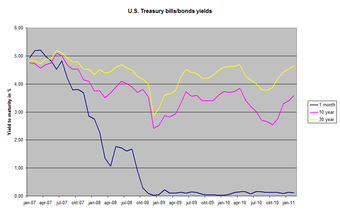
US Treasury Bill Yields
By buying and selling US Treasury bills on the open market, the Federal Reserve hopes to change their yields, which will then affect the interest rates in the broader market.
In the United States, the Federal Reserve Bank of New York conducts open market operations. They are under the oversight of the Federal Reserve Open Market Committee (FOMC). The FOMC makes a plan for open market operations over the short term, and publicly announce it after their regularly scheduled meetings.
Historically, the Federal Reserve has used OMOs to adjust the supply of reserve balances so as to keep the federal funds rate–the interest rate at which depository institutions lend reserve balances to other depository institutions overnight–around the target established by the FOMC.
OMO Mechanism
OMOs are typically either expansionary or contractionary in nature. In an expansionary platform, the OMO will seek to increase the money supply and reduce interest rates in order to promote economic growth. In a contractionary scheme, the OMO will seek to reduce the money supply and increase interest rates in an effort to deter economic growth. Therefore, the implementation of contractionary policy will result in the selling of bonds (cash in exchange for debt holding) and an expansionary policy (buy bonds in exchange for cash) will result in an increase in the money supply at a lower interest rate as a means to enhance growth opportunities and revitalize the economy.
The interest rate targeted through the OMO manipulation of the money supply is the fed funds target rate or the rate that member Fed banks charge one another for overnight loans. The target rate is important monetary tool from the perspective that the higher the fed funds rate relative to the return on loanable funds, the greater the incentive for banks to meet their reserve requirement (the bank will lose money) thereby placing limits on the growth of the money supply through the loanable funds market. In addition to this direct interest rate channel, the fed funds rate influences many other interest rates in the economy and by so doing contributed to either incentivizing borrowing for growth or disincentivizing the same.
28.2.5: Setting and Achieving the Interest Rate Target
The Federal Reserve (Fed) has an ability to directly influence economic growth and stability through the use of monetary policy.
Learning Objective
Describe the way in which the Federal Reserve targets the interest rate
Key Points
- Though the Fed can directly influence the money supply through open market operations, the majority of the Fed’s activities seek to target interest rates, the outcome of changes in money supply.
- Using its open market channel, the Fed buys government bonds to increase the money supply and sells the same bonds to reduce it.
- The Fed actively adjusts the buying and selling of bonds to achieve the target interest rate. This in turn impacts the rate that Fed member banks are willing to charge each other for overnight loans, or the fed funds rate.
Key Terms
- reserve ratio
-
A central bank regulation employed by most, but not all, of the world’s central banks, that sets the minimum fraction of customer deposits and notes that each commercial bank must hold as reserves (rather than lend out).
- open market operations
-
An activity by a central bank to buy or sell government bonds on the open market. A central bank uses them as the primary means of implementing monetary policy.
- fed funds rate
-
Short for Federal Funds rate. The interest rate at which depository institutions actively trade balances held at the Federal Reserve, called federal funds, with each other, usually overnight, on an uncollateralized basis.
The Federal Reserve (Fed) has an ability to directly influence economic growth and stability through the use of monetary policy. Though the central bank can directly influence the money supply the majority of its activities center around interest rates, the outcome of changes to the money supply.
Interest Rate Mechanism
The Fed can set a reserve ratio, which is in effect the required reserves (percentage of deposits) that a bank must hold either on site or at the Fed. The requirement must be satisfied on a daily basis. However, given daily bank dynamics of withdrawals, deposits and loan of funds some banks may fall short of their daily reserve requirement. For banks in need of reserve funds, the overnight or short-term bank loan market is available.
Banks can seek to borrow from other banks holding funds at the Fed. The rate that Fed member banks charge one another is referred to as the Federal Funds rate, or Fed Funds rate for short (rate for funds held at the Fed). The rate is indirectly influenced and targeted by the Fed via a direct channel of open market operations and is communicated to the public as a Fed Funds target range as a standard part of the Fed Open Market Committee communications. It is important to note that the Fed does not set the fed funds target rate, it only issues a range that it targets through active management of the money supply.
Using its open market channel, the Fed buys government bonds to increase the money supply and sells the same bonds to reduce it. Adding to the money supply will typically lead to lower interest rates, while reducing the money supply will increase interest rates. The Fed actively adjusts the buying and selling of bonds to achieve the target interest rate. This in turn impacts the rate that Fed member banks are willing to charge each other for overnight loans, or the Fed Funds rate. The fed funds rate will be within the range of the target; if not the Fed will adjust its open market operations (buying and selling of bonds) to achieve the range .

Historical effective federal funds target rate
The graphic depicts the movement in the effective federal funds target rate. The target rate has historically been set in terms of a range; the current range as depicted in the graph is 0.00 to 0.25 percent.
28.2.6: Executing Expansionary Monetary Policy
Central banks initiate expansionary policy during periods of economic slowing, increasing the money supply and reducing interest rates.
Learning Objective
Explain common expansionary monetary policy tools
Key Points
- In an expansionary policy regime, the Fed would reduce the reserve requirement, thereby effectively increasing the amount of loans that a bank can issue.
- Expansionary monetary policy will seek to reduce the fed funds target rate (a range).
- In an expansionary policy regime, the Fed purchases government securities via open market operations from a bank in exchange for cash; the Fed’s purchase increases the supply of reserves (money) to the banking system, and the federal funds rate (interest rate) falls.
Key Terms
- reserve requirement
-
The minimum amount of deposits each commercial bank must hold (rather than lend out).
- open market operations
-
An activity by a central bank to buy or sell government bonds on the open market. A central bank uses them as the primary means of implementing monetary policy.
- fed funds rate
-
Short for Federal Funds rate. The interest rate at which depository institutions actively trade balances held at the Federal Reserve, called federal funds, with each other, usually overnight, on an uncollateralized basis.
Monetary policy is based on the relationship between money supply and interest rates, where the interest rate is essentially the price of money. The two variables have an inverse relationship. As a result, as the money supply in an economy is increased, the interest rate will generally decrease and if the money supply is contracted, interest rates will generally increase .
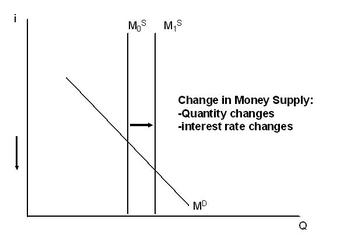
Relationship between money supply and interest rates
As money supply increases, the interest rate decreases, as depicted in the graph above.
The money supply is a monetary policy mechanism available to a central bank as part of its mandate to promote economic growth and maintain full employment. Central banks use monetary policy to stabilize the economy; during periods of economic slowing central banks initiate expansionary policy, whereby the bank increases the money supply in order to lower prevailing interest rates. As the cost of money falls the demand for funds increases, thereby expanding consumer and investment spending and promoting economic growth.
Expansionary policy
An active expansionary policy increases the size of the money supply, decreasing the interest rate. Central banks can increase the money supply through open market operations and changes in the reserve requirement.
Bank reserves
Banks and other depository institutions are required to keep a certain amount of funds in reserve in order to maintain enough liquidity to meet unexpected demand for deposits. Banks can keep these reserves as cash in their vaults or as deposits with the Federal Reserve (the Fed). By adjusting the reserve requirement, the Fed can effectively change the availability of loanable funds.
In an expansionary policy regime, the Fed would reduce the reserve requirement. Banks would be able to issue more loans with the same reserves, thereby increasing the supply of money and the level of economic activity and investment.
Federal Funds market
From day to day, the amount of reserves a bank wants to hold may change as its deposits and transactions change. When a bank needs additional reserves on a short-term basis, it can borrow them from other banks that happen to have more reserves than they need. These loans take place in a private financial market called the federal funds market.
The interest rate on the overnight borrowing of reserves is called the Federal Funds rate or simply the “fed funds rate.” It adjusts to balance the supply of and demand for reserves. For example, if the supply of reserves in the fed funds market is greater than the demand, then the funds rate falls, and if the supply of reserves is less than the demand, the funds rate rises.
At a lower fed funds rate, banks are more likely to increase loans, thereby expanding investment activity (in factories, for example, not financial instruments) and promoting economic growth.
Expansionary monetary policy will seek to reduce the fed funds target rate (a range). The Fed does not control this rate directly but does control the interest rate indirectly through open market operations.
Open market operations
The major tool the Fed uses to affect the supply of reserves in the banking system is open market operations—that is, the Fed buys and sells government securities on the open market. These operations are conducted by the Federal Reserve Bank of New York.
In an expansionary policy regime, the Fed purchases government securities from a bank in exchange for cash. Payment for the bonds increases the bank’s reserves. As a result, the bank may have more reserves than required. The bank can lend these unneeded reserves to another bank in the federal funds market. Thus, the Fed’s open market purchase increased the supply of reserves (money) to the banking system, and the federal funds rate (interest rate) falls.
28.2.7: Executing Restrictive Monetary Policy
The central bank may initiate a contractionary or restrictive monetary policy to slow growth.
Learning Objective
Explain common restrictive monetary policy tools
Key Points
- In a contractionary policy regime, the Fed may increase the reserve requirement, thereby effectively restricting the funds that banks have available for loans.
- Restrictive monetary policy will seek to increase the fed funds rate, which is the interest banks charge on loans to other banks.
- In a contractionary policy regime, the Fed uses open market operations to sell government securities from a bank in exchange for cash and thereby reduce the money supply and increase interest rates.
Key Term
- full employment
-
A state when an economy has no cyclical or deficient-demand unemployment.
Monetary policy is based on the relationship between money supply and interest rates, where the interest rate is the price of money. The interest rate, therefore, has an inverse relationship with the money supply. As a result, as the money supply in an economy is decreased, the interest rate is assumed to increase and if the money supply is increased, interest rates are typically assumed to decrease .
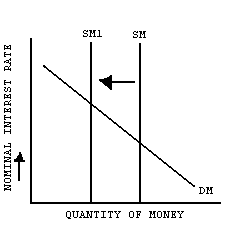
Contractionary monetary policy
Contractionary monetary policy results in a reduction in the money supply, depicted as a leftward shift, which results in an increase in interest rates as well as a decrease in the quantity of loanable funds.
The money supply is a monetary policy mechanism available to a central bank as part of its initiatives to promote economic growth and maintain full employment. Central banks use monetary policy to stabilize the economy; during periods of economic slowing central banks initiate expansionary policy, whereby the bank increases the money supply in order to lower prevailing interest rates. As the cost of money falls, economic theory assumes that the demand for funds will increase, thereby expanding consumer and investment spending and promoting economic growth. During periods where the economy is showing signs of growing too quickly or operating above full employment, the central bank may initiate a contractionary or restrictive monetary policy by reducing the money supply and allowing interest rates to increase and economic growth to slow.
Restrictive policy
An active contractionary policy restricts the size of the money supply, increasing the interest rate. Central banks can decrease the money supply through open market operations and changes in the reserve requirement.
Bank reserves
Banks and other depository institutions keep a certain amount of funds in reserve to meet unexpected outflows. Banks can keep these reserves as cash in their vaults or as deposits with the Fed. By adjusting the reserve requirement, the Fed can effectively change the availability of loanable funds.
In a contractionary policy regime, the Fed would increase the reserve requirement, thereby effectively restricting the funds that banks have available for loans.
Federal funds market
From day to day, the amount of reserves a bank wants to hold may change as its deposits and transactions change. When a bank needs additional reserves on a short-term basis, it can borrow them from other banks that happen to have more reserves than they need. These loans take place in a private financial market called the federal funds market.
The interest rate on the overnight borrowing of reserves is called the federal funds rate or simply the “funds rate.” It adjusts to balance the supply of and demand for reserves. For example, if the supply of reserves in the fed funds market is lower than the demand, then the funds rate increases.
At higher fed funds rates, banks are more likely to limit borrowing and their provision of loanable funds, thereby decreasing access to loanable funds and reducing economic growth.
Restrictive monetary policy will seek to increase the fed funds target rate. The Fed does not control this rate directly but does control the interest rate indirectly through open market operations.
Open market operations
The major tool the Fed uses to affect the supply of reserves in the banking system is open market operations—that is, the Fed buys and sells government securities on the open market. These operations are conducted by the Federal Reserve Bank of New York.
In a contractionary policy regime, the Fed sells government securities from a bank in exchange for cash. Payment for the bonds decreases the bank’s reserves, reducing the supply of funds that the bank has for loans. The Fed’s open market purchase decreases the supply of reserves (money) to the banking system, and the federal funds rate (interest rate) increases. In net, this reduces the financial resources available to stimulate growth and leads to a contraction in the economy.
28.2.8: The Taylor Rule
Taylor’s rule was designed to provide monetary policy guidance for how a central bank should set short-term interest rates.
Learning Objective
Explain the Taylor Rule and its use by central banks
Key Points
- The rule states that the real short-term interest rate (that is, the interest rate adjusted for inflation) should be determined according to three factors.
- The rule recommends a relatively high interest rate (contractionary monetary policy) when inflation is above its target or when the economy is above its full employment level.
- The rule recommends a relatively low interest rate (expansionary monetary policy) when inflation is below its target or when the economy is below its full employment level.
Key Term
- Taylor Rule
-
A way of determining the appropriate change in interest rates for a given change in inflation.
The Taylor rule is a formula developed by Stanford economist John Taylor. It was designed to provide monetary policy guidance for the Federal Reserve. The formula suggests short-term interest rates depending on changing economic conditions, in order to keep the economy stable in the short term, and minimize inflation over the long term.
The rule stipulates how much a central bank should change the nominal interest rate (real rate plus inflation) in response to changes in inflation, output, or other economic conditions. In particular, the rule stipulates that for each one-percent increase in inflation, the central bank should raise the nominal interest rate by more than one percentage point.

Professor John Taylor
Stanford University Professor John Taylor is the creator of the Taylor Rule, a monetary policy instrument developed to promote stable economic growth and limit short-run economic disruption related to inflation.
The factors that the Taylor rule suggests taking into account when setting inflation-adjusted short-term interest rates are:
- the level of actual inflation relative to the target,
- how far economic activity is above or below its “full employment” level, and
- what the level of the short-term interest rate is that would be consistent with full employment.
The Taylor rule advocates setting interest rates relatively high (contractionary policy) when inflation is high or when the employment rate exceeds the economy’s full employment level. Expansionary policies with low interest rates are recommended by the Taylor rule in times when the economy is slow (i.e. unemployment is high, or inflation is low).
The Taylor rule doesn’t always provide an easy answer. For example, in times of stagflation, inflation may be high while unemployment is also high. However, the Taylor rule can still provide a handy “rule of thumb” to policy makers on how to balance these conflicting issues when setting the interest rates.
The Taylor rule fairly accurately demonstrates how monetary policy has been conducted under recent leaders of the Federal Reserve, such as Volker and Greenspan. However, the Federal Reserve does not follow the Taylor rule as an explicit policy.
28.3: Impacts of Federal Reserve Policies
28.3.1: The Impact of Monetary Policy on Aggregate Demand, Prices, and Real GDP
Changes in a country’s money supply shifts the country’s aggregate demand curve.
Learning Objective
Recognize the impact of monetary policy on aggregate demand
Key Points
- Aggregate demand (AD) is the sum of consumer spending, government spending, investment, and net exports.
- The AD curve assumes that money supply is fixed.
- The decrease in the money supply is mirrored by an equal decrease in the nominal output, otherwise known as Gross Domestic Product (GDP).
- The decrease in the money supply will lead to a decrease in consumer spending. This decrease will shift the AD curve to the left.
- The increase in the money supply is mirrored by an equal increase in nominal output, or Gross Domestic Product (GDP).
- The increase in the money supply will lead to an increase in consumer spending. This increase will shift the AD curve to the right.
- Increased money supply causes reduction in interest rates and further spending and therefore an increase in AD.
Key Term
- aggregate demand
-
The the total demand for final goods and services in the economy at a given time and price level.
Aggregate demand (AD) is the total demand for final goods and services in the economy at a given time and price level. It is the combination of consumer spending, investments, government spending, and net exports within a given economic system (often written out as AD = C + I + G + nX). As a result of this, increases in overall capital within an economy impacts the aggregate spending and/or investment. This creates a relationship between monetary policy and aggregate demand.
This brings us to the aggregate demand curve. It specifies the amounts of goods and services that will be purchased at all possible price levels. This is the demand for the gross domestic product of a country. It is also referred to as the effective demand.
The aggregate demand curve illustrates the relationship between two factors – the quantity of output that is demanded and the aggregated price level. Another way of defining aggregate demand is as the sum of consumer spending, government spending, investment, and net exports. The aggregate demand curve assumes that money supply is fixed. Altering the money supply impacts where the aggregate demand curve is plotted.
Contractionary Monetary Policy
Contractionary monetary policy decreases the money supply in an economy . The decrease in the money supply is mirrored by an equal decrease in the nominal output, otherwise known as Gross Domestic Product (GDP). In addition, the decrease in the money supply will lead to a decrease in consumer spending. This decrease will shift the aggregate demand curve to the left. This reduction in money supply reduces price levels and real output, as there is less capital available in the economic system.

Aggregate Demand Graph
This graph shows the effect of expansionary monetary policy, which shifts aggregate demand (AD) to the right.
Expansionary Monetary Policy
Expansionary monetary policy increases the money supply in an economy. The increase in the money supply is mirrored by an equal increase in nominal output, or Gross Domestic Product (GDP). In addition, the increase in the money supply will lead to an increase in consumer spending. This increase will shift the aggregate demand curve to the right.
In addition, the increase in money supply would lead to movement up along the aggregate supply curve. This would lead to a higher prices and more potential real output.
28.3.2: The Effect of Expansionary Monetary Policy
An expansionary monetary policy is used to increase economic growth, and generally decreases unemployment and increases inflation.
Learning Objective
Analyze the effects of expansionary monetary policy
Key Points
- The primary means a central bank uses to implement an expansionary monetary policy is through purchasing government bonds on the open market.
- Another way to enact an expansionary monetary policy is to increase the amount of discount window lending.
- A third method of enacting a expansionary monetary policy is by decreasing the reserve requirement.
Key Terms
- unemployment
-
The state of being jobless and looking for work.
- expansionary monetary policy
-
Traditionally used to try to combat unemployment in a recession by lowering interest rates in the hope that easy credit will entice businesses into expanding.
Monetary policy is referred to as either being expansionary or contractionary. Expansionary policy seeks to accelerate economic growth, while contractionary policy seeks to restrict it. Expansionary policy is traditionally used to try to combat unemployment in a recession by lowering interest rates in the hope that easy credit will entice businesses into expanding. This is done by increasing the money supply available in the economy.
Expansionary policy attempts to promote aggregate demand growth. As you may remember, aggregate demand is the sum of private consumption, investment, government spending and imports. Monetary policy focuses on the first two elements. By increasing the amount of money in the economy, the central bank encourages private consumption. Increasing the money supply also decreases the interest rate, which encourages lending and investment. The increase in consumption and investment leads to a higher aggregate demand.
It is important for policymakers to make credible announcements. If private agents (consumers and firms) believe that policymakers are committed to growing the economy, the agents will anticipate future prices to be higher than they would be otherwise. The private agents will then adjust their long-term plans accordingly, such as by taking out loans to invest in their business. But if the agents believe that the central bank’s actions are short-term, they will not alter their actions and the effect of the expansionary policy will be minimized.
The Basic Mechanics of Expansionary Monetary Policy
A central bank can enact an expansionary monetary policy several ways. The primary means a central bank uses to implement an expansionary monetary policy is through open market operations. Commonly, the central bank will purchase government bonds, which puts downward pressure on interest rates. The purchases not only increase the money supply, but also, through their effect on interest rates, promote investment.
Because the banks and institutions that sold the central bank the debt have more cash, it is easier for them to make loans to its customers. As a result, the interest rate for loans decrease. Businesses then, presumably, use the money it borrowed to expand its operations. This leads to an increase in jobs to build the new facilities and to staff the new positions.
The increase in the money supply is inflationary, though it is important to note that, in practice, different monetary policy tools have different effects on the level of inflation.
Other Methods of Enacting Expansionary Monetary Policy
Another way to enact an expansionary monetary policy is to increase the amount of discount window lending. The discount window allows eligible institutions to borrow money from the central bank, usually on a short-term basis, to meet temporary shortages of liquidity caused by internal or external disruptions. Decreasing the rate charged at the discount window, the discount rate, will not only encourage more discount window lending, but will put downward pressure on other interest rates. Low interest rates encourage investment .
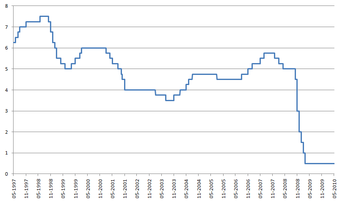
Bank of England Interest Rates
The Bank of England (the central bank in England) undertook expansionary monetary policy and lowered interest rates, promoting investment.
Another method of enacting a expansionary monetary policy is by decreasing the reserve requirement. All banks are required to have a certain amount of cash on hand to cover withdrawals and other liquidity demands. By decreasing the reserve requirement, more money is made available to the economy at large.
28.3.3: The Effect of Restrictive Monetary Policy
A restrictive monetary policy will generally increase unemployment and decrease inflation.
Learning Objective
Analyze the effects of restrictive monetary policy
Key Points
- Another way to enact a restrictive monetary policy is to decrease the amount of discount window lending.
- A final method of enacting a restrictive monetary policy is by increasing the reserve requirement.
- The primary means a central bank uses to implement an expansionary monetary policy is through open market operations. The central bank can issue or resell its debt in exchange for cash. It can also sell off some of its reserves in gold or foreign currencies.
Key Term
- contractionary monetary policy
-
Central bank actions designed to slow economic growth.
Monetary policy is can be classified as expansionary or restrictive (also called contractionary). Restrictive monetary policy expands the money supply more slowly than usual or even shrinks it, while and expansionary policy increases the money supply. It is intended to slow economic growth and/or inflation in order to avoid the resulting distortions and deterioration of asset values

Business cycle
Restrictive monetary policy is used during expansion and boom periods in the business cycle to prevent the overheating of the economy.
Contractionary policy attempts to slow aggregate demand growth. As you may remember, aggregate demand is the sum of private consumption, investment, government spending and imports. Monetary policy focuses on the first two elements. By decreasing the amount of money in the economy, the central bank discourages private consumption. Increasing the money supply also increase the interest rate, which discourages lending and investment. The higher interest rate also promotes saving, which further discourages private consumption. The decrease in consumption and investment leads to a decrease in growth in aggregate demand.
It is important for policymakers to make credible announcements. If private agents (consumers and firms) believe that policymakers are committed to limiting inflation through restrictive monetary policy, the agents will anticipate future prices to be lower than they would be otherwise. The private agents will then adjust their long-term strategies accordingly, such as by putting plans to expand their operations on hold. But if the agents believe that the central bank’s actions will soon be reversed, they may not alter their actions and the effect of the contractionary policy will be minimized.
The Basic Mechanics of Expansionary Monetary Policy
A central bank can enact a contractionary monetary policy several ways. The primary means a central bank uses to implement an expansionary monetary policy is through open market operations. The central bank can issue debt in exchange for cash. This results in less cash being in the economy.
Because the banks and institutions that purchased the debt from the central bank have less cash, it is harder for them to make loans to its customers. As a result, the interest rate for loans increase. Businesses then, presumably, have less money to use to expand its operations or even maintain its current levels. This could lead to an increase in unemployment.
The higher interest rates also can slow inflation. Consumption and investment are discouraged, and market actors will choose to save instead of circulating their money in the economy. Effectively, the money supply is smaller, and there is reduced upward pressure on prices since demand for consumption goods and services has dropped.
Other Methods of Enacting Restrictive Monetary Policy
Another way to enact a contractionary monetary policy is to decrease the amount of discount window lending. The discount window allows eligible institutions to borrow money from the central bank, usually on a short-term basis, to meet temporary shortages of liquidity caused by internal or external disruptions
A final method of enacting a contractionary monetary policy is by increasing the reserve requirement. All banks are required to have a certain amount of cash on hand to cover withdrawals and other liquidity demands. By increasing the reserve requirement, less money is made available to the economy at large.
28.3.4: Limitations of Monetary Policy
Limitations of monetary policy include liquidity traps, deflation, and being canceled out by other factors.
Learning Objective
Describe obstacles to the Federal Reserve’s monetary policy objectives
Key Points
- A liquidity trap is a situation where injections of cash into the private banking system by a central bank fail to lower interest rates and therefore fail to stimulate economic growth.
- Deflation is a decrease in the general price level of goods and services. Deflation is a problem in a modern economy because it increases the real value of debt and may aggravate recessions and lead to a deflationary spiral.
- Fiscal policy can also directly influence employment and economic growth. If these two policies do not work in concert, they can cancel each other out.
Key Term
- deflation
-
A decrease in the general price level, that is, in the nominal cost of goods and services.
Monetary policy is the process by which the monetary authority of a country controls the supply of money with the purpose of promoting stable employment, prices, and economic growth. Monetary policy can influence an economy but it cannot control it directly. There are limits as to what monetary policy can accomplish. Below are some of the factors that can make monetary policy less effective.
Multiple Factors Influencing Economy
While monetary policy can influence the elements listed above, it is not the only thing that does. Fiscal policy can also directly influence employment and economic growth. If these two policies do not work in concert, they can cancel each other out. This is an especially significant problem when fiscal policy and monetary policy are controlled by two different parties. One party might believe that the economy is teetering on recession and may pursue an expansionary policy. The other group may believe the economy is booming and pursue a contractionary policy. The result is that the two would cancel each other, so that neither would influence the direction of the economy.
Liquidity Trap
A liquidity trap is a situation where injections of cash into the private banking system by a central bank fail to lower interest rates and therefore fail to stimulate economic growth . Usually central banks try to lower interest rates by buying bonds with newly created cash. In a liquidity trap, bonds pay little to no interest, which makes them nearly equivalent to cash. Under the narrow version of Keynesian theory in which this arises, it is specified that monetary policy affects the economy only through its effect on interest rates. Thus, if an economy enters a liquidity trap, further increases in the money stock will fail to further lower interest rates and, therefore, fail to stimulate.

Liquidity Trap
Sometimes, when the money supply is increased, as shown by the Liquidity Preference-Money Supply (LM) curve shift, it has no impact on output (GDP or Y) or on interest rates. This is a liquidity trap.
A liquidity trap is caused when people hoard cash because they expect an adverse event such as deflation, insufficient aggregate demand, or war. Signature characteristics of a liquidity trap are short-term interest rates that are near zero and fluctuations in the monetary base that fail to translate into fluctuations in general price levels.
Deflation
Deflation is a decrease in the general price level of goods and services. Deflation occurs when the inflation rate falls below 0%. This should not be confused with disinflation, a slowdown in the inflation rate. Inflation reduces the real value of money over time; conversely, deflation increases the real value of money. This allows one to buy more goods with the same amount of money over time.
From a monetary policy perspective, deflation occurs when there is a reduction in the velocity of money and/or the amount of money supply per person. The velocity of money is the frequency at which one unit of currency is used to purchase domestically-produced goods and services within a given time period. In other words, it is the number of times one dollar is spent to buy goods and services per unit of time. If the velocity of money is increasing, then more transactions are occurring between individuals in an economy.
Deflation is a problem in a modern economy because it increases the real value of debt and may aggravate recessions and lead to a deflationary spiral. If monetary policy is too contractionary for too long, deflation could set in.
28.3.5: Using Monetary Policy to Target Inflation
Inflation targeting occurs when a central bank attempts to steer inflation towards a set number using monetary tools.
Learning Objective
Assess the use of inflation targets and goals in monetary policy
Key Points
- Because interest rates and the inflation rate tend to be inversely related, the likely moves of the central bank to raise or lower interest rates become more transparent under the policy of inflation targeting.
- If inflation appears to be above the target, the bank is likely to raise interest rates; if inflation appears to be below the target, the bank is likely to lower interest rates.
- Increases in inflation, measured by the consumer price index (CPI), are not necessarily coupled to any factor internal to country’s economy and strictly or blindly adjusting interest rates will potentially be ineffectual and restrict economic growth when it was not necessary to do so.
Key Term
- consumer price index
-
A statistical estimate of the level of prices of goods and services bought for consumption purposes by households.
Inflation targeting is an economic policy in which a central bank estimates and makes public a projected, or “target”, inflation rate and then attempts to steer actual inflation towards the target through the use of interest rate changes and other monetary tools .

Fed Reserve Seal
The United States Federal Reserve uses a form of inflation targeting when coordinating its monetary policy.
Because interest rates and the inflation rate tend to be inversely related, the likely moves of the central bank to raise or lower interest rates become more transparent under the policy of inflation targeting. Examples include:
- if inflation appears to be above the target, the bank is likely to raise interest rates. This usually has the effect over time of cooling the economy and bringing down inflation;
- if inflation appears to be below the target, the bank is likely to lower interest rates. This usually has the effect over time of accelerating the economy and raising inflation.
Under the policy, investors know what the central bank considers the target inflation rate to be and therefore may more easily factor in likely interest rate changes in their investment choices. This is viewed by inflation targeters as leading to increased economic stability.
The United States Federal Reserve, the country’s central bank, practices a version of inflation targeting. Instead of setting a specific number, the Fed sets a target range.
Criticisms of Inflation Targeting
Increases in inflation, measured by changes in the consumer price index (CPI), are not necessarily coupled to any factor internal to country’s economy. Strictly or blindly adjusting interest rates will potentially be ineffectual and restrict economic growth when it was not necessary to do so.
It has been argued that focusing on inflation may inhibit stable employment and exchange rates. Supporters of a nominal income target also criticize the tendency of inflation targeting to ignore output shocks by focusing solely on the price level. They argue that a nominal income target is a better goal.
28.4: Historical Federal Reserve Policies
28.4.1: Volcker Disinflation
Paul Volcker, the 12th Chairman of the Federal Reserve, became known for lowering the inflation rate and achieving price stability.
Learning Objective
Evaluate the benefits and consequences of Paul Volcker’s actions as chairman of the Federal Reserve Board of Governors
Key Points
- During his time as the chairman of the Fed, Volcker is credited with ending the high levels of inflation that the United States experienced during the 1970s and early 1980s.
- When he became chairman in 1979, inflation was high and peaked in 1981 at 13.5%. However, due to the work of Volcker and the rest of the board, the inflation rate dropped to 3.2% by 1983.
- Volcker raised the federal funds rate from 11.2% in 1979 to 20% in June of 1981. The unemployment rate became higher than 10% during this time as well.
- Volcker chose to enact a policy of preemptive restraint during the economic upturn which increased the real interest rates.
- Despite his level of success, Volcker’s Federal Reserve board drew some of the strongest political attacks and protests in the history of the Federal Reserve. The protests were a result of the negative effects that the high interest rates had on the construction and farming industries.
Key Terms
- stagflation
-
Inflation accompanied by stagnant growth, unemployment, or recession.
- inflation
-
An increase in the general level of prices or in the cost of living.
Paul Volcker
Paul Volcker is an American economist who was appointed by President Carter in 1979 to be the 12th Chairman of the Federal Reserve of the United States (the Fed). He was reappointed by President Reagan and served as chairman until August of 1987. During his time as the Chairman of the Fed, Volcker is credited with ending the high levels of inflation that the United States experienced during the 1970s and early 1980s . Volcker was also appointed as the chairman of the Economic Recovery Advisory Board under President Obama from 2009 to 2011.

Paul Volcker
Paul Volcker was the 12th Chairman of the Federal Reserves. He became known for decreasing inflation during the early 1980s.
Benefits During Volcker’s Tenure
During his time as chairman, Paul Volcker led the Federal Reserve board and helped to end the stagflation crisis of the 1970s. The inflation rate had remained high throughout the 1970s, while the growth rate was slow and the unemployment was high. When he became chairman in 1979, inflation was high and peaked in 1981 at 13.5%. However, due to the work of Volcker and the rest of the board, the inflation rate dropped to 3.2% by 1983.
Volcker raised the federal funds target rate from 11.2% in 1979 to 20% in June of 1981. The unemployment rate became higher than 10% during this time as well. The economy was restored by 1982 as a result of the tight-money policy put in place by the Fed. Volcker chose to enact a policy of preemptive restraint during the economic upturn which increased the real interest rates. Volcker’s policy also pushed the President and Congress to adopt a plan to balance the budget. Volcker’s tenure as the chairman of the Federal Reserve resulted in sound monetary and fiscal integrity that achieved the goal of price stability.
Consequences From Volcker’s Tenure
Despite his level of success in certain areas, Volcker’s Federal Reserve board drew some of the strongest political attacks and protests in the history of the Federal Reserve. The protests were a result of the negative effects that the high interest rates had on the construction and farming industries. Nobel laureate Joseph Stiglitz explained “Paul Volcker, the previous Fed Chairman known for keeping inflation under control, was fired because the Reagan Administration didn’t believe he was an adequate deregulator. “
Despite the protests, Paul Volcker was respected for the work that he did while he was the chairman of the Federal Reserve. Congressman Ron Paul was a harsh critic of the Fed, but he commented about Volcker by saying, “If I had to name a Federal Reserve chairman that did a little bit of good, that would be Paul Volcker. ” Volcker received the U.S. Senator John Heinz Award for Greatest Public Service by an elected or Appointed Official in 1983.
28.4.2: Greenspan Era
Alan Greenspan was Chairman of the Federal Reserve from 1987 to 2006.
Learning Objective
Summarize the actions taken during Alan Greenspan’s tenure as chairman of the Federal Reserve Board of Governors
Key Points
- In 1987, Greenspan stated that the Fed was ready “to serve as a source of liquidity to support the economic and financial system” following the stock market crash.
- Greenspan influenced each presidency during his tenure as chairman. He provided economic consultation for President Clinton and assisted in the deficit reduction program in 1993.
- He raised interest rates several times in 2000 which was likely this cause of the bursting of the dot-com bubble. In 2001, Greenspan began to lower interest rates. By 2004, the Federal Funds rate was 1%.
- In 2004, Greenspan urged homeowners to take out ARMS. Over the next two years, the interest rates increased to 5.25% which contributed to the mortgage crisis in 2007.
Key Term
- interest rate
-
The percentage of an amount of money charged for its use per some period of time (often a year).
Alan Greenspan
Alan Greenspan is an American economist who served as the Chairman of the Federal Reserve of the United States from 1987 to 2006. He had the second longest tenure in the position. He was appointed by Ronald Reagan in 1987 and reappointed in four-year intervals, finally retiring on January 31, 2006 .

Alan Greenspan
Alan Greenspan was the 13th Chairman of the Federal Reserve. He held the position from 1987 until 2006. His tenure as the chairman was marked by low interest rates which eventually were blamed for the 2007 mortgage crisis in the United States.
Chairman of the Federal Reserve
The stock market crashed in 1987 shortly after Greenspan became Chairman of the Federal Reserve (the Fed). He stated the the Fed was ready “to serve as a source of liquidity to support the economic and financial system. ” Throughout his early years as chairman, Greenspan impacted all the presidencies in various ways. President George H.W. Bush blamed federal policy when he was not reappointed for a second term.
During President Clinton’s terms in office, Greenspan was consulted regarding economic affairs and assisted in the 1993 deficit reduction program. As a whole, the 1990s saw healthy economic growth.
The most notable actions taken during Greenspan’s tenure as chairman began in 2000. He raised interest rates several times in 2000 which was likely this cause of the bursting of the dot-com bubble. In 2001, Greenspan and the Fed initiated a series of interest cuts that brought the Federal Funds rate down to 3% following the September 11, 2001 terror attacks. The Federal Funds rate continued to drop until it was 1% in 2004. Greenspan believed that a group in rates would lead to a surge in home sales and refinancing. In February of 2004, Greenspan suggested that homeowners should consider taking out adjustable-rate mortgages (ARMS) where the interest rate adjusts to the current interest rate in the market. A few months later, Greenspan began raising the interest rates. Interest rate funds increased to 5.25% about two years later.
The Housing Bubble
In 2007, only months after Greenspan retired, the subprime mortgage crisis occurred in the United States. It is suggested that Greenspan’s easy-money policies were the leading cause of the mortgage crisis. When homeowners took out subprime ARMS in 2004, the interest rates were set much higher than what the homeowners paid the first few years of the mortgages. In 2009, Robert Reich explained that the lower interest rates in 2004 allowed banks to borrow money for free. As a result, the banks borrowed large amounts of money, lent it out to borrowers, and earned substantial profits. Without government oversight for lending institutions, banks lent money to unfit borrowers. Greenspan did not think the oversight was necessary. He trusted that the market would weed out bad credit risks, but it did not. In 2008, Greenspan admitted during Congressional testimony that he had put too much faith in the self-correcting power of free markets. He had not anticipated the self-destructive power of irresponsible mortgage lending. Greenspan did not accept responsibility for creating the housing bubble that led to the mortgage crisis. He simply stated that he did not believe in deregulation as strongly following the crisis.
28.4.3: Bernanke Era
The Bernanke Era has included challenges faced by the Federal Reserve such as the financial crisis, strengthening federal policy, and reducing the deficit.
Learning Objective
Review the challenges faced by Ben Bernanke during his time as chairman of the Federal Reserve Board of Governors
Key Points
- During his tenure as chairman, Bernanke has been responsible for overseeing the Federal Reserve’s response to the financial crisis.
- Ben Bernanke was one of the first individuals to discuss “the Great Moderation” which is the theory that traditional business cycles have declined in volatility in recent decades because of structural changes that have occurred in the international economy.
- The financial crisis in the later-2000s brought the period of the Great Moderation to an end.
- The main controversies surrounding Bernanke’s terms as chairman include how he handled the financial crisis, particularly failing to see the crisis, for bailing out Wall Street, and for injecting $600 billion into the banking system to give the slow economic recovery a boost.
- Bernanke also focused on the importance of reducing the deficit and reforming entitlement programs in order to achieve financial stability and economic growth.
Key Terms
- deflation
-
A decrease in the general price level, that is, in the nominal cost of goods and services.
- inflation
-
An increase in the general level of prices or in the cost of living.
- financial crisis
-
A period of serious economic slowdown characterized by devaluing of financial institutions often due to reckless and unsustainable money lending.
Ben Bernanke
Ben Bernanke is an American economist and chairman of the Federal Reserve (the Fed) through January 2014. He was appointed chairman by President Bush and reappointed by President Obama. During his tenure as chairman, Bernanke has been responsible for overseeing the Federal Reserve’s response to the financial crisis .
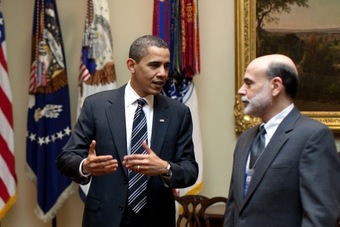
Ben Bernanke
Ben Bernanke (right) was appointed chairman of the Federal Reserve by President Bush and he was reappointed by President Obama. Throughout his time as chairman, Bernanke has influenced the financial crisis, the Wall Street bailout, and the economic stimulus.
The Great Moderation
Ben Bernanke was one of the first individuals to discuss “the Great Moderation” which is the theory that traditional business cycles have declined in volatility in recent decades because of structural changes that have occurred in the international economy. The primary structural changes include increases in the economic stability of developing nations and the diminished influence of monetary and fiscal policy.
The Great Moderation is important because while Bernanke was chairman of the Federal Reserve, it is speculated the the economic and financial crisis in the later-2000s brought the period of the Great Moderation to an end. The period was known for predictable policy, low inflation, and modest business cycles.
The Bernanke Doctrine
Ben Bernanke gave a speech in 2002, before he became chairman of the Federal Reserve. He emphasized that Congress gave the Fed responsibility for preserving price stability – avoiding inflation and deflation. He also identified seven specific measures for the Fed to reduced deflation. These seven measures were:
- Increase the money supply
- Ensure liquidity makes its way into the financial system
- Lower interest rates all the way down to 0%
- Control the yield on corporate bonds and other privately issued securities
- Depreciate the U.S. dollar
- Execute a de facto depreciation
- Buy industries throughout the U.S. economy with “newly created money”
Chairman of the Federal Reserve
As Chairman of the Federal Reserve, Bernanke sits on the Financial Stability Oversight Board and is also Chairman of the Federal Open Market Committee, the Fed’s principal monetary policy making body. One of Bernanke’s first main challenges was balancing his comments and how they were influenced by the media. As an advocate for more transparent federal policy, Bernanke stated clearer inflation goals, but his public statements negatively impacted the stock market. As a result, he did not continue to make public statements about the direction of the Federal Reserve.
The main controversies surrounding Bernanke’s terms as chairman include how he handled the financial crisis, particularly failing to see the crisis, for bailing out Wall Street, and for injecting $600 billion into the banking system to give the slow economic recovery a boost.
Two areas that received prominent attention include:
- The Merrill Lynch merger with Bank of America: New York state Attorney General Andrew Cuomo wrote a letter to Congress in 2009 accusing Bernanke and the treasury secretary of fraud concerning the acquisition of Merrill Lynch by Bank of America. Cuomo stated that the extent of Merrill Lynch’s losses were not disclosed to Bank of America by Bernanke or the treasury secretary. Bernanke was questioned in Congressional hearings as to whether he bullied individuals when the merger was invoked. Bernanke stated that the Fed did nothing illegal when they tried to convince Bank of America to not end the merger.
- AIG bailout: It was stated that Bernanke had overruled recommendations from his staff regarding the AIG bailout. The question arose as to whether it had been necessary to bailout AIG. Senators from both parties supported Bernanke and said that the AIG bailout averted worse problems. They stated that act of averting worse problems outweighed any responsibility that he had for the financial crisis.
In 2010, Bernanke also expressed his views regarding deficit reduction and reforming Social Security/Medicare. He favored reducing the U.S. budget deficit. He stated that reforming Social Security and Medicare entitlement programs would help reduce the deficit. He believed that a credible plan needed to be developed in order to address the funding crisis that is pending. He explained that without reform, the U.S. will not have financial stability or healthy economic growth. His comments were directed at Congress and the President since reform in fiscal exercise is not in the power of the Federal Reserve. He emphasized that deficit reduction would need to consist of raising taxes, cutting entitlement payments, and reducing government spending.
Chapter 27: The Monetary System
27.1: Introducing Money
27.1.1: The Definition of Money
Money is any object that is generally accepted as payment for goods and services and the repayment of debt.
Learning Objective
Distinguish between the three main functions of money: a medium of exchange, a unit of account, and a store of value
Key Points
- Money comes in three forms: commodity money, fiat money, and fiduciary money. Most modern monetary systems are based on fiat money.
- Commodity money derives its value from the commodity of which it is made, while fiat money has value only by the order of the government.
- Money functions as a medium of exchange, a unit of account, and a store of value.
Key Term
- Fiat money
-
Money that is given value because those who use it believe it has value; the value is not derived from any inherent characteristic.
Money is any object that is generally accepted as payment for goods and services and repayment of debts in a given socioeconomic context or country. Money comes in three forms: commodity money, fiat money, and fiduciary money.
Many items have been historically used as commodity money, including naturally scarce precious metals, conch shells, barley beads, and other things that were considered to have value . The value of commodity money comes from the commodity out of which it is made. The commodity itself constitutes the money, and the money is the commodity.

Commodity Money
Conch shells have been used as commodity money in the past. The value of commodity money is derived from the commodity out of which it is made.
Fiat money is money whose value is not derived from any intrinsic value or guarantee that it can be converted into a valuable commodity (such as gold). Instead, it has value only by government order (fiat). Usually, the government declares the fiat currency to be legal tender, making it unlawful to not accept the fiat currency as a means of repayment for all debts. Paper money is an example of fiat money.
Fiduciary money includes demand deposits (such as checking accounts) of banks. Fiduciary money is accepted on the basis of the trust its issuer (the bank) commands.
Most modern monetary systems are based on fiat money. However, for most of history, almost all money was commodity money, such as gold and silver coins.
Functions of Money
Money has three primary functions. It is a medium of exchange, a unit of account, and a store of value:
- Medium of Exchange: When money is used to intermediate the exchange of goods and services, it is performing a function as a medium of exchange.
- Unit of Account: It is a standard numerical unit of measurement of market value of goods, services, and other transactions. It is a standard of relative worth and deferred payment, and as such is a necessary prerequisite for the formulation of commercial agreements that involve debt. To function as a unit of account, money must be divisible into smaller units without loss of value, fungible (one unit or piece must be perceived as equivalent to any other), and a specific weight or size to be verifiably countable.
- Store of Value: To act as a store of value, money must be reliably saved, stored, and retrieved. It must be predictably usable as a medium of exchange when it is retrieved. Additionally, the value of money must remain stable over time.
Economists sometimes note additional functions of money, such as that of a standard of deferred payment and that of a measure of value. A “standard of deferred payment” is an acceptable way to settle a debt–a unit in which debts are denominated. The status of money as legal tender means that money can be used for the discharge of debts. Money can also act a as a standard measure and common denomination of trade. It is thus a basis for quoting and bargaining prices. Its most important usage is as a method for comparing the values of dissimilar objects.
27.1.2: The Functions of Money
The monetary economy is a significant improvement over the barter system, in which goods were exchanged directly for other goods.
Learning Objective
Analyze how the characteristics of money make it an effective medium of exchange
Key Points
- The barter system has a number of limitations, including the double coincidence of wants, the absence of a common measure of value, indivisibility of certain goods, difficulty of deferred payments, and difficulty of storing wealth.
- Despite the numerous limitations, the barter system works well when currency is unstable or unavailable for conducting commerce.
- Money is durable, divisible, portable, liquid, and resistant to counterfeiting.
- Money serves as a medium of exchange, a unit of account, a store of value, and a standard of deferred payment.
Key Term
- barter
-
An exchange goods or services without involving money.
Barter is a system of exchange in which goods or services are directly exchanged for other goods or services without using a medium of exchange, such as money . The reciprocal exchange is immediate and not delayed in time. It is usually bilateral, though it can be multilateral, and usually exists parallel to monetary systems in most developed countries, though to a very limited extent. The barter system has a number of limitations which make transactions very inefficient, including:

Barter
In a barter system, individuals possessing something of value could exchange it for something else of similar or greater value.
- Double coincidence of wants: The needs of a seller of a commodity must match the needs of a buyer. If they do not, the transaction will not occur.
- Absence of common measure of value: In a monetary economy, money plays the role of a measure of value of all goods, making it possible to measure the values of goods against each other. This is not possible in a barter economy.
- Indivisibility of certain goods: If a person wants to buy a certain amount of another’s goods, but only has payment of one indivisible good which is worth more than what the person wants to obtain, a barter transaction cannot occur.
- Difficulty of deferred payments: It is impossible to make payments in installments and difficult to make payments at a later point in time.
- Difficulty storing wealth: If society relies exclusively on perishable goods, storing wealth for the future may be impractical.
Despite the long list of limitations, the barter system has some advantages. It can replace money as the method of exchange in times of monetary crisis, such as when a the currency is either unstable (e.g. hyperinflation or deflationary spiral) or simply unavailable for conducting commerce. It can also be useful when there is little information about the credit worthiness of trade partners or when there is a lack of trust.
The money system is a significant improvement over the barter system. It provides a way to quantify the value of goods and communicate it to others. Money has several defining characteristics. It is:
- Durable.
- Divisible.
- Portable.
- Liquid.
- A unit of account.
- Legal tender.
- Resistant to counterfeiting.
Money serves four primary purposes. It is:
- A medium of exchange: an object that is generally accepted as a form of payment.
- A unit of account: a means of keeping track of how much something is worth.
- A store of value: it can be held and exchanged later for goods and services at an approximate value.
- A standard of deferred payments (this is not considered a defining purpose of money by all economists).
The use of money as a medium of exchange has removed the major difficulty of double coincidence of wants in the barter system. It separates the act of sale and purchase of goods and services and helps both parties in obtaining maximum satisfaction and profits independently.
27.1.3: Measuring the Money Supply: M1
M1 captures the most liquid components of the money supply, including currency held by the public and checkable deposits in banks.
Learning Objective
Define M1
Key Points
- The Federal Reserve measures the money supply using three monetary aggregates: M1, M2, and M3.
- M1 is the narrowest measure of the money supply, including only money that can be spent directly.
- M2 is a broader measure, encompassing M1 and near monies.
- M3 includes M2 plus relatively less liquid near monies. However, this measure is no longer used in practice.
Key Term
- M1
-
The amount of cash in circulation plus the amount in bank checking accounts.
The Federal Reserve measures the money supply using three main monetary aggregates: M1, M2, and M3.
M1 is the narrowest measure of the money supply, including only money that can be spent directly. More specifically, M1 includes currency and all checkable deposits . Currency refers to the coins and paper money in the hands of the public. Checkable deposits refer to all spendable deposits in commercial banks and thrifts.
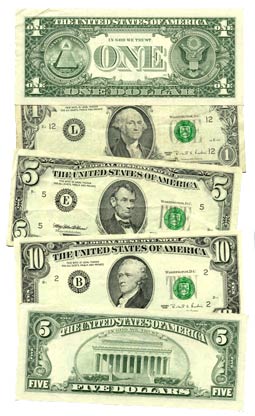
M1
The M1 measure includes currency in the hands of the public and checkable deposits in commercial banks.
A broader measure of money than M1 includes not only all of the spendable balances in M1, but certain additional assets termed “near monies”. Near monies cannot be spent as readily as currency or checking account money, but they can be turned into spendable balances with very little effort or cost. Near monies include what is in savings accounts and money-market mutual funds. The broader category of money that embraces all of these assets is called M2. M3 encompassed M2 plus relatively less liquid near monies. In practice, the measure of M3 is no longer used by the Federal Reserve.
Imagine that Laura deposits $900 in her checking account in a world with no other money (M1=$900). The bank sets 10% of the amount aside for required reserves, while the remaining $810 can be lent out by the bank as credit. The M1 money supply increases by $810 when the loan is made (M1=$1,710). In the meantime, Laura writes a check for $400. The total M1 money supply didn’t change; it includes the $400 check and the $500 left in the checking account (M1=$1,710). Laura’s check is accidentally destroyed in the laundry. M1 and her checking account do not change, because the check is never cashed (M1=$1,710). Meanwhile, the bank lends Mandy the $810 credit that it has created. Mandy deposits the money in a checking account at another bank. The bank must keep 10% as reserves and has $729 available for loans. This creates promise-to-pay money from a previous promise-to-pay, inflating the M1 money supply (M1=$2,439). Mandy’s bank now lends the money to someone else who deposits it in a checking account at another bank, and the process repeats itself.
27.1.4: Measuring the Money Supply: M2
M2 is a broader measure of the money supply than M1, including all M1 monies and those that could be quickly converted to liquid forms.
Learning Objective
Define M2
Key Points
- M2 consists of all the components of M1 plus near-monies.
- Near monies are relatively-liquid financial assets that can be quickly converted into M1 money.
- Near monies include savings deposits, small time deposits, and money market mutual funds.
Key Term
- M2
-
The amount of cash in circulation plus bank accounts, savings accounts and small deposits.
There is no single “correct” measure of the money supply. Instead there are several measures, classified along a continuum between narrow and broad monetary aggregates. Narrow measures include only the most liquid assets, the ones most easily used to spend (for example, currency and checkable deposits). Broader measures add less liquid types of assets (certificates of deposit, etc.). The continuum corresponds to the way that different types of money are more or less controlled by monetary policy. Narrow measures include those more directly affected and controlled by monetary policy, whereas broader measures are less closely related to monetary policy actions.
The different types of money are typically classified as “M”s. Around the world, they range from M0 (the narrowest) to M3 (broadest), but which of the measures is actually the focus of policy formulation depends on a country’s central bank.
M2 is one of the aggregates by which the Federal Reserve measures the money supply . It is a broader classification of money than M1 and a key economic indicator used to forecast inflation. M2 consists of all the liquid components of M1 plus near-monies. Near monies are relatively liquid financial assets that may be readily converted into M1 money. More specifically, near monies include savings deposits, small time deposits (less than $100,000) that become readily available at maturity, and money market mutual funds.
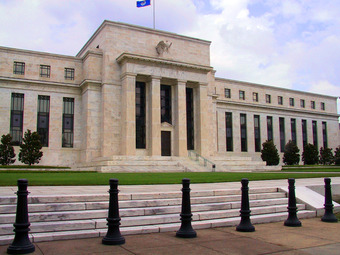
Federal Reserve
Historically, the Federal Reserve has measured the money supply using the aggregates of M1, M2, and M3. The M2 aggregate includes M1 plus near-monies.
Imagine that Laura writes a check for $1,000 and brings it to the bank to start a money market account. This would cause M1 to decrease by $1,000, but M2 to stay the same. This is because M2 includes the money market account in addition to all the money counted in M1.
27.1.5: Other Measurements of the Money Supply
In addition to the commonly used M1 and M2 aggregates, several other measures of the money supply are used as well.
Learning Objective
Explain how the money supply is measured
Key Points
- M0 is a measure of all the physical currency and coinage in circulation in an economy.
- MB is a measure that captures all physical currency, coinage, and Federal Reserve deposits (special deposits that only banks can have at the Fed).
- The different forms of money in the government money supply statistics arise from the practice of fractional-reserve banking. Whenever a bank gives out a loan in a fractional-reserve banking system, a new sum of money is created, which makes up the non-M0 components in the M1-M3 statistics.
Key Terms
- M0
-
The amount of coin and banknotes in circulation.
- MB
-
The portion of the commercial banks’ reserves that is maintained in accounts with their central bank plus the total currency circulating in the public.
In addition to the commonly used M1 and M2 aggregates, there are several other measurements of the money supply that are used as well . More specifically:
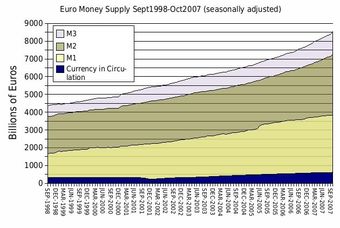
Euro Money Supply
The measures of the money supply are all related, but the use of different measures may lead economists to different conclusions.
- M0: The total of all physical currency including coinage. M0 = Federal Reserve Notes + US Notes + Coins .
- MB: Stands for “monetary base,” referring to the base from which all other forms of money are created. MB is the total of all physical currency plus Federal Reserve Deposits (special deposits that only banks can have at the Fed). MB = Coins + US Notes + Federal Reserve Notes + Federal Reserve Deposits.
- M1: The total amount of M0 (cash/coin) outside of the private banking system plus the amount of demand deposits, travelers checks and other checkable deposits.
- M2: M1 + most savings accounts, money market accounts, retail money market mutual funds, and small denomination time deposits (certificates of deposit of under $100,000).
- M3: M2 + all other certificates of deposit (large time deposits, institutional money market mutual fund balances), deposits of eurodollars and repurchase agreements.
- M4-: M3 + commercial paper.
- M4: M4- + treasury bills (or M3 + commercial paper + T-bills)
- MZM: “Money Zero Maturity” is one of the most popular aggregates in use by the Fed because its velocity has historically been the most accurate predictor of inflation. It is M2 – time deposits + money market funds.
- L: The broadest measure of liquidity that the Federal Reserve no longer tracks. M4 + Bankers’ Acceptance.
The different forms of money in the government money supply statistics arise from the practice of fractional-reserve banking. Fractional-reserve banking is the practice whereby a bank retains only a portion of its customers’ deposits as readily available reserves from which to satisfy demands for withdrawals. Whenever a bank gives out a loan in a fractional-reserve banking system, a new sum of money is created. This new type of money is what makes up the non-M0 components in the M1-M3 statistics.
27.2: Introducing the Federal Reserve
27.2.1: Introduction to Monetary Policy
Monetary policy is the process by which a monetary authority controls the money supply, often to produce stable prices and low unemployment.
Learning Objective
Justify expansionary and contractionary monetary policy.
Key Points
- Monetary policy is referred to as either being expansionary or contractionary, where an expansionary policy increases the money supply more rapidly than usual, and contractionary policy expands the money supply more slowly than usual.
- Expansionary policy is traditionally used to try to combat unemployment by lowering interest rates. A monetary authority will typically pursue expansionary monetary policy when there is an output gap.
- Contractionary policy is intended to slow inflation in order to avoid the resulting distortions and deterioration of asset values.
Key Terms
- inflation
-
An increase in the general level of prices or in the cost of living.
- output gap
-
The difference between an economy’s actual GDP and its long-run potential GDP
Monetary policy is the process by which the monetary authority of a country, which could be a government agency or a central bank, controls the supply of money, often targeting a rate of interest for the purpose of promoting economic growth and stability. The official goals usually include relatively stable prices and low unemployment.
Monetary policy is referred to as either being expansionary or contractionary, where an expansionary policy increases the total supply of money in the economy more rapidly than usual, and contractionary policy expands the money supply more slowly than usual or even shrinks it. Expansionary policy is traditionally used to try to combat unemployment in a recession by easing credit to entice businesses into expanding. Contractionary policy is intended to slow inflation in order to avoid the resulting distortions and deterioration of asset values, or to cool an overheating economy. Monetary policy differs from fiscal policy, which refers to taxation, government spending, and associated borrowing.
Expansionary Monetary Policy
A monetary authority will typically pursue expansionary monetary policy when there is an output gap – that is, a country is producing output at a lower level than its potential output. Without a policy intervention the output gap may correct itself, if falling wages and prices shift the short-run aggregate supply curve to the right until the economy returns to the long-run equilibrium. Alternatively, the monetary authority could intervene in order to increase aggregate demand and close the output gap. Expansionary monetary policy consists of the tools that a central bank uses to achieve this increase in aggregate demand.
In practice, this means that a monetary authority will use the tools at its disposal in order to increase the money supply and decrease interest rates. Since interest rates represent the price of money, lower interest rates will cause the quantity of money demanded to increase, stimulating investment and spending. In addition, lower interest rates make a currency worth less in the currency exchange market. This reduces the demand for and increases the supply of dollars in the currency market, reducing the exchange rate (in foreign currency per dollar). A lower exchange rate makes a country’s goods relatively more affordable for the rest of the world, stimulating exports and further increasing output.
Contractionary Monetary Policy
By contrast, a monetary authority will pursue a contractionary monetary policy when it considers inflation a threat. Suppose, for example, that high short-run aggregate demand creates an equilibrium in which prices are higher than in the long-run equilibrium. This will cause high levels of inflation. In response, the monetary authority may reduce the money supply and thereby raise the interest rate. Investment falls as the interest rate rises. The higher interest rate also increases the demand for dollars as foreign investors shift their investments to the United States. Likewise, the supply of dollars declines. Consumers in the United States purchase domestic interest-bearing assets rather than purchasing assets abroad, taking advantage of the higher domestic interest rate. Increased demand and decreased supply cause an increase in the exchange rate, which boots imports while reducing exports. Thus, contractionary monetary policy causes aggregate demand to fall, thereby reducing the rate of inflation. .
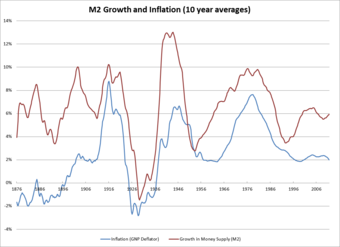
Money Supply and Inflation
The graph shows the relationship between the money supply and the inflation rate. By controlling the money supply, monetary authorities hope to influence the rate of inflation.
27.2.2: The Creation of the Federal Reserve
The Federal Reserve was created to promote financial stability, provide regulation and banking services, and conduct monetary policy.
Learning Objective
Explain monetary policy as the main function of a central bank
Key Points
- The Federal Reserve (the Fed) was originally created in response to a series of bank panics. While its policy goals were originally unclear, today the Fed has a dual mandate: to achieve maximum employment and stable prices.
- The Fed has three main policy tools: setting reserve requirements, operating the discount window and other credit facilities, and conducting open-market operations.
- The Fed sets the required ratio of reserves that banks must hold relative to their deposit liabilities.
- The discount rate is the interest rate charged by the Fed when it lends reserves to banks.
- The buying and selling of federal government bonds by the Fed are called open-market operations.
Key Terms
- central bank
-
The principal monetary authority of a country or monetary union; it normally regulates the supply of money, issues currency and controls interest rates.
- reserve requirement
-
The minimum amount of deposits each commercial bank must hold (rather than lend out).
The Federal Reserve Act of 1913
Until 1913, the United States did not have a true central bank. The US suffered through a number of financial crises that eventually drove Congress to create the US central bank, the Federal Reserve (the Fed), through the Federal Reserve Act of 1913.
The Act established three key objectives for monetary policy: maximum employment, stable prices, and moderate long-term interest rates. The first two objectives are sometimes referred to as the Federal Reserve’s dual mandate and are the most emphasized of the three.
Over the years, the Fed has expanded its duties to include conducting monetary policy, supervising and regulating banking institutions, maintaining the stability of the financial system, and providing financial services.
How the Fed Conducts Monetary Policy
The Fed has three main policy tools: setting reserve requirements, operating the discount window and other credit facilities, and conducting open-market operations.
Reserve Requirements
Commercial banks are required to hold a certain proportion of their deposits in reserves and not lend them out. This proportion is called the reserve requirement and is controlled by the Fed. By changing the reserve requirement, the Fed can impact the amount of money available for lending, and by extension, spending and investment.
Discount Window
Commercial banks are required to have a certain amount of reserves on hand at the end of each day. If they are going to come up short, they must borrow from other banks or the Fed. The Fed extends these loans through the discount window and charges what is called the discount rate. The discount rate is set by the Fed, and is important because it radiates throughout the economy: if it becomes more expensive to borrow at the discount window, interest rates will rise and borrowing will become more expensive economy-wide. In this way, the Fed can use the discount window to affect interest rates and the money supply .
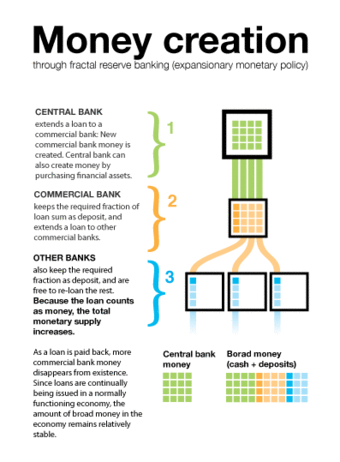
Increasing the Money Supply
The diagram shows how the central bank can increase the money supply by lending money through the discount window or purchasing bonds (open market operations).
Open-Market Operations
The government borrows by issuing bonds. Recall that the interest rate that the government pays is determined by the price of the bond: the higher the price of the bond, the lower the interest rate. The Fed can affect the interest rate by conducting open-market operations (OMOs) in which it buys or sells bonds. Buying or selling bonds changes the demand or supply of the bonds, and therefore their price. By extension, OMOs change the interest rate, hopefully to achieve one of the Fed’s monetary goals.
27.2.3: Structure of the Federal Reserve
The Federal Reserve System (The Fed) was designed in order to maintain the central bank’s independence and promote decentralized power.
Learning Objective
Recall the structure of the Federal Reserve System of the United States
Key Points
- The Fed is a system of 12 regional banks, each of which has its own board of directors and rotating representative to the Federal Open Market Committee (FOMC).
- The Fed is run by a Board of Governors, the head of which is the Chairperson.
- The Federal Open Market Committee (FOMC) consists of the seven members of the Board of Governors and five rotating regional bank presidents. It is primarily responsible for buying and selling federal government bonds in order to conduct monetary policy.
Key Terms
- monetary policy
-
The process by which the central bank, or monetary authority manages the supply of money, or trading in foreign exchange markets.
- open market operations
-
An activity by a central bank to buy or sell government bonds on the open market. A central bank uses them as the primary means of implementing monetary policy.
The Federal Reserve (the Fed) was designed to be independent of the Congress and the government. The idea justification for independence is that it allows the Fed to operate without being put under political pressure to take actions that may not be in the best long-term economic interest of the country.
The Federal Reserve System is composed of five parts :
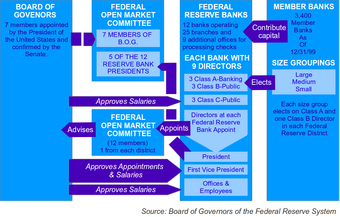
Structure of the Federal Reserve
The diagram shows the relationship between the different organizations that compose the Federal Reserve System
- The presidentially appointed Board of Governors (or Federal Reserve Board), an independent federal government agency located in Washington, D.C. Each governor serves a 14 year term. As of February 2014, the Chair of the Board of Governors is Janet Yellen, who succeeded Ben Bernanke.
- The Federal Open Market Committee (FOMC), composed of the seven members of the Federal Reserve Board and five of the 12 Federal Reserve Bank presidents, which oversees open market operations, the principal tool of U.S. monetary policy.
- Twelve regional Federal Reserve Banks located in major cities throughout the nation, which divide the nation into twelve Federal Reserve districts. The Federal Reserve Banks act as fiscal agents for the U.S. Treasury, and each has its own nine-member board of directors.
- Numerous other private U.S. member banks, which own required amounts of non-transferable stock in their regional Federal Reserve Banks.
- Various advisory councils.
The Fed can be thought of as having both private and public organization characteristics, though it considers itself to be private. On one hand, the Fed works toward achieving public goals such as moderate inflation and low unemployment. It does not exist to make money. On the other hand, it is, by design, separate from the government. It operates independently, and is not subject to political pressures directly as is Congress or the President.
27.2.4: The Federal Open Market Committee and the Role of the Fed
The Federal Open Market Committee is responsible for conducting open market operations in order to achieve a target interest rate.
Learning Objective
Describe the structure and operations of the Federal Open Market Committee (FOMC)
Key Points
- Open market operations are the buying and selling of federal government bonds in order to influence the money supply and interest rate.
- The Fed sets targets for the federal funds rate and then conducts operations to maintain that rate. To achieve a lower federal funds rate, for example, the Fed goes into the open market to buy securities and thus increase the money supply.
- The FOMC decides on a target federal funds rate by looking at monetary targets such as inflation, interest rates, or exchange rates.
Key Terms
- reserve
-
Banks’ holdings of deposits in accounts with their central bank.
- federal funds rate
-
The interest rate at which depository institutions actively trade balances held at the Federal Reserve with each other.
One of the primary tools used by the Federal Reserve (the Fed) to conduct monetary policy is open market operations: the buying and selling of federal government bonds in order to influence the money supply and interest rate. These operations are the primary responsibility of the Federal Open Market Committee (FOMC). The FOMC is a twelve-person committee composed of the seven members of the Board of Governors, plus a rotating combination of five presidents of the Federal Reserve Regional Banks. The president of the New York regional bank is always a member of the FOMC; the other four seats are filled by four of the other eleven bank presidents.
When conducting monetary policy the Fed sets a target for the federal funds rate, which it attempts to achieve using open market operations. To lower the federal funds rate, for example, the Fed buys securities on the open market, increasing the money supply. In order to raise the federal funds rate, on the other hand, the Fed sells securities and thereby reduces the money supply.
Open Market Operations
As mentioned previously, the aim of open market operations is to manipulate the short term interest rate and the total money supply. This involves meeting the demand for money at the target interest rate by buying and selling government securities or other financial instruments. Monetary targets, such as inflation, interest rates, or exchange rates, are used to guide this implementation.
Imagine the Fed is targeting a federal funds rate of 3%. If there is an increased demand for money and the Fed takes no action, interest rates will rise. This may produce unintended contractionary effects in the economy. Instead, the FOMC responds to an increase in the demand for money by going to the open market to buy a financial asset, such as government bonds, foreign currency, or gold. To pay for these assets, the Fed transfers bank reserves to the seller’s bank and the seller’s account is credited. Since the bank now has more reserves than it had before, it can lend out more money and the money supply increases. Thus, the increase in demand for money is met with an increase in supply, and the interest rate remains unchanged.
Conversely, if the central bank sells its financial assets on the open market, reserves are transferred from the buyer’s bank back to the Fed. This reduces the amount of money that a bank may loan out and the total money supply falls. The process works because the central bank has the authority to bring money in and out of existence. They are the only point in the whole system with the unlimited ability to produce money.
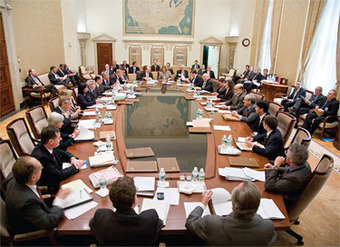
FOMC Meeting
The members of the FOMC meet eight times a year in order to vote on current monetary policies.
27.2.5: The Federal Reserve and the Financial Crisis of 2008
The Fed responded to the financial crisis with conventional open market operations and unconventional credit facilities and bailouts.
Learning Objective
Summarize the monetary policy tools used by the Federal Reserve in response to the financial crisis of 2008.
Key Points
- In late 2007, the bursting of the U.S. housing bubble triggered the worst financial crisis since the Great Depression of the 1930s.
- The Fed cut the target federal funds rate and the discount lending rate seven times. Normally, a low federal funds rate would encourage banks to make loans, stimulating the economy, but this failed to work following the crisis.
- Unable to rely on conventional tools, the Fed created a variety of credit facilities to provide liquidity to the economy.
- The Fed also provided emergency funds to support financial institutions deemed “too big to fail”.
Key Terms
- liquidity
-
The degree to which an asset can be easily converted into cash.
- discount rate
-
An interest rate that a central bank charges to depository institutions that borrow reserves from it.
- open market operations
-
An activity by a central bank to buy or sell government bonds on the open market. A central bank uses them as the primary means of implementing monetary policy.
In late 2007, the bursting of the U.S. housing bubble triggered the worst financial crisis since the Great Depression of the 1930s. It resulted in the threat of total collapse of large financial institutions, the bailout of banks by national governments, and downturns in stock markets around the world. The crisis caused the failure of businesses, huge declines in consumer wealth, and a downturn in economic activity that lead to the 2008-2012 global recession.
The Federal Reserve’s response to the 2008 crisis saw the use of both conventional and new monetary tools in order to stabilize the economy, support market liquidity, and encourage economic activity. Conventional monetary policy suggests that in an economic downturn, a central bank should conduct open market operations in order to increase the money supply and lower interest rates. Lower interest rates stimulate loans, spending, and investment and help an economy escape from recession. Further, this type of financial crisis meant that banks’ assets were suddenly worth far less; open market operations can ensure that these banks have the liquidity they need to carry out their financial activities.
Conventional Monetary Tools
The Federal Reserve (the Fed) did engage in these types of conventional operations in 2007 and 2008, cutting the target federal funds rate and the discount rate seven times. Normally, a low federal funds rate would encourage banks to borrow money in order to lend it out to firms and individuals, stimulating the economy, but in the aftermath of the financial crisis the Fed was unable to lower interest rates enough to successfully induce banks to make loans. One reason why traditional monetary policies failed is due to the zero lower bound and the low levels of inflation that accompanied the crisis.
The zero lower bound refers to the fact that the central bank cannot push nominal interest rates below 0%. This is because any creditor can do better by keeping their money in cash than by loaning it out at an interest rate below 0%. When inflation is high, however, central banks may be able to push the real interest rate below 0%. Recall that the nominal interest rate is the sum of the real interest rate and the expected inflation rate. If the nominal interest rate is 1% and inflation is 3%, the real interest rate is -2%. However, following the crisis, the U.S. experienced very low levels of inflation, and cutting the federal funds rate failed to provide enough economic stimulus to get the country out of the recession.
Unconventional Monetary Tools
Unable to create interest rates low enough to encourage banks to resume lending money, the Fed turned to other, untried policy tools to encourage economic activity. To deal with the shrinking credit markets, the Fed created a selection of new credit facilities. The Primary Dealer Credit Facility (PDCF) allows the banks that normally handle open market operations on behalf of the Fed to apply for overnight loans. The Term Asset-Backed Securities Loan Facility uses the primary dealers to give companies access to loans based on asset-backed securities, such as those related to credit card or small business debt. These new credit facilities were created based on the hope that increasing liquidity in the market would induce firms and consumers to borrow and spend.
The Fed also provided targeted assistance to bail out large financial institutions that would have otherwise collapsed. During the crisis, housing prices fell and the number of foreclosures increased dramatically. Investors, banks, and other financial institutions came under pressure as their mortgage-based assets lost value. The Fed provided credit to these institutions in an attempt to mitigate the effect of falling asset prices and stem the crisis. This included bailouts of two housing finance firms – Fannie Mae and Freddie Mac – which had been established by the government in order to encourage home ownership and stimulate the housing market.
The Fed also provided billions of dollars of assistance to AIG, an insurance firm that had invested heavily in mortgage loans . Without the assistance the firm would have collapsed, possibly causing a chain reaction of failing financial institutions. The Fed determined that these consequences were too severe to be allowed – that is, that AIG was “too big to fail. ” Many argue that when the Fed provided this type of emergency aid, it encouraged banks to take even more extreme risks, safe in the knowledge that they would be bailed out if their investments failed. Others praise the Fed for avoiding an even deeper financial crisis.
27.2.6: The Structure and Function of Other Banks
While central banks share responsibility for monetary policy, their structures, methods, and primary goals differ across countries.
Learning Objective
Summarize the structure of the ECB, the Bank of England, and the People’s Bank of China
Key Points
- The European Central Bank controls interest rates through auctions rather than the bond market, and is responsible for maintaining price stability over all other goals.
- The Bank of England is the second-oldest central bank in the world. Monetary policy is dictated by the Monetary Policy Committee, and recently the Financial Policy Committee was formed in order to regulate the UK’s financial sector.
- The People’s Bank of China conducts monetary policy and is the largest central bank in the world.
Key Terms
- monetary policy
-
The process by which the central bank, or monetary authority manages the supply of money, or trading in foreign exchange markets.
- Eurozone
-
Those European Union member states whose official currency is the euro.
- price stability
-
A state of economy characterized by low inflation, and thus a stable value of money.
The primary function of a central bank is to manage the nation’s money supply (monetary policy), through active duties such as managing interest rates, setting the reserve requirement, and acting as a lender of last resort to the banking sector during times of bank insolvency or financial crisis. Central banks usually also have supervisory powers, intended to prevent bank runs and to reduce the risk that commercial banks and other financial institutions engage in reckless or fraudulent behavior. Central banks in most developed nations are institutionally designed to be independent from political interference. However, the structure, tools, and primary goals of these banks differ between countries.
European Central Bank
The European Central Bank (ECB) is the central bank for the euro and administers the monetary policy of the Eurozone, which consists of 17 EU member states and is one of the largest currency areas in the world. The bank was established by the Treaty of Amsterdam in 1998, and is headquartered in Frankfurt, Germany. In contrast with the Federal Reserve, the ECB has the primary objective of maintaining price stability within the Eurozone, but is not charged with regulating unemployment or economic output.
In the U.S., liquidity is furnished to the economy primarily through the purchase of Treasury bonds by the Federal Reserve (the Fed), but the European system uses a different method. Instead, there are about 1,500 eligible banks that can bid for short term repurchase contracts, or “repos”. The banks borrow cash, and when the repo notes come due the participating banks bid again. Because the loans have a short duration, the ECB can adjust interest rates and money supply by varying the quantity of notes offered at auction.
The ECB has three decision-making bodies: the Executive Board, the Governing Council, and the General Council. The Executive Board is responsible for implementing monetary policy and the day-to-day running of the bank. The Governing Council makes decisions about what monetary policies to implement. The General Council deals with the transitional issues that come about as new countries adopt the euro.
The Bank of England
The Bank of England is the central bank of the United Kingdom and the model on which most modern central banks have been based. Established in 1694, it is the second oldest central bank in the world . It was established to act as the English Government’s banker, and was privately owned from its foundation in 1694 until it was nationalized in 1946. In 1998, it became an independent public organization, owned by the Treasury Solicitor on behalf of the government, with independence in setting monetary policy. The primary goals of the Bank of England are to maintain price stability and support the economic policies of the government.
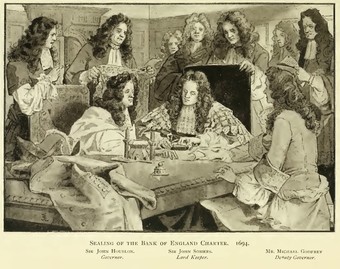
Bank of England Charter
The illustration shows the sealing of the Bank of England Charter in 1694. The structure and function of the Bank of England served as a model for the central banks formed later.
The Monetary Policy Committee is responsible for formulating monetary policy and for setting interest rates in order to maintain a given inflation target. The recently-established Financial Policy Committee is responsible for regulating the UK’s financial sector in order to maintain financial stability.
The People’s Bank of China
The People’s Bank of China (PBC) is the central bank of the People’s Republic of China with the power to control monetary policy and regulate financial institutions in mainland China. The People’s Bank of China has the most financial assets of any single public finance institution. It is responsible for making and implementing monetary policy for safeguarding the overall financial stability and provision of financial services.
The PBC has nine regional branches, as well as many sub-branches and six overseas representative offices. It is divided into 18 functional departments that oversee such issues as monetary policy, financial stability, anti-money laundering, and legal affairs. The top management of the PBC is composed of the governor and a certain number of deputy governors. The PBC adopts a governor responsibility system under which the governor supervises the overall work of the PBC while the deputy governors provide assistance to the governor to fulfill his or her responsibility.
27.3: Creating Money
27.3.1: The Fractional Reserve System
A fractional reserve system is one in which banks hold reserves whose value is less than the sum of claims outstanding on those reserves.
Learning Objective
Examine the impact of fractional reserve banking on the money supply
Key Points
- The main way that banks earn profits is through issuing loans. Because their depositors do not typically all ask for the entire amount of their deposits back at the same time, banks lend out most of the deposits they have collected.
- The fraction of deposits that a bank keeps in cash or as a deposit with the central bank, rather than loaning out to the public, is called the reserve ratio.
- A minimum reserve ratio (or reserve requirement) is mandated by the Fed in order to ensure that banks are able to meet their obligations.
- Because banks are only required to keep a fraction of their deposits in reserve and may loan out the rest, banks are able to create money.
- A lower reserve requirement allows banks to issue more loans and increase the money supply, while a higher reserve requirement does the opposite.
Key Terms
- deposit
-
Money placed in an account.
- reserves
-
Banks’ holdings of deposits in accounts with their central bank, plus currency that is physically held in the bank’s vault.
Banks operate by taking in deposits and making loans to lenders. They are able to do this because not every depositor needs her money on the same day. Thus, banks can lend out some of their depositors’ money, while keeping some on hand to satisfy daily withdrawals by depositors. This is called the fractional-reserve banking system: banks only hold a fraction of total deposits as cash on hand.
Reserve Ratio
The fraction of deposits that a bank must hold as reserves rather than loan out is called the reserve ratio (or the reserve requirement) and is set by the Federal Reserve. If, for example, the reserve requirement is 1%, then a bank must hold reserves equal to 1% of their total customer deposits. These assets are typically held in the form of physical cash stored in a bank vault and in reserves deposited with the central bank.
Banks can also choose to hold reserves in excess of the required level. Any reserves beyond the required reserves are called excess reserves. Excess reserves plus required reserves equal total reserves. In general, since banks make less money from holding excess reserves than they would lending them out, economists assume that banks seek to hold no excess reserves.
Money Creation
Because banks are only required to keep a fraction of their deposits in reserve and may loan out the rest, banks are able to create money. To understand this, imagine that you deposit $100 at your bank. The bank is required to keep $10 as reserves but may lend out $90 to another individual or business. This loan is new money; the bank created it when it issued the loan. In fact, the vast majority of money in the economy today comes from these loans created by banks. Likewise when a loan is repaid, that money disappears from the economy until the bank issues another loan .
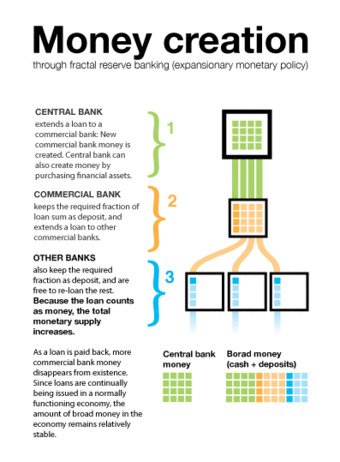
Money Creation in a Fractional Reserve System
The diagram shows the process through which commercial banks create money by issuing loans.
Thus, there are two ways that a central bank can use this process to increase or decrease the money supply. First, it can adjust the reserve ratio. A lower reserve ratio means that banks can issue more loans, increasing the money supply. Second, it can create or destroy reserves. Creating reserves means that commercial banks have more reserves with which they can satisfy the reserve ratio requirement, leading to more loans and an increase in the money supply.
Why Have Reserve Requirements?
Fractional-reserve banking ordinarily functions smoothly. Relatively few depositors demand payment at any given time, and banks maintain a buffer of reserves to cover depositors’ cash withdrawals and other demands for funds. However, banks also have an incentive to loan out as much money as possible and keep only a minimum buffer of reserves, since they earn more on these loans than they do on the reserves. Mandating a reserve requirement helps to ensure that banks have the ability to meet their obligations.
27.3.2: Example Transactions Showing How a Bank Can Create Money
The amount of money created by banks depends on the size of the deposit and the money multiplier.
Learning Objective
Calculate the change in money supply given the money multiplier, an initial deposit and the reserve ratio
Key Points
- When a deposit is made at a bank, that bank must keep a portion the form of reserves. The proportion is called the required reserve ratio.
- Loans out a portion of its reserves to individuals or firms who will then deposit the money in other bank accounts.
- Theoretically, this process will until repeat until there are no excess reserves left.
- The total amount of money created with a new bank deposit can be found using the deposit multiplier, which is the reciprocal of the reserve requirement ratio. Multiplying the deposit multiplier by the amount of the new deposit gives the total amount of money that may be created.
Key Terms
- deposit multiplier
-
The maximum amount of commercial bank money that can be created by a given unit of reserves.
- currency
-
Paper money.
To understand the process of money creation, let us create a hypothetical system of banks. We will focus on two banks in this system: Anderson Bank and Brentwood Bank. Assume that all banks are required to hold reserves equal to 10% of their customer deposits. When a bank’s excess reserves equal zero, it is loaned up.
Anderson and Brentwood both operate in a financial system with a 10% reserve requirement. Each has $10,000 in deposits and no excess reserves, so each has $9,000 in loans outstanding, and $10,000 in deposit balances held by customers.
Suppose a customer now deposits $1,000 in Anderson Bank. Anderson will loan out the maximum amount (90%) and hold the required 10% as reserves. There are now $11,000 in deposits in Anderson with $9,900 in loans outstanding.
The debtor takes her $900 loan and deposits it in Brentwood bank. Brentwood’s deposits now total $10,900. Thus, you can see that total deposits were $20,000 before the initial $1,000 deposit, and are now $21,900 after. Even though only $1,000 were added to the system, the amount of money in the system increased by $1,900. The $900 in checkable deposits is new money; Anderson created it when it issued the $900 loan.
Mathematically, the relationship between reserve requirements (rr), deposits, and money creation is given by the deposit multiplier (m). The deposit multiplier is the ratio of the maximum possible change in deposits to the change in reserves. When banks in the economy have made the maximum legal amount of loans (zero excess reserves), the deposit multiplier is equal to the reciprocal of the required reserve ratio (
).
In the above example the deposit multiplier is 1/0.1, or 10. Thus, with a required reserve ratio of 0.1, an increase in reserves of $1 can increase the money supply by up to $10 .
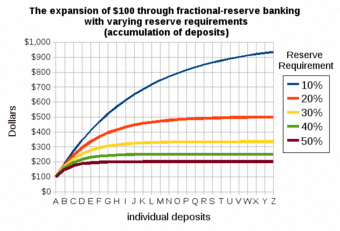
Money Creation and Reserve Requirements
The graph shows the total amount of money that can be created with the addition of $100 in reserves, using different reserve requirements as examples.
27.3.3: The Money Multiplier in Theory
The money multiplier measures the maximum amount of commercial bank money that can be created by a given unit of central bank money.
Learning Objective
Explain how the money multiplier works in theory
Key Points
- The total supply of commercial bank money is, at most, the amount of reserves times the reciprocal of the reserve ratio (the money multiplier).
- When banks have no excess reserves, the supply of total money is equal to reserves times the money multiplier. Theoretically, banks will never have excess reserves.
- According to the theory, a central bank can change the money supply in an economy by changing the reserve requirements.
Key Terms
- money multiplier
-
The maximum amount of commercial bank money that can be created by a given unit of central bank money.
- central bank
-
The principal monetary authority of a country or monetary union; it normally regulates the supply of money, issues currency and controls interest rates.
- commercial bank
-
A type of financial institution that provides services such as accepting deposits, making business loans, and offering basic investment products to the public.
In order to understand the money multiplier, it’s important to understand the difference between commercial bank money and central bank money. When you think of money, what you probably imagine is commercial bank money. This consists of the dollars in your bank account – the money that you use when you write a check or use a debit or credit card. This money is created when commercial banks make loans to companies or individuals. Central bank money, on the other hand, is the money created by the central bank and used within the banking system. It consists of bank reserves held in accounts with the central bank, as well as physical currency held in bank vaults.
The money multiplier measures the maximum amount of commercial bank money that can be created by a given unit of central bank money. That is, in a fractional-reserve banking system, the total amount of loans that commercial banks are allowed to extend (the commercial bank money that they can legally create) is a multiple of reserves; this multiple is the reciprocal of the reserve ratio. We can derive the money multiplier mathematically, writing M for commercial bank money (loans), R for reserves (central bank money), and RR for the reserve ratio. We start with the reserve ratio requirement that the the fraction of deposits that a bank keeps as reserves is at least the reserve ratio:
Taking the reciprocal:
Therefore:
The above equation states that the total supply of commercial bank money is, at most, the amount of reserves times the reciprocal of the reserve ratio (the money multiplier) .
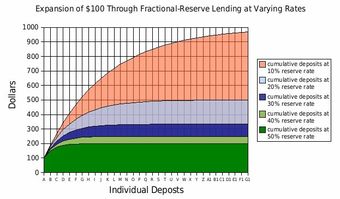
Money Creation and the Money Multiplier
The graph shows the theoretical amount of money that can be created with different reserve requirements.
If banks lend out close to the maximum allowed by their reserves, then the inequality becomes an approximate equality, and commercial bank money is central bank money times the multiplier. If banks instead lend less than the maximum, accumulating excess reserves, then commercial bank money will be less than central bank money times the theoretical multiplier. In theory banks should always lend out the maximum allowed by their reserves, since they can receive a higher interest rate on loans than they can on money held in reserves.
Theoretically, then, a central bank can change the money supply in an economy by changing the reserve requirements. A 10% reserve requirement creates a total money supply equal to 10 times the amount of reserves in the economy; a 20% reserve requirement creates a total money supply equal to five times the amount of reserves in the economy.
27.3.4: The Money Multiplier in Reality
In reality, it is very unlikely that the money supply will be exactly equal to reserves times the money multiplier.
Learning Objective
Explain factors that prevent the money multiplier from working empirically as it does theoretically
Key Points
- Some banks may choose to hold excess reserves, leading to a money supply that is less than that predicted by the money multiplier.
- Customers may withdraw cash, removing a source of reserves against which banks can create money.
- Individuals and businesses may not spend the entire proceeds of their loans, removing the multiplier effect on money creation.
Key Terms
- money multiplier
-
The maximum amount of commercial bank money that can be created by a given unit of central bank money.
- reserve requirement
-
The minimum amount of deposits each commercial bank must hold (rather than lend out).
The money multiplier in theory makes a number of assumptions that do not always necessarily hold in the real world. It assumes that people deposit all of their money and banks lend out all of the money they can (they hold no excess reserves). It also assumes that people instantaneously spend all of their loans. In reality, not all of these are true, meaning that the observed money multiplier rarely conforms to the theoretical money multiplier.
Excess Reserves
First, some banks may choose to hold excess reserves. In the decades prior to the financial crisis of 2007-2008, this was very rare – banks held next to no excess reserves, lending out the maximum amount possible. During this time, the relationship between reserves, reserve requirements, and the money supply was relatively close to that predicted by economic theory. After the crisis, however, banks increased their excess reserves dramatically, climbing above $900 billion in January of 2009 and reaching $2.3 trillion in October of 2013 . The presence of these excess reserves suggests that the reserve requirement ratio is not exerting an influence on the money supply.
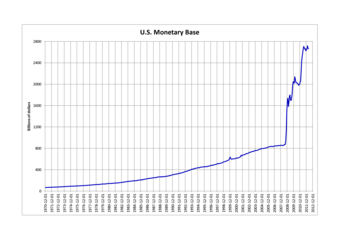
U.S. Monetary Base
The monetary base is the sum of currency and reserves held in accounts at the central bank. After the financial crisis the monetary base increased dramatically: the result of banks starting to hold excess reserves as well as the central bank increasing the supply of reserves.
Cash
Second, customers may hold their savings in cash rather than in bank deposits. Recall that when cash is stored in a bank vault it is included in the bank’s supply of reserves. When it is withdrawn from the bank and held by consumers, however, it no longer serves as reserves and banks cannot use it to issue loans. When people hold more cash, the total supply of reserves available to banks goes down and the total money supply falls.
Loan Proceeds
Third, some loan proceeds may not be spent. Imagine that the reserve requirement ratio is 10% and a customer deposits $1,000 into a bank. The bank then uses this deposit to make a $900 loan to another one of its customers. If the customer fails to spend this money, it will simply sit in the bank account and the full multiplier effect will not apply. In this case, the $1,000 deposit allowed the bank to create $900 of new money, rather than the $10,000 of new money that would be created if the entire loan proceeds were spent.
Chapter 26: Fiscal Policy
26.1: Introduction to Fiscal Policy
26.1.1: Defining Fiscal Policy
Fiscal policy is the use of government spending and taxation to influence the economy.
Learning Objective
Define Fiscal Policy
Key Points
- The government has two levers when setting fiscal policy: it can change the levels of taxation and/or it can change its level of spending.
- There are three types of fiscal policy: neutral policy, expansionary policy,and contractionary policy.
- In expansionary fiscal policy, the government spends more money than it collects through taxes. This type of policy is used during recessions to build a foundation for strong economic growth and nudge the economy toward full employment.
- In contractionary fiscal policy, the government collects more money through taxes than it spends. This policy works best in times of economic booms. It slows the pace of strong economic growth and puts a check on inflation.
Key Term
- fiscal policy
-
Government policy that attempts to influence the direction of the economy through changes in government spending or taxes.
Fiscal policy is the use of government spending and taxation to influence the economy. Governments use fiscal policy to influence the level of aggregate demand in the economy in an effort to achieve the economic objectives of price stability, full employment, and economic growth.
The government has two levers when setting fiscal policy:
- Change the level and composition of taxation, and/or
- Change the level of spending in various sectors of the economy.
There are three main types of fiscal policy:
- Neutral: This type of policy is usually undertaken when an economy is in equilibrium. In this instance, government spending is fully funded by tax revenue, which has a neutral effect on the level of economic activity.
- Expansionary: This type of policy is usually undertaken during recessions to increase the level of economic activity. In this instance, the government spends more money than it collects in taxes.
- Contractionary: This type of policy is undertaken to pay down government debt and to cap inflation. In this case, government spending is lower than tax revenue.
In times of recession, Keynesian economics suggests that increasing government spending and decreasing tax rates is the best way to stimulate aggregate demand. Keynesians argue that this approach should be used in times of recession or low economic activity as an essential tool for building the foundation for strong economic growth and working towards full employment . In theory, the resulting deficit would be paid for by an expanded economy during the boom that would follow.
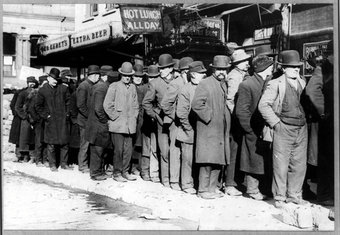
Times of Recession
In times of recession, the government uses expansionary fiscal policy to increase the level of economic activity and increase employment.
In times of economic boom, Keynesian theory posits that removing spending from the economy will reduce levels of aggregate demand and contract the economy, thus stabilizing prices when inflation is too high.
26.1.2: How Fiscal Policy Relates to the AD-AS Model
Expansionary policy shifts the aggregate demand curve to the right, while contractionary policy shifts it to the left.
Learning Objective
Examine the effect of government fiscal policy on aggregate demand
Key Points
- Aggregate demand is made up of consumption, investment, government spending, and net exports. The aggregate demand curve will shift as a result of changes in any of these components.
- Expansionary policy involves an increase in government spending, a reduction in taxes, or a combination of the two. It leads to a right-ward shift in the aggregate demand curve.
- Contractionary policy involves a decrease in government spending, an increase in taxes, or a combination of the two. It leads to a left-ward shift in the aggregate demand curve.
Key Term
- fiscal policy
-
Government policy that attempts to influence the direction of the economy through changes in government spending or taxes.
When setting fiscal policy, the government can take an active role in changing its spending or the level of taxation. These actions lead to an increase or decrease in aggregate demand, which is reflected in the shift of the aggregate demand (AD) curve to the right or left respectively .

Expansionary and Contractionary Fiscal Policy
Expansionary policy shifts the AD curve to the right, while contractionary policy shifts it to the left.
It is helpful to keep in mind that aggregate demand for an economy is divided into four components: consumption, investment, government spending, and net exports. Changes in any of these components will cause the aggregate demand curve to shift.
Expansionary fiscal policy is used to kick-start the economy during a recession. It boosts aggregate demand, which in turn increases output and employment in the economy. In pursuing expansionary policy, the government increases spending, reduces taxes, or does a combination of the two. Since government spending is one of the components of aggregate demand, an increase in government spending will shift the demand curve to the right. A reduction in taxes will leave more disposable income and cause consumption and savings to increase, also shifting the aggregate demand curve to the right. An increase in government spending combined with a reduction in taxes will, unsurprisingly, also shift the AD curve to the right. The extent of the shift in the AD curve due to government spending depends on the size of the spending multiplier, while the shift in the AD curve in response to tax cuts depends on the size of the tax multiplier. If government spending exceeds tax revenues, expansionary policy will lead to a budget deficit.
A contractionary fiscal policy is implemented when there is demand-pull inflation. It can also be used to pay off unwanted debt. In pursuing contractionary fiscal policy the government can decrease its spending, raise taxes, or pursue a combination of the two. Contractionary fiscal policy shifts the AD curve to the left. If tax revenues exceed government spending, this type of policy will lead to a budget surplus.
26.1.3: Expansionary Versus Contractionary Fiscal Policy
When the economy is producing less than potential output, expansionary fiscal policy can be used to employ idle resources and boost output.
Learning Objective
Assess the mechanics and outcomes of fiscal policy
Key Points
- Keynes advocated counter-cyclical fiscal policies–implementing an expansionary fiscal policy during a recession and a contractionary policy during times of rapid economic expansion.
- In pursuing either expansionary or contractionary fiscal policy, the government has two levers – government spending and taxation levels.
- The effects of fiscal policy can be limited by crowding out.
Key Term
- multiplier
-
A ratio used to estimate total economic effect for a variety of economic activities.
Keynesian economists argue that private sector decisions sometimes lead to inefficient macroeconomic outcomes which require active policy responses by the public sector in order stabilize output over the business cycle. Keynes advocated counter-cyclical fiscal policies (policies that acted against the tide of the business cycle). This means deficit spending and decreased taxes when an economy suffers from a recession and decreased government spending and higher taxes during boom times .
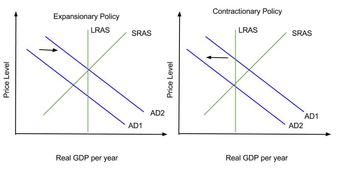
Counter-cyclical Fiscal Policies
Keynesian economists advocate counter-cyclical fiscal policies. This means increased spending and lower taxes during recessions and lower spending and higher taxes during economic boom times.
According to Keynesian economics, if the economy is producing less than potential output, government spending can be used to employ idle resources and boost output. Increased government spending will result in increased aggregate demand, which then increases the real GDP, resulting in an rise in prices. This is known as expansionary fiscal policy. Conversely, in times of economic expansion, the government can adopt a contractionary policy, decreasing spending, which decreases aggregate demand and the real GDP, resulting in a decrease in prices.

Highway Construction
The government can implement expansionary fiscal policy through increased spending, such as paying for the construction of new highways.
In instances of recession, government spending does not have to make up for the entire output gap. There is a multiplier effect that boosts the impact of government spending. The government could stimulate a great deal of new production with a modest expenditure increase if the people who receive this money consume most of it. This extra spending allows businesses to hire more people and pay them, which in turn allows a further increase in spending, and so on in a virtuous circle.
In addition to changes in spending, the government can also close recessionary gaps by decreasing income taxes, which increases aggregate demand and real GDP, which in turn increases prices. Conversely, to close an expansionary gap, the government would increase income taxes, which decreases aggregate demand, the real GDP, and then prices.
The effects of fiscal policy can be limited by crowding out. Crowding out occurs when government spending simply replaces private sector output instead of adding additional output to the economy. Crowding out also occurs when government spending raises interest rates, which limits investment.
26.1.4: Fiscal Levers: Spending and Taxation
Tax cuts have a smaller affect on aggregate demand than increased government spending.
Learning Objective
Analyze the use of changes in the tax rate as a form of fiscal policy
Key Points
- In expansionary policy, the extent to which government spending and tax cuts increase aggregate demand depends on spending and tax multipliers.
- The tax multiplier is smaller than the spending multiplier. This is because the entire government spending increase goes towards increasing aggregate demand, but only a portion of the increased disposable income (resulting for lower taxes) is consumed.
- The multiplier effect of a tax cut can be affected by the size of the tax cut, the marginal propensity to consume, as well as the crowding out effect.
Key Term
- Tax multiplier
-
The change in aggregate demand caused by a change in taxation levels.
Spending and taxation are the two levers available to the government for setting fiscal policy. In expansionary fiscal policy, the government increases its spending, cuts taxes, or a combination of both. The increase in spending and tax cuts will increase aggregate demand, but the extent of the increase depends on the spending and tax multipliers.
The government spending multiplier is a number that indicates how much change in aggregate demand would result from a given change in spending. The government spending multiplier effect is evident when an incremental increase in spending leads to an rise in income and consumption. The tax multiplier is the magnification effect of a change in taxes on aggregate demand. The decrease in taxes has a similar effect on income and consumption as an increase in government spending.
However, the tax multiplier is smaller than the spending multiplier. This is because when the government spends money, it directly purchases something, causing the full amount of the change in expenditure to be applied to the aggregate demand. When the government cuts taxes instead, there is an increase in disposable income. Part of the disposable income will be spent, but part of it will be saved. The money that is saved does not contribute to the multiplier effect .

Spending and Saving
The tax multiplier is smaller than the government expenditure multiplier because some of the increase in disposable income that results from lower taxes is not just consumed, but saved.
The multipliers are calculated as follows:
where MPC is the marginal propensity to consume (the change in consumption divided by the change in disposable income), and MPS is the marginal propensity to save (the change in savings divided by the change in disposable income).
The government spending multiplier is always positive. In contrast, the tax multiplier is always negative. This is because there is an inverse relationship between taxes and aggregate demand. When taxes decrease, aggregate demand increases.
The multiplier effect of a tax cut can be affected by the size of the tax cut, the marginal propensity to consume, as well as the crowding out effect. The crowding out effect occurs when higher income leads to an increased demand for money, causing interest rates to rise. This leads to a reduction in investment spending, one of the four components of aggregate demand, which mitigates the increase in aggregate demand otherwise caused by lower taxes.
26.1.5: How Fiscal Policy Can Impact GDP
Fiscal policy impacts GDP through the fiscal multiplier.
Learning Objective
Discuss the mechanisms that allow the fiscal policy to affect GDP
Key Points
- The fiscal multiplier is the ratio of change in national income to the change in governments spending that causes it.
- The multiplier effect occurs when an initial incremental amount of spending leads to an increase in income and consumption, which further increases income, which further increases consumption, and so on in a virtuous circle, resulting in an overall increase in the GDP.
- The multiplier effect is evident when the multiplier is greater or less than one.
- In certain cases, multiplier values of less than one have been empirically measured, suggesting that government spending can crowd out private investment or consumer spending.
Key Term
- fiscal multiplier
-
The ratio of a change in national income to the change in government spending that causes it.
Expansionary fiscal policy can impact the gross domestic product (GDP) through the fiscal multiplier. The fiscal multiplier (which is not to be confused with the monetary multiplier) is the ratio of a change in national income to the change in government spending that causes it. When this multiplier exceeds one, the enhanced effect on national income is called the multiplier effect.
The multiplier effect arises when an initial incremental amount of government spending leads to increased income and consumption, increasing income further, and hence further increasing consumption, and so on, resulting in an overall increase in national income that is greater than the initial incremental amount of spending. In other words, an initial change in aggregate demand may cause a change in aggregate output (and hence the aggregate income that it generates) that is a multiple of the initial change. The multiplier effect has been used as an argument for the efficacy of government spending or taxation relief to stimulate aggregate demand.
For example, suppose the government spends $1 million to build a plant . The money does not disappear, but rather becomes wages to builders, revenue to suppliers, etc. The builders then will have more disposable income, and consumption may rise, so that aggregate demand will also rise. Suppose further that recipients of the new spending by the builder in turn spend their new income, raising demand and possibly consumption further, and so on. The increase in the gross domestic product is the sum of the increases in net income of everyone affected. If the builder receives $1 million and pays out $800,000 to sub contractors, he has a net income of $200,000 and a corresponding increase in disposable income (the amount remaining after taxes). This process proceeds down the line through subcontractors and their employees, each experiencing an increase in disposable income to the degree the new work they perform does not displace other work they are already performing. Each participant who experiences an increase in disposable income then spends some portion of it on final (consumer) goods, according to his or her marginal propensity to consume, which causes the cycle to repeat an arbitrary number of times, limited only by the spare capacity available.

Fiscal Multiplier Example
The money spent on construction of a plant becomes wages to builders. The builders will have more disposable income, increasing their consumption and the aggregate demand.
In certain cases multiplier values of less than one have been empirically measured, suggesting that certain types of government spending crowd out private investment or consumer spending that would have otherwise taken place.
26.1.6: Fiscal Policy and the Multiplier
Fiscal policy can have a multiplier effect on the economy.
Learning Objective
Describe the effects of the multiplier beyond its relevance to fiscal policy
Key Points
- The size of the increase in GDP depends on the type of fiscal policy.
- The multiplier on changes in government spending is larger than the multiplier on changes in taxation levels.
- The taxation multiplier is smaller than the spending multiplier because part of any change in taxes is absorbed by savings.
Key Term
- fiscal multiplier
-
The ratio of a change in national income to the change in government spending that causes it.
Fiscal policy can have a multiplier effect on the economy. For example, if a $100 increase in government spending causes the GDP to increase by $150, then the spending multiplier is 1.5. In addition to the spending multiplier, other types of fiscal multipliers can also be calculated, like multipliers that describe the effects of changing taxes. The size of the multiplier effect depends upon the fiscal policy.
Expansionary fiscal policy can lead to an increase in real GDP that is larger than the initial rise in aggregate spending caused by the policy. Conversely, contractionary fiscal policy can lead to a fall in real GDP that is larger than the initial reduction in aggregate spending caused by the policy .
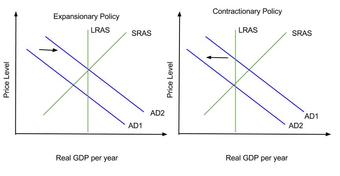
Multiplier Effect
The multiplier effect determines the extent to which fiscal policy shifts the aggregate demand curve and impacts output.
The size of the shift of the aggregate demand curve and the change in output depend on the type of fiscal policy. The multiplier on changes in government purchases, 1/(1 – MPC), is larger than the multiplier on changes in taxes, MPC/(1 – MPC), because part of any change in taxes or transfers is absorbed by savings. In both of these equations, recall that MPC is the marginal propensity to consume.
For example, the government hands out $50 billion in the form of tax cuts. There is no direct effect on aggregate demand by government purchases of goods and services. Instead, GDP goes up only because households spend some of that $50 billion. But how much will they spend? Households will spend MPC*$50 billion (where MPC is the marginal propensity to consume). If MPC is equal to 0.6, the first-round increase in consumer spending will be $30 billion (0.6*$50 billion = $30 billion). The initial rise in consumer spending will lead to a series of subsequent rounds in which the real GDP, disposable income, and consumer spending rise further.
26.2: Evaluating Fiscal Policy
26.2.1: Automatic Stabilizers
Automatic stabilizers are modern government budget policies that act to dampen fluctuations in real GDP.
Learning Objective
Explain the role of automatic stabilizers in regulating economic fluctuations
Key Points
- During recessions, government spending automatically increases, which raises aggregate demand and offsets decreases in consumer demand. Government revenue automatically decreases.
- During economic booms, government spending automatically decreases, which prevents bubbles and the economy from overheating. Government revenue automatically increases.
- The fiscal multiplier is the ratio of a change in national income to the change in government spending that causes it. An initial change in aggregate demand may cause a change in aggregate output (and hence the aggregate income that it generates) that is a multiple of the initial change.
Key Terms
- fiscal multiplier
-
The ratio of a change in national income to the change in government spending that causes it.
- automatic stabilizer
-
A budget policy that automatically changes to stabilize fluctuations in GDP.
In macroeconomics, the concept of automatic stabilizers describes how modern government budget policies, particularly income taxes and welfare spending, act to dampen fluctuations in real GDP. The size of the government budget deficit tends to increase when a country enters a recession, which tends to keep national income higher by maintaining aggregate demand. This effect happens automatically depending on GDP and household income, without any explicit policy action by the government, and acts to reduce the severity of recessions.
Here is an example of how automatic stabilizers would work in a recession. When the country takes an economic downturn, more people become unemployed. As a result more people file for unemployment and other welfare measures, which increases government spending and aggregate demand. The unemployed also pay less in taxes because they are not earning a wage, which in turn decreases government revenue. The result is an increase in the federal deficit without Congress having to pass any specific law or act.
Similarly, the budget deficit tends to decrease during booms, which pulls back on aggregate demand. Because more people are earning wages during booms, the government can collect more taxes. Also, because fewer individuals need social services support during a boom, government spending also decreases. As spending decreases, aggregate demand decreases. Therefore, automatic stabilizers tend to reduce the size of the fluctuations in a country’s GDP.
Fiscal Multiplier Effect
What makes automatic stabilizers so effective in dampening economic fluctuations is the fiscal multiplier effect. The fiscal multiplier is the ratio of a change in national income to the change in government spending that causes it. When this multiplier exceeds one, the enhanced effect on national income is called the multiplier effect.
The multiplier effect occurs as a chain reaction. The increased funds received from the government by citizens allows them to increase their consumption. As a result, producers must increase their production, which requires firms to hire more workers. Because of the increased purchases and lower unemployment, people have more money to spend and increase their consumption. This consumption-production-consumption cycle leads to the multiplier effect, resulting in an overall increase in national income greater than the initial incremental amount of spending. In other words, an initial change in aggregate demand may cause a change in aggregate output (and hence the aggregate income that it generates) that is a multiple of the initial change.
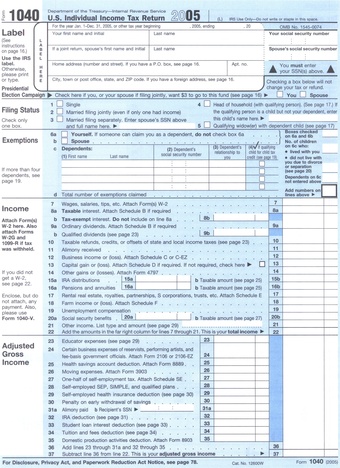
Tax Form 1040
Taxes are a part of the automatic stabilizers a country uses to minimize fluctuations in their real GDP. During boom times when the economy is doing well, people earn more income and this translates to higher tax revenues for the government, lowering the budget deficit.
26.2.2: Automatic Stabilizers Versus Discretionary Policy
Automatic stabilizers and discretionary policy differ in terms of timing of implementation and what each approach sets out to achieve.
Learning Objective
Describe the differences between automatic stabilizers and discretionary policy
Key Points
- Discretionary policy is a macroeconomic policy based on the judgment of policymakers in the moment as opposed to policy set by predetermined rules. Examples may include passing a new spending bill that promotes a certain cause, such as green technology, or the creation of a federal jobs program.
- When the economy begins to go through an economic fluctuation, automatic stabilizers immediately respond without any official or government body having to take action. With discretionary policy there is a significant time lag before action can be taken.
- Automatic stabilizers are limited in that they focus on managing the aggregate demand of a country. Discretionary policies can target other, specific areas of the economy.
- Automatic stabilizers exist prior to economic booms and busts. Discretionary policies are enacted in response to changes in the economy.
Key Terms
- discretionary policy
-
Actions taken in response to changes in the economy. These acts do not follow a strict set of rules, rather, they use subjective judgment to treat each situation in unique manner.
- automatic stabilizer
-
A budget policy that automatically changes to stabilize fluctuations in GDP.
In fiscal policy, there are two different approaches to stabilizing the economy: automatic stabilizers and discretionary policy. Both approaches focus on minimizing fluctuations in real GDP but have different means of doing so.
Discretionary Policy
Discretionary policy is a macroeconomic policy based on the judgment of policymakers in the moment, as opposed to a policy set by predetermined rules. Discretionary policies refer to actions taken in response to changes in the economy, but they do not follow a strict set of rules; rather, they use subjective judgment to treat each situation in unique manner. In practice, most policy changes are discretionary in nature. Examples may include passing a new spending bill that promotes a certain cause, such as green technology, or the creation of a federal jobs program .

WPA
The Works Progress Administration (WPA) was part of the New Deal. The WPA is an example of a Depression-era discretionary policy meant to reduce unemployment by providing jobs for the unemployed.
Discretionary policies are generally laws enacted by Congress, which requires that any policy go through the same vetting and marking up process as any other law.
Automatic Stabilizers and Discretionary Policy
The key difference between these two types of financial policy approaches is timing of implementation. When the economy begins to go through an economic fluctuation, automatic stabilizers immediately respond without any official or government body having to take action. With discretionary policy there is a significant time lag. Before action can be taken, Congress must first determine that there is an issue and that action needs to be taken. Then Congress needs to design and implement a policy response. Then the law needs to be passed and the relevant agencies need to adjust and alter any necessary procedures so they can carry out the law. It is due to these significant lags that economists like Milton Friedman believed that discretionary fiscal policy could be destabilizing.
On the other hand, automatic stabilizers are limited in that they focus on managing the aggregate demand of a country. Discretionary policies can target other, specific areas of the economy. Discretionary policies can address failings of the economy that are not strictly tied to aggregate demand. For example, if an economy is going through a recession because its workers lack a certain set of skills, automatic stabilizers cannot address that problem. Government programs, such as retraining, can address this problem.
Finally, automatic stabilizers, such as the tax code and social service agencies, exist prior to an economic fluctuation. Discretionary policies are made in response to a fluctuation and only come into existence once a fluctuation starts to occur.
Of course, it is not possible to create an automatic stabilizer for every potential economic issue, so discretionary policy allows policymakers flexibility.
26.2.3: The Role of the Federal Budget
The federal budget dictates how much money the government plans to raise and how it plans to spend it in the upcoming year.
Learning Objective
Describe how the federal budget is created and its economic role
Key Points
- Congressional decisions are governed by rules and legislation regarding the federal budget process. Budget committees set spending limits for the House and Senate committees. Appropriations subcommittees then approve individual appropriations bills to allocate funding to various federal programs.
- If Congress fails to pass an annual budget, a series of appropriations bills must be passed as “stop gap” measures.
- The budget is a method of conducting fiscal policy and reflect government intervention in markets.
Key Term
- appropriations bill
-
A legislative motion that authorizes the government to spend money.
The Federal Budget is the roadmap for how the national government plans to spend its money of the course of the upcoming year. It dictates which programs will receive funding and how much money the government will spend on each.
How the Federal Budget is Created
The Budget of the United States Government often begins as the president’s proposal to the U.S. Congress which recommends funding levels for the next fiscal year, beginning October 1. However, Congress is the body required by law to pass a budget annually and to submit the budget passed by both houses to the president for signature. To help Congress pass the best budget possible, several government agencies provide data and analysis. These include the Government Accountability Office (GAO), Congressional Budget Office (CBO), the Office of Management and Budget (OMB), and the U.S. Treasury Department.
Congressional decisions are governed by rules and legislation regarding the federal budget process. Budget committees set spending limits for the House and Senate committees. Appropriations subcommittees then approve individual appropriations bills to allocate funding to various federal programs.
If Congress fails to pass an annual budget, a series of appropriations bills must be passed as “stop gap” measures. After Congress approves an appropriations bill, it is sent to the president, who may sign it into law, or may veto it (as he would a budget when passed by the Congress). A vetoed bill is sent back to Congress, which can pass it into law with a two-thirds majority in each chamber. Congress may also combine all or some appropriations bills into an omnibus reconciliation bill. In addition, the president may request and the Congress may pass supplemental appropriations bills or emergency supplemental appropriations bills.
Economic Role of the Federal Budget
The federal budget is meant to provide the larger American economy with a sense of direction regarding where the Federal government is going to go and what they are going to do. The Federal budget discloses how much the government plans to tax and how it plans to spend its money. Individuals and businesses can then adjust their actions to accommodate what they’ll have to pay in taxes and what resources will be available to them in the government.
The federal budget also is one mechanism for conducting fiscal policy. The government can choose to expand or contract the budget to conduct expansionary or fiscal policy.
The specific items in the budget also have important policy implications: social welfare, social insurance, and government intervention in markets may all be reflected in the budget.
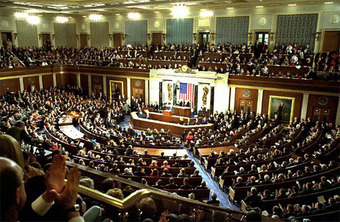
Congress
The U.S. Congress is responsible for passing the Federal Budget. If it cannot pass a Federal Budget, it must pass appropriation bills as a “stop gap. “
26.2.4: Arguments for and Against Balancing the Budget
Balanced budgets, and the associated topic of budget deficits, are a contentious point within both academic economics and politics.
Learning Objective
Describe arguments against maintaining a balanced budget in the United States
Key Points
- A balanced budget is a budget where revenues equal expenditures. A balanced budget can also refer to a budget where revenues are greater than expenditures.
- Most economists have also agreed that a balanced budget would decrease interest rates, increase savings and investment, shrink trade deficits and help the economy grow faster over a longer period of time.
- Keynesians argue for balanced budgets over the course of the business cycle. If a country rigidly pursues a balanced budget regardless of the circumstances, critics argue that economic downturns would be needlessly painful.
Key Term
- balanced budget
-
A (usually government) budget in which income and expenditure are equal over a set period of time.
A balanced budget, particularly a government budget, is a budget with revenues equal to expenditures. There is neither a budget deficit nor a budget surplus; in other words, “the accounts balance. ” More generally, it refers to a budget with no deficit, but possibly with a surplus. A cyclically balanced budget is a budget that is not necessarily balanced year-to-year, but is balanced over the economic cycle, running a surplus in boom years and running a deficit in lean years, with these offsetting over time .

John Maynard Keynes
John Maynard Keynes founded the Keynesian school, which promotes balanced governmental budgets over the course of the business cycle as opposed to annual balanced budgets.
Balanced budgets, and the associated topic of budget deficits, are a contentious point within academic economics and within politics.
Arguments for a Balanced Budget
Most economists agree that a balanced budget would:
- decrease interest rates, making it easier for businesses and individuals to invest;
- increase savings and investment, which would provide security to individuals;
- shrink trade deficits; and
- help the economy grow faster over a longer period of time.
In the US, every state other than Vermont has a version of a balanced budget amendment, which prohibits some deficits. The federal government does not have such an amendment.
Arguments Against a Balanced Budget
The mainstream economic view is that having a balanced budget in every year is not desirable. If a country rigidly pursues a balanced budget regardless of the circumstances, critics argue that economic downturns would be needlessly painful. If balanced budgets were required and if the budget was in deficit during a recession, critics argue that the required cuts would make the economy even worse off.
Keynesian economists argue that government budgets should be balanced over the business cycles. During recessions governments should run deficits. Keynesians argue that increasing government spending and decreasing taxes can minimize the painful effects of a recession. Once an economy moves into a growth cycle, Keynesians believe the government should shift its perspective and try to run a budget surplus by decreasing spending and increasing taxes. By balancing deficits in recessions and surpluses in growth, Keynesians believe that the government can obtain the benefits of a balanced budget without facing the risks of making recessions worse due to spending and revenue limitations.
26.2.5: Long-Run Implications of Fiscal Policy
Expansionary fiscal policy can lead to decreased private investment, decreased net imports, and increased inflation.
Learning Objective
Identify the long-run consequences of fiscal policy
Key Points
- Fiscal policy is the use of government revenue collection (taxation) and expenditure (spending) to influence the economy.
- When government borrowing increases interest rates, it can attract foreign capital from foreign investors, which can increases demand for that country’s currency and raise it’s value. This increase in the currency’s value increases export the price of exports.
- When governments fund a deficit with the issuing of government bonds, interest rates can increase across the market, because government borrowing creates higher demand for credit in the financial markets. This causes a lower aggregate demand for goods and services.
- In theory, fiscal stimulus does not cause inflation when it uses resources that would have otherwise been idle.
Key Term
- inflation
-
An increase in the general level of prices or in the cost of living.
Fiscal policy is the use of government revenue collection (taxation) and expenditure (spending) to influence the economy. The two main instruments of fiscal policy are changes in the level and composition of taxation and government spending in various sectors.
It is important to underline that fiscal policy is heavily debated, and that expected outcomes are not achieved with complete certainty. That being said, these changes in fiscal policy can affect the following macroeconomic variables in an economy:
- Aggregate demand and the level of economic activity;
- The distribution of income;
- The pattern of resource allocation within the government sector and relative to the private sector.
Decreased Private Investment
Economists still debate the effectiveness of fiscal policy to influence the economy, particularly when it comes to using expansionary fiscal policy to stimulate the economy. When the government runs a budget deficit, funds will need to come from public borrowing (the issue of government bonds), overseas borrowing, or monetizing the debt. When governments fund a deficit with the issuing of government bonds, interest rates can increase across the market, because government borrowing creates higher demand for credit in the financial markets. This causes a lower aggregate demand for goods and services, contrary to the objective of a fiscal stimulus.
Decreased Net Exports
Some also believe that expansionary fiscal policy also decreases net exports, which has a mitigating effect on national output and income. When government borrowing increases interest rates it attracts foreign capital from foreign investors. This is because, all other things being equal, the bonds issued from a country executing expansionary fiscal policy now offer a higher rate of return. In other words, companies wanting to finance projects must compete with their government for capital so they offer higher rates of return. To purchase bonds originating from a certain country, foreign investors must obtain that country’s currency. Therefore, when foreign capital flows into the country undergoing fiscal expansion, demand for that country’s currency increases. The increased demand causes that country’s currency to appreciate. Once the currency appreciates, goods originating from that country now cost more to foreigners than they did before and foreign goods now cost less than they did before. Consequently, exports decrease and imports increase.
Increased Inflation
Other possible problems with fiscal stimulus include inflationary effects driven by increased demand. Simply put, increasing the capital in a given system will eventually devalue the currency itself if there is an increase in money supply in circulation. Similarly, if stimulus capital is invested in creating jobs, the overall spending in a given economy will increase (that is, if jobs are actually created). This spending increase will shift demand to potentially increase price points. Whenever fiscal policy decisions are made, modeling the likelihood of inflation is a critical consideration.
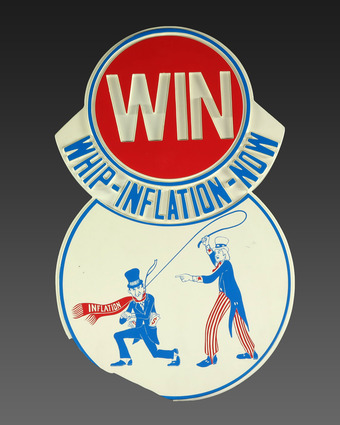
WIN
If a country pursues and expansionary fiscal policy, high inflation becomes a concern.
26.2.6: Problems of Long-Run Government Debt
Government debt limits future government actions and can be hard to pay off because Congressmen are unwilling to do what is necessary to pay down the debt.
Learning Objective
Evaluate the consequences of imbalances in the government budget
Key Points
- To raise the necessary funds to pay down debt, governments will ultimately have to lower costs and/or raise taxes. Because cutting spending and raising taxes is unpopular, Congressmen may be hesitant to take those actions because it might prevent them from being re-elected.
- To pay off the debt, the government must maintain a certain level of income. This could limit the government’s ability to pursue expansionary fiscal policies to address future recessions.
- If the government chooses to delay paying down the debt, the compounding interest will lead to more debt which will lead to a higher annual interest expense that future generations will have to pay.
Key Term
- cyclically balanced budget
-
Occurs when the government runs a deficit during recessions and lean years but a surplus during periods of significant growth.
Deficit spending during times of recession widely seen as a beneficial policy that can mitigate the effects of an economic downturn. However, even Keynesians that support deficit spending during recessions advise that governments balance this deficit spending with surpluses during the eventual economic boom. This means generating a government surplus by cutting expenses and raising taxes. This is known as a cyclically balanced budget; the government runs a deficit during recessions and lean years but a surplus during periods of significant growth.
Paying Down Debt
During periods of expansionary fiscal policy, the government will often fund programs by issuing debt . The problem with debt is that it must be paid off with future revenues.

Government debt
Publicly issued debt is one means governments use to fund expansionary fiscal policy. The problem with debt is that it needs to be paid off with future revenues, which curtails future government spending.
To pay off the debt, the government must maintain a certain level of income. This could limit the government’s ability to pursue expansionary fiscal policies to address future recessions. On the other hand, if the government chooses to delay paying down the debt, the compounding interest will lead to more debt which will lead to a higher annual interest expense that future generations will have to pay.
Cutting Expenses and Raising Taxes
To offset the budgetary deficits and raise the necessary funds to pay down debt, governments will ultimately have to lower costs and raise taxes. In any democracy, especially in the U.S., doing those two things are incredibly difficult because both options are unpopular with voters. Since Congress is responsible for making budgetary, spending and taxation decisions, and because these elected officials may be disinclined to do anything that would hurt their chances to be re-elected, taking the necessary steps to balance out the periods of deficit spending during economic boom is difficult.
Credit Rating
A credit rating is an evaluation of the creditworthiness of a government, but not individual consumers. The evaluation is made by a credit rating agency of the country’s ability to pay back the debt and the likelihood of default. A sovereign credit rating is the credit rating of a sovereign entity (i.e., a national government). The sovereign credit rating indicates the risk level of the investing environment of a country and is used by investors looking to invest abroad. It takes political risk into account, as well as the amount of debt the country has outstanding.
If a country has a bad credit rating, it generally must have a higher interest rate on the debt it issues. This means it will be more expensive for that country to raise funds by issuing debt.
26.2.7: Limits of Fiscal Policy
Two key limits of fiscal policy are coordination with the nation’s monetary policy and differing political viewpoints.
Learning Objective
Identify the political and economic limits of fiscal policy
Key Points
- Conservatives are more likely to reject Keynesianism and argue that government should always run a balanced budget (and a surplus to pay down any outstanding debt) than Democrats.
- Liberals are more likely to be Keynesian and Post-Keynesians than Republicans; they are more likely to argue that deficit spending is necessary, either to create the money supply (Chartalism) or to satisfy demand for savings in excess of what can be satisfied by private investment.
- There is a dilemma as to whether these monetary and fiscal policies are complementary, or act as substitutes to each other for achieving macroeconomic goals.
Key Term
- monetary policy
-
The process by which the central bank, or monetary authority manages the supply of money, or trading in foreign exchange markets.
While fiscal policy can be a powerful tool for influencing the economy, there are limits in how effective these policies are.
Coordination with Monetary Policy
Fiscal policy and monetary policy are the two primary tools used by the State to achieve its macroeconomic objectives. While the main objective of fiscal policy is to influence the aggregate output of the economy, the main objective of the monetary policies is to control the interest and inflation rates. Fiscal policies have an impact on the goods market and monetary policies have an impact on the asset markets and since the two markets are connected to each other via the two macrovariables — output and interest rates – the policies interact while influencing the output or the interest rates.
There is controversy regarding whether these two policies are complementary or act as substitutes to each other for achieving macroeconomic goals. Policy makers are viewed to interact as strategic substitutes when one policy maker’s expansionary (contractionary) policies are countered by another policy maker’s contractionary (expansionary) policies. For example: if the fiscal authority raises taxes or cuts spending, then the monetary authority reacts to it by lowering the policy rates and vice versa. If they behave as strategic complements,then an expansionary (contractionary) policy of one authority is met by expansionary (contractionary) policies of other.
The issue of interaction and the policies being complement or substitute to each other arises only when the authorities are independent of each other. But when, the goals of one authority is made subservient to that of others, then the dominant authority solely dominates the policy making and no interaction worthy of analysis would arise. Also, it is worthy to note that fiscal and monetary policies interact only to the extent of influencing the final objective. So long as the objectives of one policy is not influenced by the other, there is no direct interaction between them.
Political Conflict
Fiscal policy is also a source of significant political conflict along party lines. Conservatives are more likely to reject Keynesianism and are more likely to argue that government should always run a balanced budget (and a surplus to pay down any outstanding debt), and that deficit spending is always bad policy .

American political divide
There are two different approaches to fiscal policy in the US. Broadly, Democrats tend to be more Keynesian than Republicans.
Fiscal conservatism has academic support, predominantly associated with the neoclassical-inclined Chicago school of economics, and has significant political and institutional support, with all but one state of the United States (Vermont is the exception) having a balanced budget amendment to its state constitution. Fiscal conservatism was the dominant position until the Great Depression.
Liberals are more likely to be Keynesian and Post-Keynesians than Republican. They are more likely to argue that deficit spending is necessary, either to create the money supply (Chartalism) or to satisfy demand for savings in excess of what can be satisfied by private investment.
Chartalists argue that deficit spending is logically necessary because, in their view, fiat money is created by deficit spending: one cannot collect fiat money in taxes before one has issued it and spent it, and the amount of fiat money in circulation is exactly the government debt – money spent but not collected in taxes.
Fiscal Multiplier
The fiscal multiplier is the ratio of a change in national income to the change in government spending that causes it. When this multiplier exceeds one, the enhanced effect on national income is called the multiplier effect. The mechanism that can give rise to a multiplier effect is that an initial incremental amount of spending can lead to increased consumption spending, increasing income further and hence further increasing consumption, etc., resulting in an overall increase in national income greater than the initial incremental amount of spending. In other words, an initial change in aggregate demand may cause a change in aggregate output that is a multiple of the initial change.
How effective fiscal policy is depends on the multiplier. The greater the multiplier, the more effective the policy. If for some reason outside of the control of the government the multiplier remains low, the effectiveness of fiscal policy will remain limited at best.
26.2.8: Difficulty in Getting the Timing Right
Discretionary fiscal policy relies on getting the timing right, but this can be difficult to determine at the time decisions must be made.
Learning Objective
Explain the effect of timing on the use of fiscal policy tools
Key Points
- Automatic stabilizers are designed to respond to evolving economic conditions without anyone taking action; timing is not an issue.
- Good economic data are a precondition to effective macroeconomic management. The problem with this is that it could be weeks, or even months, before the necessary data is collected and organized in a way that would reveal there is a problem.
- Once a discretionary program is in place, the next step is to measure its effectiveness. Again, measurement becomes a problem. Because it takes so long to measure fluctuations in the economy, it may be months before the program’s effect on the economy can be seen.
Key Term
- discretionary fiscal policy
-
A fiscal policy achieved through government intervention, as opposed to automatic stabilizers.
A nation can respond to economic fluctuations through automatic stabilizers or through discretionary policy. With regards to automatic stabilizers, timing is not an issue. Automatic stabilizers are designed to respond to evolving economic conditions without anyone taking action.
With discretionary fiscal policy, timing plays a very significant role. Discretionary policy often requires that a set of laws must be passed through a legislature. This means that the problem has to be identified first, which means collecting macroeconomic data.
Good economic data are a precondition to effective macroeconomic management. With the complexity of modern economies and the lags inherent in macroeconomic policy instruments, a country must have the capacity to promptly identify any adverse trends in its economy and to apply the appropriate corrective measure. This cannot be done without economic data that is complete, accurate and timely. The problem with this is that it could be weeks, or even months, before the necessary data is collected and organized in a way that would reveal there is a problem.
Once the problem has been established, Congress must then arrive at a plan and hold debates. Any legislation must pass through committees in both chambers, and both chambers must approve. Then, it must be presented to the President for his signature. This entire process would take weeks at least, but would more likely take months .
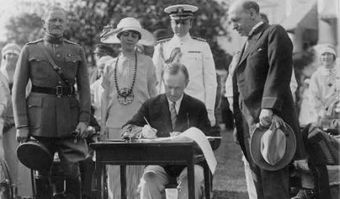
President Coolidge Signing a Bill into Law
It can take many months before Congress can pass a bill that would address current economic fluctuations.
Once the discretionary program is in place, the next step is to measure its effectiveness. Again, measurement becomes a problem. Because it takes so long to measure fluctuations in the economy, it may be months before the program’s effect on the economy can be seen.
26.2.9: Crowding-Out Effect
Usually the term “crowding out” refers to the government using up financial and other resources that would otherwise be used by private enterprise.
Learning Objective
Explain the crowding out effect
Key Points
- Some commentators and other economists use “crowding out” to refer to government providing a service or good that would otherwise be a business opportunity for private industry.
- An increase in the demand for loanable funds by the government shifts the loanable funds demand curve rightwards and upwards, increasing the real interest rate. A higher real interest rate increases the opportunity cost of borrowing money, decreasing investment and consumption.
- If the economy is at capacity or full employment, the government suddenly implementing a stimulus program could create competition with the private sector for scarce funds available for investment, resulting in reduced private investment.
Key Term
- interest rate
-
The percentage of an amount of money charged for its use per some period of time (often a year).
Usually when economists use the term crowding out they are referring to the government using up financial and other resources that would otherwise be used by private enterprise. However, some commentators and other economists use crowding out to refer to government providing a service or good that would otherwise be a business opportunity for private industry.
The macroeconomic theory behind crowding out provides some useful intuition. What happens is that an increase in the demand for loanable funds by the government (e.g. due to a deficit) shifts the loanable funds demand curve rightwards and upwards, increasing the real interest rate. A higher real interest rate increases the opportunity cost of borrowing money, decreasing the amount of interest-sensitive expenditures such as investment and consumption. Thus, the government has crowded out investment .

Crowding out Chart
When crowding-out occurs, the Investment-Savings (IS) curve moves to the right, causing higher interest rates (i) and expansion in the “real” economy (real GDP, or Y). LM stands for Liquidity Preference – Money Supply.
Borrowing and Crowding Out
In economics, crowding-out occurs when increased government borrowing reduces investment spending. The increased borrowing crowds out private investing.
If an increase in government spending and/or a decrease in tax revenues leads to a deficit that is financed by increased borrowing, then the borrowing can increase interest rates, leading to a reduction in private investment. There is some controversy in modern macroeconomics on the subject, as different schools of economic thought differ on how households and financial markets would react to more government borrowing under various circumstances.
Crowding-Out and Stimulus Programs
The extent to which crowding out occurs depends on the economic situation. If the economy is at capacity or full employment, then the government suddenly increasing its budget deficit (e.g., via stimulus programs) could create competition with the private sector for scarce funds available for investment, resulting in an increase in interest rates and reduced private investment or consumption. Therefore, the effect of the stimulus is offset by the effect of crowding out.
26.2.10: Evaluating the Recent United States Stimulus Package
The American Recovery and Reinvestment Act of 2009 (ARRA) was drafted in response to the Great Recession, primarily in order to create jobs.
Learning Objective
Summarize the effects of the use of stimulus in the wake of the Great Recession
Key Points
- Secondary objectives of the ARRA were to provide temporary relief programs for those most impacted by the recession and invest in infrastructure, education, health, and renewable energy.
- Reports on the effectiveness of the ARRA’s ability to create jobs were mixed. One conservative estimate said that the ARRA saved or created 1.6 to 1.8 million jobs and forecast a total impact of 2.5 million jobs saved by the time the stimulus is completed.
- A sizeable number of projects funded by the stimulus could not be started right away, diminishing its immediate impact.
Key Terms
- infrastructure
-
The basic facilities, services and installations needed for the functioning of a community or society
- quarter
-
Related to a three-month term, a quarter of a year.
The American Recovery and Reinvestment Act of 2009 (ARRA), otherwise known as the Stimulus or The Recovery Act, was an economic stimulus package was signed into law on February 17, 2009.
The ARRA was drafted in response to the Great Recession. The primary objective for ARRA was to save and create jobs almost immediately. Secondary objectives were to provide temporary relief programs for those most impacted by the recession and invest in infrastructure, education, health, and renewable energy .
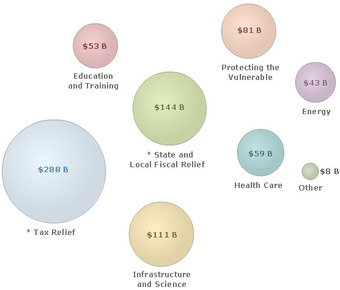
Composition of Stimulus
Tax incentives — includes $15 B for Infrastructure and Science, $61 B for Protecting the Vulnerable, $25 B for Education and Training and $22 B for Energy, so total funds are $126 B for Infrastructure and Science, $142 B for Protecting the Vulnerable, $78 B for Education and Training, and $65 B for Energy.State and Local Fiscal Relief — Prevents state and local cuts to health and education programs and state and local tax increases.
The approximate cost of the economic stimulus package was estimated to be $787 billion at the time of passage, later revised to $831 billion between 2009 and 2019. The Act included direct spending in infrastructure, education, health, and energy, federal tax incentives, and expansion of unemployment benefits and other social welfare provisions. The rationale for ARRA came from Keynesian macroeconomic theory, which argues that during recessions, the government should offset the decrease in private spending with an increase in public spending in order to save jobs and stop further economic deterioration.
The Stimulus’s Impact on Unemployment
The primary justification for the stimulus package was to minimize unemployment. The Obama administration and Democratic proponents presented a graph in January 2009 showing the projected unemployment rate with and without the ARRA. The graph showed that if ARRA was not enacted the unemployment rate would exceed 9%; but if ARRA was enacted it would never exceed 8%. After ARRA became law, the actual unemployment rate exceeded 8% in February 2009, exceeded 9% in May 2009, and exceeded 10% in October 2009. The actual unemployment rate was 9.2% in June 2011 when it was projected to be below 7% with the ARRA. However, supporters of ARRA claim that this can be accounted for by noting that the actual recession was subsequently revealed to be much worse than any projections at the time when the ARRA was drawn up.
One year after the stimulus, several independent firms, including Moody’s and IHS Global Insight, estimated that the stimulus saved or created 1.6 to 1.8 million jobs and forecast a total impact of 2.5 million jobs saved by the time the stimulus is completed. The Congressional Budget Office considered these estimates conservative. The CBO estimated that, according to its model, 2.1 million jobs were saved in the last quarter of 2009, boosting the country’s GDP by up to 3.5% and lowering the unemployment rate by up to 2.1%.
In 2013, the Reason Foundation conducted a study of the results of the ARRA. Only 23% of 8,381 sampled companies hired new workers and kept all of them when the project was completed. Only 41% of sampled companies hired workers at all. 30% of sampled companies laid off all workers once the government money stopped funding. These results cast doubt on previously stated estimates of job creation numbers, which do not take into account those companies that did not retain their workers.
Shovel-Ready Projects
One of the primary purposes and promises of the Act was to launch a large number projects to stimulate the economy. However, a sizable number of these projects, many of which pertained to infrastructure, took longer to implement than they had expected by most. Just because the money was there for the projects did not mean that the projects were “shovel-ready”: there was a delay between when the funding became available and when the project could actually begin. Since the stimulus only is impactful when the money is actually spent, delays could have reduced the overall effectiveness of the stimulus.
Chapter 25: Major Macroeconomic Theories
25.1: Major Theories in Macroeconomics
25.1.1: Keynesian Theory
Keynesian theory posits that aggregate demand will not always meet the supply produced.
Learning Objective
Explain the main tenets of Keynesian economics
Key Points
- John Maynard Keynes published a book in 1936 called The General Theory of Employment, Interest, and Money, laying the groundwork for his legacy of the Keynesian Theory of Economics.
- Keynes positioned his argument in contrast to this idea, stating that markets are imperfect and will not always self correct.
- Keynes believed that wage reductions in recessions and excessive savings were potential threats to an economy.
- Keynesian theory expects fiscal policy to offset business cycles (employ counter-cyclical strategies).
Key Terms
- Keynesian
-
Of or pertaining to an economic theory based on the ideas of John Maynard Keynes, as put forward in his book The General Theory of Employment, Interest, and Money.
- monetary policy
-
The process of controlling the supply of money in an economy, often conducted by central banks.
- fiscal policy
-
Government policy that attempts to influence the direction of the economy through changes in government spending or taxes.
Historical Background
John Maynard Keynes published a book in 1936 called The General Theory of Employment, Interest, and Money, laying the groundwork for his legacy of the Keynesian Theory of Economics. It was an interesting time for economic speculation considering the dramatic adverse effect of the Great Depression . Keynes’s concepts played a role in public economic policy under Roosevelt as well as during World War II, becoming the dominant perspective in Europe following the war.
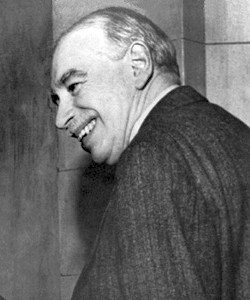
John Maynard Keynes
John Maynard Keynes came to fame after publishing his economic theories during the Great Depression.
At the time, the primary school of economic thought was that of the classical economists (which is still a popular school of thought today). The central tenet of the classical argument says that supply can always create demand, and that surpluses will result in price reductions to the point of consumption. Put simply, people have infinite needs and the market will self-correct to the aggregate demands and available resources. This implies a hands-of public policy where markets are capable of taking care of themselves.
Keynes positioned his argument in contrast to this idea, stating that markets are imperfect and will not always self correct. Keynes theorized that natural inefficiencies in the market will see goods that are not met with demand. This wasted capital can result in market losses, unemployment, and market inefficiency (this was called ‘general glut’ in the classical model, when aggregate demand does not meet supply). Keynes insisted that markets do need moderate governmental intervention through fiscal policy (government investment in infrastructure) and monetary policy (interest rates).
Main Tenets
With this overview in mind, Keynesian Theory generally observes the following concepts:
- Unemployment:Under the classical model, unemployment is often attributed to high and rigid real wages. Keynes argues there is more complexity than that, specifically that societies are highly resistant to wage cuts and furthermore that reducing wages would pose a great threat to an economy. Specifically, cutting wages reduces spending and may result in a downwards spiral.
- Excessive Saving:Keynes’s concept here is somewhat complicated, but in short Keynes notes excessive saving as a threat and prospective cause of economic decline. This is because excessive saving leads to reduced investment and reduced spending, which drives down demand and the potential for consumption. This can be another spiraling issue, as money not being exchanged is actively reducing prospective employment, revenues, and future investments.
- Fiscal Policy:The key concept in fiscal policy for Keynes is ‘counter-cyclical’ fiscal policy, which is the expectation that governments can reduce the negative effects of the natural business cycle. This is, generally, achieved through deficit spending in recessions and suppression of inflation during boom times. Simply put, the government should try to curb the extremes of economic fluctuation through informed fiscal policy.
- The Multiplier Effect: This idea has in many ways already been implied in the atom, but inversely. Consider the unemployment and excessive savings problems, and how they stand to lead to spiraling decline. The other side of that coin is that positive economic situations can spiral upwards. Take for example a government investment in transportation, putting money in the pockets of various individuals who build trains and tracks. These individuals will spend that extra capital, putting money in the hands of other business (and this will continue). This is called the multiplier effect.
- IS-LM : While the IS-LM Model is a complicated byproduct of Keynesian economics, it can be summarized as the relationship between interest rates (y-axis) and the real economic output (x-axis). This is done through analyzing the invest-saving relationship (IS) in contrast to the liquidity preference and money supply relationship (LM), generating an equilibrium where certain interest rates and outputs will be generated.
While Keynesian Theory has been expounded upon significantly over the years, the important takeaway here is that aggregate demand (and thus the amount of supply consumed) is not a perfect system. Instead, demand is affected by various external forces that can create an inefficient market which will in turn affect employment, production, and inflation.

IS-LM Model
In this figure, the IS (Interest – Saving) curve is shifted outward in a way that raises both interest rates (i) and the ‘real’ economy (Y). The implication is that interest rates affect investment levels, and that these investment levels in turn affect the overall economy.
25.1.2: Monetarist
Monetarism focuses on the macroeconomic effects of the supply of money and the role of central banking on an economic system.
Learning Objective
Explain the main tenets of Monetarism
Key Points
- Clark Warburton, in 1945, has been identified as the first thinker to draft an empirically sound argument in favor of monetarism. This was taken more mainstream by Milton Friedman in 1956.
- More money in the system results in higher spending and vice verse. This would theoretically provide some control over aggregate demand.
- Historical implementation of monetarism demonstrated some correlation with control over inflation rates and increased economic performance. This could have been a result of other factors however.
- The Austrian school of economic thought perceives monetarism as somewhat narrow-minded, not effectively taking into account the subjectivity involved in valuing capital.
- Due to the globalization of the economy, monetarism may have a negative impact on external economies. This is particularly true of the U.S., whose capital is an international standard.
Key Terms
- gold standard
-
A monetary system where the value of circulating money is linked to the value of gold.
- Monetarism
-
The doctrine that economic systems are controlled by variations in the supply of money.
Background
In the rise of monetarism as an ideology, two specific economists were critical contributors. Clark Warburton, in 1945, has been identified as the first thinker to draft an empirically sound argument in favor of monetarism. This was taken more mainstream by Milton Friedman in 1956 in a restatement of the quantity theory of money. The basic premise these two economists were putting forward is that the supply of money and the role of central banking play a critical role in macroeconomics.
The generation of this theory takes into account a combination of Keynesian monetary perspectives and Friedman’s pursuit of price stability. Keynes postulated a demand-driven model for currency; a perspective on printed money that was not beholden to the ‘gold standard’ (or basing economic value off of rare metal). Instead, the amount of money in a given environment should be determined by monetary rules. Friedman originally put forward the idea of a ‘k-percent rule,’ which weighed a variety of economic indicators to determine the appropriate money supply.
Evidence
Theoretically, the idea is actually quite straight-forward. When the money supply is expanded, individuals will be induced to higher spending. In turn, when the money supply retracted, individuals would limit their budgetary spending accordingly. This would theoretically provide some control over aggregate demand (which is one of the primary areas of disagreement between Keynesian and classical economists).
Monetarism began to deviate more from Keynesian economics however in the 70’s and 80’s, as active implementation and historical reflection began to generate more evidence for the monetarist view. In 1979 for example, Jimmy Carter appointed Paul Volcker as Chief of the Federal Reserve, who in turn utilized the monetarist perspective to control inflation. He eventually created a price stability, providing evidence that the theory was sound. In addition, Milton Friedman and Ann Schwartz analyzed the Great Depression in the context of monetarism as well, identifying a shortage of the money supply as a critical component of the recession.
The 1980s were an interesting transitional period for this perspective, as early in the decade (1980-1983) monetary policies controlling capital were attributed to substantial reductions in inflation (14% to 3%)(see ). However, unemployment and the rise of the use of credit are quoted as two alternatives to money supply control being the primary influence of the boom that followed 1983.
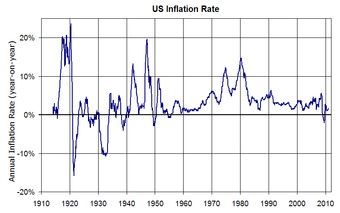
U.S. Inflation Rates
The inflation rates over time in the U.S. represent some of the evidence put forward by monetarist economists, stating that governmental control of the money supply allows for some control over inflation.
Counter Arguments
As these counter arguments in the 1980s began to arise, critics of monetarism became more mainstream. Of the current monetarism critics, the Austrian school of thought is likely the most well-known. The Austrian school of economic thought perceives monetarism as somewhat narrow-minded, not effectively taking into account the subjectivity involved in valuing capital. That is to say that monetarism seems to assume an objective value of capital in an economy, and the subsequent implications on the supply and demand.
Other criticisms revolve around international investment, trade liberalization, and central bank policy. This can be summarized as the effects of globalization, and the interdependence of markets (and consequently currencies). To manipulate money supply there will inherently be effects on other currencies as a result of relativity. This is particularly important in regards to the U.S. currency, which is considered a standard in international markets. Controlling supply and altering value may have effects on a variety of internal economic variables, but it will also have unintended consequences on external variables.
25.1.3: Austrian
Austrian economic thought is about methodological individualism, or the idea that people will act in meaningful ways which can be analyzed.
Learning Objective
Explain the main tenets of Austrian economics
Key Points
- The Austrian school of economics is one of the oldest economic perspectives, originating in the 19th century in Vienna.
- Austrian economics is attributed for the identification of opportunity cost, capital and interest, inflation, business cycles and the organizing power of markets.
- Austrian economists do not often place much weight on concepts such as econometrics, experimental economics, and aggregate macroeconomic analysis. In this sense, the Austrian school of thought is something of an outsider relative to other perspectives (i.e. classical, Keynesian, etc. ).
- Paul Krugman criticized Austrian economics as lacking explicit models of analysis, or essentially a lack of clarity in their approach. This results in inadvertent blind spots.
Key Terms
- Opportunity cost
-
The cost of any activity measured in terms of the value of the next best alternative forgone (that is not chosen).
- time value of money
-
The time value of money is the principle that a certain currency amount of money today has a different buying power (value) than the same currency amount of money in the future.
Background
The Austrian school of economics originated in the 19th century in Vienna, Austria. While there were a variety of famous economists attributed to the early foundations and later expansions of the Austrian economic perspective, Carl Menger, Friedrich von Weiser, and Eugen von Bohm-Bawerk are widely recognized as critical early pioneers. The general perspective of Austrian economic thought is methodological individualism, or the recognition that people will act in meaningful ways which can be analyzed for trends.
Central Tenets
The Austrian school of thought provided enormous value to the economic climate, both as a foundation for future economics and as a deliberate counterpoint to more quantitative analysis. Of the most important ideologies, the following central tenets are:
- Opportunity Cost: This is a concept you are likely already familiar with, and one of the most important ideas in all of business and economics. Essentially, the price of a good must also incorporate the value sacrificed of the next best alternative. Basically each choice a consumer or business makes intrinsically has the cost of not being able to make an alternative choice.
- Capital and Interest: Largely in response to Karl Marx’s labor theories, Austrian economist Bohm-Bawerk identified the building blocks of interest rates and profit are supply and demand alongside time preference. In short, present consumption is more valuable than future consumption (the time value of money).
- Inflation: The idea that prices and wages must rise as a result of increased money supply is inflation (note: this is different that price inflation). Simply put, more money in the system without a higher demand for that money will drive down the relative value of each dollar.
- Business Cycles:The Austrian business cycle theory (ABCT) is the simple observation that the issuance of credit (by banks) creates economic fluctuations that tend to be cyclical (see ). In simple terms, banks will lend out money at rates lower than the risk in which that money will be used. So when businesses fail more often than they succeed, thus losing interest as opposed to accruing it, will struggle to repay their debts. When the banks call in those debts the business cannot pay, creating negative business cycles.
- The Organizing Power of Markets: The idea of this concept is that no one person knows what the appropriate price of a good should be. Instead, markets naturally generate incentives to identify optimal price points. This negates the ideas of socialism common at the time, as communist systems will be unable to identify the appropriate exchange value of each good.
As you can see from the above points, this school of economics is largely about making qualitative observations of the markets. These observations are absolutely critical in understanding the theoretical landscape, but difficult to enact in practice.
Criticisms
Austrian economists are often criticized for ignoring arithmetic or statistical ways to measure and analyze economics. Indeed, Austrian economists do not often place much weight on concepts such as econometrics, experimental economics, and aggregate macroeconomic analysis. In this sense, the Austrian school of thought is something of an outsider relative to other perspectives (i.e. classical, Keynesian, etc.).
Paul Krugman criticized Austrian economics as lacking explicit models of analysis, or essentially a lack of clarity in their approach. This results in inadvertent blind spots. This is a sensible criticism in many ways, as the fundamental idea behind this economic theory is that it is driven by individuals and individuals are not always rational (indeed, they are quite often irrational). As a result of this, Austrian economics often rests on the integration of social sciences (psychology, sociology, etc.) to explain preferences and consumer behavior, which is often counter-intuitive. As a result, it is very difficult to accurately measure and provide tangible proof of the efficacy of Austrian models.
25.1.4: Alternative Views
Neoclassical and neo-Keynesian ideas can be coupled and referred to as the neoclassical synthesis, combining alternative views in economics.
Learning Objective
Summarize neoclassical and Neo-Keynesian economics
Key Points
- The history of different economic schools of thought have consistently generated evolving theories of economics as new data and new perspectives are taken into consideration.
- The neoclassical perspective in conjunction with Keynesian ideas is referred to as the neoclassical synthesis, which is largely considered the ‘mainstream’ economic perspective.
- A critical difference between classical and neoclassical perspectives is the introduction of marginalism. Marginalism notes that economic participants make decisions based on marginal utility or margins.
- Neo-Keynesian economics is the formalization and coordination of Keynes’s writings by a number of other economists (most notably John Hicks, Franco Modigliani and Paul Samuelson).
- The important to understand that these economic perspectives add value to one another and the overall efficacy of all economic theory.
Key Terms
- static
-
Unchanging; that cannot or does not change.
- stagflation
-
Inflation accompanied by stagnant growth, unemployment or recession.
Background
The history of different economic schools of thought have consistently generated evolving theories of economics as new data and new perspectives are taken into consideration. The two most well-known schools, classical economics and Keynesian economics, have been adapting to incorporate new information and ideas from one another as well as lesser known schools of economics (Chicago, Austrian, etc.). These different perspectives have motivated economists to generate the neoclassical and neo-Keynesian perspectives. The neoclassical perspective, in conjunction with Keynesian ideas, is referred to as the neoclassical synthesis, which is largely considered the ‘mainstream’ economic perspective.
Neoclassical
In approaching Neoclassical economics, it is most important to keep in mind the following three principles:
- People have rational preferences in the context of options or outcomes that can be identified and associated with a given value (usually monetary). In short, people make smart choices regarding how they spend their money.
- Individuals maximize utility and firms maximize profit. People will try to get the most from their money while corporations will try to invest their time and assets to capture the highest margin.
- People act independently based upon comprehensive and relevant information. People are influenced by rational forces (mostly information and logic), and will make the best personal purchasing decisions based upon this.
A brief timeline of classical to neoclassical perspectives would begin with thought processes put forward by Adam Smith and David Ricardo (alongside many others). The basic idea is that aggregate demand will adjust to supply, and that value theory and distribution will reflect this rational, cost of production model. The next phase was the observation that consumer goods demonstrated a relative value based on utility, which could deviate from consumer to consumer. The final phase, and most central to the advent of the neoclassical perspective, is the introduction of marginalism. Marginalism notes that economic participants make decisions based on marginal utility or margins. For example, a company hiring a new employee will not think of the fixed value of that employee, but instead the marginal value of adding that employee (usually in regards to profitability).
Neo-Keynesian
Neo-Keynesian economics is often confused with ‘New Keynesian’ economics (which attempts to provide microeconomic foundation to Keynesian views, particularly in light of stagflation in the 1970s). Neo-Keynesian economics is actually the formalization and coordination of Keynes’s writings by a number of other economists (most notably John Hicks, Franco Modigliani, and Paul Samuelson). Much of the conceptual value is captured in the previous atoms on Keynesian views, but the substantial value of a few neo-Keynesian ideas is worth reiterating:
- IS/LM Model: This model was put forward by John Hicks in order to capture the inherent relationship between investment and savings (IS) relative to liquidity and the overall money supply (LM) (see ). The implications of this graph pertain to the static representation of monetary policy and the effects on an economic system.
- Phillips Curve: Another important model following Keynes’s publications is the Phillips Curve, put forward by William Phillips in 1958. The idea here was also largely Keynesian, revolving around the relationship between inflation and unemployment (see ).This implies a trade off between inflation rates and the creation of employment, which governments could consider in policy making. Stagflation (economic stagnation and inflation simultaneously) created issues with this however, necessitating New Keynesian ideas (as discussed briefly above).
Synthesis
When learning about these economic perspectives, it is important to understand the value they add to one another and the overall efficacy of all economic theory. Economists are often the product of multiple schools of thought, and don’t fit neatly into one school or another.
Chapter 24: Aggregate Demand and Supply
24.1: Introducing Aggregate Expenditure
24.1.1: Defining Aggregate Expenditure: Components and Comparison to GDP
Aggregate expenditure is the current value of all the finished goods and services in the economy.
Learning Objective
Define aggregate expenditure
Key Points
- The aggregate expenditure is the sum of all the expenditures undertaken in the economy by the factors during a specific time period. The equation is: AE = C + I + G + NX.
- The aggregate expenditure determines the total amount that firms and households plan to spend on goods and services at each level of income.
- The aggregate expenditure is one of the methods that is used to calculate the total sum of all the economic activities in an economy, also known as the gross domestic product (GDP).
- When there is excess supply over the expenditure, there is a reduction in either the prices or the quantity of the output which reduces the total output (GDP) of the economy.
- When there is an excess of expenditure over supply, there is excess demand which leads to an increase in prices or output (higher GDP).
Key Terms
- aggregate
-
A mass, assemblage, or sum of particulars; something consisting of elements but considered as a whole.
- expenditure
-
Act of expending or paying out.
- gross domestic product
-
A measure of the economic production of a particular territory in financial capital terms over a specific time period.
Aggregate Expenditure
In economics, aggregate expenditure is the current value of all the finished goods and services in the economy. It is the sum of all the expenditures undertaken in the economy by the factors during a specific time period. The equation for aggregate expenditure is: AE = C + I + G + NX.
Written out the equation is: aggregate expenditure equals the sum of the household consumption (C), investments (I), government spending (G), and net exports (NX).
- Consumption (C): The household consumption over a period of time.
- Investment (I): The amount of expenditure towards the capital goods.
- Government expenditure (G): The amount of spending by federal, state, and local governments. Government expenditure can include infrastructure or transfers which increase the total expenditure in the economy.
- Net exports (NX): Total exports minus the total imports.
The aggregate expenditure determines the total amount that firms and households plan to spend on goods and services at each level of income.
Comparison to GDP
The aggregate expenditure is one of the methods that is used to calculate the total sum of all the economic activities in an economy, also known as the gross domestic product (GDP). The gross domestic product is important because it measures the growth of the economy. The GDP is calculated using the Aggregate Expenditures Model .
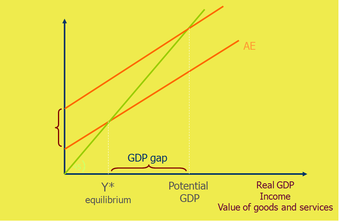
Aggregate Expenditure
This graph shows the aggregate expenditure model. It is used to determine and graph the real GPD, potential GDP, and point of equilibrium. A shift in supply or demand impacts the GDP.
An economy is at equilibrium when aggregate expenditure is equal to the aggregate supply (production) in the economy. The economy is not in a constant state of equilibrium. Instead, the aggregate expenditure and aggregate supply adjust each other toward equilibrium.
When there is excess supply over the expenditure, there is a reduction in either the prices or the quantity of the output which reduces the total output (GDP) of the economy.
In contrast, when there is an excess of expenditure over supply, there is excess demand which leads to an increase in prices or output (higher GDP). A rise in the aggregate expenditure pushes the economy towards a higher equilibrium and a higher potential of the GDP.
24.1.2: Aggregate Expenditure at Economic Equilibrium
An economy is said to be at equilibrium when aggregate expenditure is equal to the aggregate supply (production) in the economy.
Learning Objective
Identify the assumptions fundamental to classical economics in regards to aggregate expenditure at economic equilibrium
Key Points
- In economics, aggregate expenditure is the current value (price) of all the finished goods and services in the economy. The equation for aggregate expenditure is AE = C+ I + G + NX.
- In the aggregate expenditure model, equilibrium is the point where the aggregate supply and aggregate expenditure curve intersect.
- The classical aggregate expenditure model is: AE = C + I.
- Classical economics states that the factor payments made during the production process create enough income in the economy to create a demand for the products that were produced.
Key Terms
- aggregate
-
A mass, assemblage, or sum of particulars; something consisting of elements but considered as a whole.
- expenditure
-
Act of expending or paying out.
- equilibrium
-
The condition of a system in which competing influences are balanced, resulting in no net change.
Aggregate Expenditure
In economics, aggregate expenditure is the current value (price) of all the finished goods and services in the economy. The equation for aggregate expenditure is AE = C+ I + G + NX.
Written out in full, the equation reads: aggregate expenditure = household consumption (C) + investments (I) + government spending (G) + net exports (NX).
Aggregate expenditure is a method that is used to calculate the total value of economic activities, also referred to as the gross domestic product (GDP). The GDP of an economy is calculated using the aggregate expenditure model.
Economic Equilibrium
An economy is said to be at equilibrium when aggregate expenditure is equal to the aggregate supply (production) in the economy. The economy is constantly shifting between excess supply (inventory) and excess demand. As a result, the economy is always moving towards an equilibrium between the aggregate expenditure and aggregate supply. On the aggregate expenditure model, equilibrium is the point where the aggregate supply and aggregate expenditure curve intersect. An increase in the expenditure by consumption (C) or investment (I) causes the aggregate expenditure to rise which pushes the economy towards a higher equilibrium .

Aggregate Expenditure – Equilibrium
In this graph, equilibrium is reached when the total demand (AD) equals the total amount of output (Y). The equilibrium point is where the blue line intersects with the black line.
Classical Economics – Aggregate Expenditure
Classical economists believed in Say’s law, which states that supply creates its own demand. This idea stems from the belief that wages, prices, and interest rage were all flexible. Classical economics states that the factor payments (wage and rental payments) made during the production process create enough income in the economy to create a demand for the products that were produced. This belief is parallel to Adam Smith’s invisible hand – markets achieve equilibrium through the market forces that impact economic activity.
The classical aggregate expenditure model is: AE = C + I .
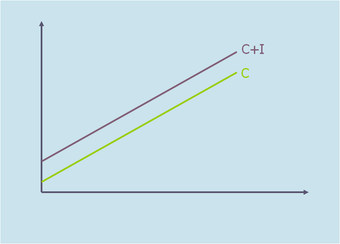
Classical Aggregate Expenditure
This graph shows the classical aggregate expenditure where C is consumption expenditure and I is aggregate investment. The aggregate expenditure is the aggregate consumption plus the planned investment (AE = C + I).
The aggregate expenditure equals the aggregate consumption plus planned investment. Classical economics assumes that the economy works on a full-employment equilibrium, which is not always true. In reality, many economists argue that the economy operates at an under-employment equilibrium.
24.1.3: Graphing Equilibrium
An economy is said to be at equilibrium when the aggregate expenditure is equal to the aggregate supply (production) in the economy.
Learning Objective
Demonstrate how aggregate demand and aggregate supply determine output and price level by using the AD-AS model
Key Points
- Aggregate supply (AS) is the total supply of goods and services that firms in an economy plan on selling during a specific time period.
- Aggregate demand (AD) is the total demand for final goods and services in the economy at a given time and price level.
- Aggregate expenditure is the current value of all the finished goods and services in the economy. The equation for aggregate expenditure is: AE = C + I + G + NX.
- The AD-AS model is used to graph the aggregate expenditure at the point of equilibrium.
Key Terms
- equilibrium
-
The condition of a system in which competing influences are balanced, resulting in no net change.
- aggregate demand
-
The the total demand for final goods and services in the economy at a given time and price level.
- aggregate supply
-
The total supply of goods and services that firms in a national economy plan on selling during a specific time period.
Aggregate Supply and Aggregate Demand
In economics, the aggregate supply (AS) is the total supply of goods and services that firms in an economy produce during a specific time period. It represents the total amount of goods and services that firms are willing to sell at a given price level. The aggregate supply curve is graphed as a backwards L-shape in the short-run and vertical in the long-run.
Aggregate demand (AD) is the total demand for final goods and services in the economy at a given time and price level. It shows the amounts of goods and services that will be purchased at all the possible price levels. When aggregate demand increases its graph shifts to the right. It shifts to the left when it decreases which shows a fall in output and prices.
The aggregate supply and aggregate demand determine the output and price for goods and services. The AD-AS model is used to graph the aggregate expenditure and the point of equilibrium .

AD-AS Model
This graph shows the AD-AS model where P is the average price level and Y* is the aggregate quantity demanded. The model is used to show how increases in aggregate demand leads to increases in prices (inflation) and in output.
Aggregate Expenditure
Aggregate expenditure is the current value of all the finished goods and services in the economy. The equation for aggregate expenditure is: AE = C + I + G + NX.
The aggregate expenditure equals the sum of the household consumption (C), investments (I), government spending (G), and net exports (NX).
Graphing Equilibrium
The AD-AS model is used to graph the aggregate expenditure at the point of equilibrium. The AD-AS model includes price changes. An economy is said to be at equilibrium when the aggregate expenditure is equal to the aggregate supply (production) in the economy. It is important to note that the economy does not stay in a state of equilibrium. The aggregate expenditure and aggregate supply adjust each other towards equilibrium. When there is excess supply over expenditure, there is a reduction in the prices or the quantity or output. When there is an excess of expenditure over supply, then there is excess demand which leads to an increase in prices out output. In an effort to adjust and reach equilibrium, the economy constantly shifts between excess supply and excess demand. This shift is graphed using the AD-AS model which determines the output and price for the good or service.
24.1.4: The Multiplier Effect
When the fiscal multiplier exceeds one, the resulting impact on the national income is called the multiplier effect.
Learning Objective
Explain the fiscal multiplier effect
Key Points
- In economics, the fiscal multiplier is the ratio of change in the national income in relation to the change in government spending that causes it.
- The multiplier is influenced by an incremental amount of spending that leads to higher consumption spending, increased income, and then even more consumption. As a result, the overall national income is greater than the initial incremental amount of spending.
- The multiplier effect is a tool that is used by governments to attempt to stimulate aggregate demand in times of recession or economic uncertainty.
- The multiplier effect is criticized because it can create over crowding and an increase in the number of negative externalities.
Key Terms
- fiscal multiplier
-
The ratio of a change in national income to the change in government spending that causes it.
- multiplier effect
-
A factor of proportionality that measures how much an endogenous variable changes in response to a change in some exogenous variable.
The Fiscal Multiplier and the Multiplier Effect
In economics, the fiscal multiplier is the ratio of change in the national income in relation to the change in government spending that causes it (not to be confused with the monetary multiplier). National income can change as a direct result in a change in spending whether it is private investment spending, consumer spending, government spending, or foreign export spending. When the fiscal multiplier exceeds one, the resulting impact on the national income is called the multiplier effect.
Cause of the Multiplier Effect
The multiplier is influenced by an incremental amount of spending that leads to higher consumption spending, increased income, and then even more consumption. As a result, the overall national income is greater than the initial incremental amount of spending. Simply put, an initial shift in aggregate demand may cause a change in aggregate output (as well as the aggregate income it creates) that is a multiplier of the initial change.
Use of the Multiplier Effect
The multiplier effect is a tool that is used by governments to attempt to stimulate aggregate demand in times of recession or economic uncertainty . The government invests money in order to create more jobs, which in turn will generate more spending to stimulate the economy. The goal is that the net increase in disposable income will be greater than the original investment.
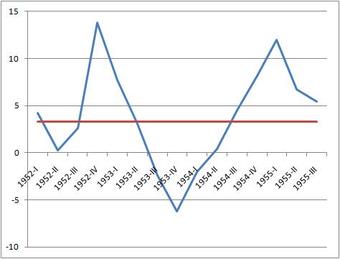
1953 U.S. Recession
This graph shows the economic recession that occurred in the U.S. in 1953. During recessions, the government can use the multiplier effect in order to stimulate the economy.
Criticisms
Although the multiplier effect usually measures values of one, there have been cases where multipliers of less than one are measured. This suggests that types of government spending can crowd out private investment or consumer spending that would have taken place without the government spending. Crowding out can occur because the initial increase in spending can cause an increase in the interest rates or the price level.
It has been argued that when a government relies heavily on fiscal multipliers, externalities such as environmental degradation, unsustainable resource depletion, and social consequences can be neglected. Over reliance on fiscal multipliers can cause increased government spending on activities that create negative externalities (pollution, climate change, and resource depletion) instead of positive externalities (increased educational standards, social cohesion, public health, etc.).
24.2: Introducing Aggregate Demand and Aggregate Supply
24.2.1: Explaining Fluctuations in Output
In the short run, output fluctuates with shifts in either aggregate supply or aggregate demand; in the long run, only aggregate supply affects output.
Learning Objective
Differentiate between short-run and long-run effects of nominal fluctuations
Key Points
- In the short run, output is determined by both the aggregate supply and aggregate demand within an economy. Anything that causes labor, capital, or efficiency to go up or down results in fluctuations in economic output.
- Aggregate supply and aggregate demand are graphed together to determine equilibrium. The equilibrium is the point where supply and demand meet.
- According to Hume, in the short-run, and increase in the money supply will lead to an increase in production.
- According to Hume, in the long-run, an increase in the money supply will do nothing.
Key Terms
- economic output
-
The productivity of a country or region measured by the value of goods and services produced.
- nominal
-
Without adjustment to remove the effects of inflation (in contrast to real).
Economic Output
In economics, output is the quantity of goods and services produced in a given time period. The level of output is determined by both the aggregate supply and aggregate demand within an economy. National output is what makes a country rich, not large amounts of money. For this reason, understanding the fluctuations in economic output is critical for long term growth. There are a series of factors that influence fluctuations in economic output including increases in growth and inputs in factors of production. Anything that causes labor, capital, or efficiency to go up or down results in fluctuations in economic output.
Aggregate Supply and Aggregate Demand
Aggregate supply is the total amount of goods and services that firms are willing to sell at a given price in an economy. The aggregate demand is the total amounts of goods and services that will be purchased at all possible price levels.
In a standard AS-AD model, the output (Y) is the x-axis and price (P) is the y-axis. Aggregate supply and aggregate demand are graphed together to determine equilibrium. The equilibrium is the point where supply and demand meet to determine the output of a good or service.
Short-run vs. Long-run Fluctuations
Supply and demand may fluctuate for a number of reasons, and this in turn may affect the level of output. There are noticeable differences between short-run and long-run fluctuations in output.
Over the short-run, an outward shift in the aggregate supply curve would result in increased output and lower prices. An outward shift in the aggregate demand curve would also increase output and raise prices. Short-run nominal fluctuations result in a change in the output level . In the short-run an increase in money will increase production due to a shift in the aggregate supply. More goods are produced because the output is increased and more goods are bought because of the lower prices.

AS-AD Model
This AS-AD model shows how the aggregate supply and aggregate demand are graphed to show economic output. The AD curve shifts to the right which increases output and price.
In the long-run, the aggregate supply curve and aggregate demand curve are only affected by capital, labor, and technology. Everything in the economy is assumed to be optimal. The aggregate supply curve is vertical which reflects economists’ belief that changes in aggregate demand only temporarily change the economy’s total output. In the long-run an increase in money will do nothing for output, but it will increase prices.
24.2.2: Classical Theory
Classical theory, the first modern school of economic thought, reoriented economics from individual interests to national interests.
Learning Objective
Identify the assumptions fundamental to classical economics
Key Points
- When classical theory emerged, society was undergoing many changes. The primary economic question involved how a society could be organized around a system in which every individual sought his own monetary gain.
- Classical economics focuses on the growth in the wealth of nations and promotes policies that create national economic expansion.
- Classical theory assumptions include the beliefs that markets self-regulate, prices are flexible for goods and wages, supply creates its own demand, and there is equality between savings and investments.
Key Term
- self-regulating
-
Describing something capable of controlling itself.
Classical Theory
Classical theory was the first modern school of economic thought. It began in 1776 and ended around 1870 with the beginning of neoclassical economics. Notable classical economists include Adam Smith, Jean-Baptiste Say, David Ricardo, Thomas Malthus, and John Stuart Mill . During the period in which classical theory emerged, society was undergoing many changes. The primary economic question involved how a society could be organized around a system in which every individual sought his own monetary gain. It was not possible for a society to grow as a unit unless its members were committed to working together. Classical theory reoriented economics away from individual interests to national interests. Classical economics focuses on the growth in the wealth of nations and promotes policies that create national expansion. During this time period, theorists developed the theory of value or price which allowed for further analysis of markets and wealth. It analyzed and explained the price of goods and services in addition to the exchange value.

Adam Smith
Adam Smith was one of the individuals who helped establish classical economic theory.
Classical Theory Assumptions
Classical theory was developed according to specific economic assumptions:
- Self-regulating markets: classical theorists believed that free markets regulate themselves when they are free of any intervention. Adam Smith referred to the market’s ability to self-regulate as the “invisible hand” because markets move towards their natural equilibrium without outside intervention.
- Flexible prices: classical economics assumes that prices are flexible for goods and wages. They also assumed that money only affects price and wage levels.
- Supply creates its own demand: based on Say’s Law, classical theorists believed that supply creates its own demand. Production will generate an income enough to purchase all of the output produced. Classical economics assumes that there will be a net saving or spending of cash or financial instruments.
- Equality of savings and investment: classical theory assumes that flexible interest rates will always maintain equilibrium.
- Calculating real GDP: classical theorists determined that the real GDP can be calculated without knowing the money supply or inflation rate.
- Real and Nominal Variables: classical economists stated that real and nominal variables can be analyzed separately.
24.2.3: Keynesian Theory
Keynesian economics states that in the short-run, economic output is substantially influenced by aggregate demand.
Learning Objective
Differentiate “Chicago School” or “Austrian School” economists from “Keynesian School” economists
Key Points
- Keynesian theory was first introduced by British economist John Maynard Keynes in his book The General Theory of Employment, Interest, and Money, which was published in 1936 during the Great Depression.
- Keynesian theorists believe that aggregate demand is influenced by a series of factors and responds unexpectedly. Shifts in aggregate demand impact production, employment, and inflation in the economy.
- Unemployment is the result of structural inadequacies within the economic system. It is not a product of laziness as believed previously.
- During a recession the economy may not return naturally to full employment. The government must step in and utilize government spending to stimulate economic growth. A lack of investment in goods and services causes the economy to operate below its potential output and growth rate.
- Overcoming an economic depression required economic stimulus, which could be achieved by cutting interest rates and increasing the level of government investment.
Key Term
- Keynesian Economics
-
A school of thought that is characterized by a belief in active government intervention in an economy and the use of monetary policy to promote growth and stability.
Keynesian Theory
In economics, the Keynesian theory was first introduced by British economist John Maynard Keynes in his book The General Theory of Employment, Interest, and Money which was published in 1936 during the Great Depression . Keynesian economics states that in the short-run, especially during recessions, economic output is substantially influenced by aggregate demand (the total spending in the economy). According to the Keynesian theory, aggregate demand does not necessarily equal the productive capacity of the economy. Keynesian theorists believe that aggregate demand is influenced by a series of factors and responds unexpectedly. The shift in aggregate demand impacts production, employment, and inflation in the economy.
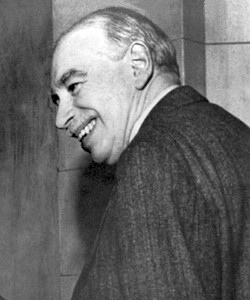
John Maynard Keynes
John Maynard Keynes introduced Keynesian theory in his book, The General Theory of Employment, Interest, and Money.
Economic Thought
At the time that Keynesian theory was developed, mainstream economic thought believed that the economy existed in a state of general equilibrium. The belief was that the economy naturally consumes whatever it produces because the act of producing creates enough income in the economy for that consumption to take place.
Keynesian theory has certain characteristic beliefs:
- Unemployment is the result of structural inadequacies within the economic system. It is not a product of laziness as believed previously.
- During a recession, the economy may not return naturally to full employment. The government must step in and utilize government spending to stimulate economic growth. A lack of investment in goods and services causes the economy to operate below its potential output and growth rate.
- An active stabilization policy is needed to reduce the amplitude of the business cycle. Keynesian economists believed that aggregate demand for goods and services not meeting the supply was one of the most serious economic problems.
- Excessive saving, saving beyond investment, is a serious problem that encouraged recession and even depression.
- Cutting wages will not cure a recession.
- Overcoming an economic depression requires economic stimulus, which could be achieved by cutting interest rates and increasing the level of government investment.
Schools of Economic Thought
It is important to understand the stances of the various school of economic thought. Although the beliefs of each school vary, all of the schools of economic thought have contributed to economic theory is some way.
The Keynesian School of economic thought emphasized the need for government intervention in order to stabilize and stimulate the economy during a recession or depression. In contrast, the Chicago School of economic thought focused price theory, rational expectations, and free market policies with little government intervention. The Austrian School of economic thought focused on the belief that all economic phenomena are caused by the subjective choices of individuals. Unlike other schools, the Austrian school focused on individual actions instead of society as a whole.
24.3: Aggregate Demand
24.3.1: Introducing Aggregate Demand
Aggregate demand (AD) is defined as the total demand for final goods and services in a given economy at a specific time.
Learning Objective
Define Aggregate Demand
Key Points
- To put it simply, AD is the sum of all demand in an economy. It is often called the effective demand or aggregate expenditure (AE), and is the demand of all gross domestic product (GDP).
- In summary, the calculation of aggregate demand can be represented as follows: AD = Consumption + Investment + Government spending + Net export (exports – imports).
- Many societies have increasingly adopted debt and credit as an integral part of their economic system. This has justified the incorporation of debt (also called the credit impulse) into the larger framework of aggregate demand.
- There is some loss of accuracy in combining such a diverse array of economic inputs when calculating aggregate demand.
Key Terms
- expenditure
-
The act of incurring a cost or pay out.
- aggregate demand
-
In macroeconomics, aggregate demand (AD) is the total demand for final goods and services in the economy at a given time and price level.
Aggregate demand (AD) is defined as the total demand for final goods and services in a given economy at a specific time. Unlike other illustrations of demand, it is inclusive of all amounts of the product or service purchased at any possible price level. Simply put, AD is the sum of all demand in an economy. It is often called the effective demand or aggregate expenditure (AE), and is the demand of all gross domestic product (GDP).
Demand Sources
- Consumption (C): This is the simplest and largest component of aggregate demand (usually 40-60% of all demand), and is often what is intuitively thought of as demand. Consumption is just the amount of consumer spending executed in an economy. Taxes play a role in this exchange as well (i.e. sales tax).
- Investment (I):Investment is a relatively large portion of demand as well, and is referred to as Gross Domestic Fixed Capital Formation. This is the money spent by firms on capital investment (new machinery, factories, stocks, etc.). Investment equates to about 10% of GDP in most economies.
- Government Spending (G):This is referred to as General Government Final Consumption, and is the expenditure by the government. This can include welfare, social services, education, military, etc. Fiscal policy is the way in which governments can alter this spending to drive economic change.
- Net Export (NX):This can be put simply as the sale of goods to foreign countries subtracted by the purchase of goods from other countries (X-M). Trade surpluses and deficits can occur based on whether or not exports or imports are higher.
In summary, the calculation of aggregate demand can be represented as follows: AD = C + I + G + (X-M). The full sum of all demand in an economy takes into account each of these factors in a quantitative way. This curve is illustrated in the figure .

Aggregate Demand and Supply
This graph demonstrates the basic relationship between aggregate demand and aggregate supply. The aggregate demand curve is derived via the consumption, investment, government spending, and net export.
The Role of Debt
Many societies have increasingly adopted debt and credit as an integral part of their economic system. This has justified the incorporation of debt (also called the credit impulse) into the larger framework of aggregate demand. From a quantitative perspective this is simply expressed as: Spending = Income + Net Increase in Debt. Spending capital prior to the receipt of capital is an important consideration at both the consumer level and the government level (deficit spending).
The Aggregation Problem
There are some limitations to the aggregation perspective, generally summarized as the aggregation problem. The difficulty arises in treating all consumer preferences (and thus their respective demands) as homogeneous and continuous. As the numbers of consumers, the tastes of consumers and the distribution levels of incomes will alter, so too will the demand curve. This can create inaccurate assumptions in AD inputs. Simply, there is some loss of accuracy in combining such a diverse array of economic inputs.
24.3.2: The Slope of the Aggregate Demand Curve
Due to Pigou’s Wealth Effect, the Keynes’ Interest Rate Effect, and the Mundell-Fleming Exchange Rate Effect, the AD curve slopes downward.
Learning Objective
Explain the factors that influence the slope of the aggregate demand curve
Key Points
- Pigou’s Wealth Effect, the Keynes’ Interest Rate Effect, and the Mundell-Fleming Exchange Rate Effect are all theoretical inputs that reaffirm a downwards slope for aggregate demand (AD).
- The critical takeaway from Keynes’s perspective on the slope of the aggregate demand curve is that interest rates affect expenditures more than they affect savings. As a result, insufficient AD is not sustainable in a given system.
- The simplest way to put to wealth effect is that an increase in spending will denote an increase in wealth.
- Robert Mundell and Marcus Fleming noted that incorporating the nominal exchange rate into the mix makes it impossible to maintain free capital movement, a fixed exchange rate and independent monetary policy.
- While these varying effects make the concept of aggregate demand slopes seem somewhat complicated, the most important thing to keep in mind is that people will be demanding more goods when they are cheaper.
Key Term
- liquidity trap
-
Injections of cash into the private banking system by a central bank fail to lower interest rates and stimulate economic growth.
Aggregate demand (AD) is the total demand for all goods within a given market at a given time, or the summation of demand curves within a system. Understanding the basic graphical representation of this curve is useful in grasping the implications of AD on an economic system, as well as the distinct effects which drive it. As a result of Keynes’ interest rate effect, Pigou’s wealth effect, and the Mundell-Fleming exchange rate effect, the AD curve is downward sloping.
Keynes’ Interest Rate Effect
The critical point from Keynes’s perspective on the slope of the aggregate demand curve is that interest rates affect expenditures more than they affect savings. If prices fall, a given amount of money will increase in value. This will drive up interest rates and investments. It is important to note that insufficient demand in a market will not go on forever.
In understanding this fully, it is useful to look at an IS-LM graph (see ). There are only two times when the Keynes observation on the interest rate effect will be inaccurate, and that is if the IS (investment savings) curve were to be vertical or if the LM (liquidity preference money supply) curve were to be horizontal. This makes sense if you think about it, it would basically equate to a liquidity trap. A vertical IS curve or a horizontal LM curve would essentially negate the way in which interest rates could affect aggregate demand.

IS-LM Model
The IS-LM model takes investments and savings and compares that to liquidity and the overall money supply. It is highly useful in understanding macroeconomics from a Keynesian perspective. Interest rates (i) are on the vertical axis, and output (y) is on the horizontal axis.
Pigou’s Wealth Effect
In the context of the above discussion on Keynes, Pigou’s Wealth Effect underlines the fact that liquidity traps are not sustainable. The simplest way to explain the Wealth Effect is that an increase in spending will denote an increase in wealth. In many ways, what Pigou is putting forward is the idea that downwards spiral on the IS-LM model , as predicted by Keynes due to deflation, will be counterbalanced by an increase in real wages and thus an increase in expenditure. In other words, a decrease in employment and prices will eventually see higher purchasing power and an increase in spending, creating wealth.
Mundell-Fleming Exchange Rate Effect
Perhaps the most complex of the three inputs underlined in deriving aggregate demand is the Mundell-Fleming Exchange Rate Effect. Just like the previous two, this builds off of the IS-LM model in a way that discusses it in the context of an open economy (as opposed to a closed system). It essentially takes into account a new factor (in addition to interest rates and outputs, as the traditional IS-LM model incorporates). This new factor is the exchange rates, as the name implies. Robert Mundell and Marcus Fleming noted that incorporating the nominal exchange rate into the mix makes it impossible to maintain free capital movement, a fixed exchange rate and independent monetary policy. This is sometimes referred to as the ‘impossible trinity,’ implying that trade-offs must be made. This concept is illustrated fairly well in this figure , where ‘FE’ is fixed expenditure.

Mundell-Fleming Fixed Exchange Rate Illustration
An increase in government spending forces the monetary authority to supply the market with local currency to keep the exchange rate unchanged. Shown here is the case of perfect capital mobility, in which the BoP curve (or, as denoted here, the FE curve) is horizontal.
Conclusion
While these varying effects make the concept of aggregate demand slopes seem somewhat complicated, the most important thing to keep in mind is that people will be demanding more goods when they are cheaper. The analysis of interest rates displayed above, through the wealth effect in particular, offsets the negative spiral that could occur as a result of deflation and decreased employment. These effects also play a crucial role in understanding the way in which the larger and more complex environment, including investments and fiscal and monetary policy, will retain this downwards slope.
24.3.3: Reasons for and Consequences of Shifts in the Aggregate Demand Curve
An increase in any of the four inputs into AD will result in higher real output or an increase in prices.
Learning Objective
Describe exogenous events that can shift the aggregate demand curve
Key Points
- There are four basic inputs to consider in calculating AD: consumption (C), investment (I), government spending (G) and net exports (NX, which is exports (X) – imports (I)).
- There are a variety of direct and indirect consequences in AD shifts. For the purpose of this discussion, it is most important to keep in mind changes in output and price.
- As the system moves closer to the highest potential output (optimal utilization of resources, or Y*), scarcity will naturally cause prices to increase more than the overall output in a system.
- As the system moves closer to the highest potential output (or optimal utilization of resources, or Y*), scarcity will naturally see the prices increases more so than the overall output in a system.
Key Term
- exogenous
-
Received from outside a group
Aggregate demand (AD) is the summation of all demand within a given economy at a given time.
Inputs
There are four inputs to consider in calculating AD (and deriving the graphical curve which represents it): consumption (C), investment (I), government spending (G), and net exports (NX, which is exports (X) – imports (I)). Changes in these inputs will have some influence on the AD curve. For example, an increase in total expenditures will result in a shift rightwards, while a decrease in expenditure will result in a shift to the left.
Aggregate Demand Curves
Two specific AD representations are useful to consider:
- Keynesian Cross: The Keynesian Cross is a simple illustration of the relationship between aggregate demand and desired total spending (linear at 45 degrees). The intersecting AD line will generally have an upwards slope, under the assumption that increased national output should result in increased disposable income.
- Aggregate Demand/Aggregate Supply Model (AD/AS):The x-axis represents the overall output, while the y-axis represents the price level. The aggregate quantity demanded (Y = C + I + G + NX) is calculated at every given aggregate average price level.
Exogenous Effects
There are a variety of direct and indirect consequences to AD shifts. For the purpose of this discussion, the key consequences to keep in mind are changes in output and price. Below are some of the driving forces that will shift aggregate demand to the right:
- An exogenous increase in consumer spending;
- An exogenous increase in investment spending on physical capital;
- An exogenous increase in intended inventory investment;
- An exogenous increase in government spending on goods and services;
- An exogenous increase in transfer payments from the government to the people;
- An exogenous decrease in taxes levied;
- An exogenous increase in purchases of the country’s exports by people in other countries; and
- An exogenous decrease in imports from other countries.
Short-term Implications
As noted above, any increase in the overall AD will result in an outwards (right-ward) shift of the AD curve. (Conversely, a decrease in aggregate demand will cause a leftward shift of the AD curve. ) This means that an increase in any of the four inputs to AD will result in a higher quantity of real output or an increase in prices across the board (this is also known as inflation). However, different levels of economic activity will result in different combinations of output and price increases.
is useful for understanding the distribution between price increases and output increases that will result in a given economy when AD increases. To put simply, the lower the utilization of available resources in a system, the more an increase in AD will result in higher output and thus higher employment and GDP growth. However, as the system evolves and aligns itself closer to the highest potential output (optimal utilization of resources or Y*), scarcity will naturally cause the prices to increase more than the overall output in a system. This is somewhat intuitive economically when scarcity and utilization are taken into account. The more difficult it is to generate a supply increase the more likely a shift in AD will drive up prices.

Aggregate Supply/Aggregate Demand
This graph illustrates the relationship between price and output within a given economic system in the context of aggregate demand and supply.
24.4: Aggregate Supply
24.4.1: Introducing Aggregate Supply
Aggregate supply is the total supply of goods and services that firms in a national economy plan to sell during a specific time period.
Learning Objective
Define Aggregate Supply
Key Points
- Aggregate supply is the relationship between the price level and the production of the economy.
- In the short-run, the aggregate supply is graphed as an upward sloping curve.
- The short-run aggregate supply equation is: Y = Y* + α(P-Pe). In the equation, Y is the production of the economy, Y* is the natural level of production of the economy, the coefficient α is always greater than 0, P is the price level, and Pe is the expected price level from consumers.
- In the long-run, the aggregate supply is graphed vertically on the supply curve.
- The equation used to determine the long-run aggregate supply is: Y = Y*. In the equation, Y is the production of the economy and Y* is the natural level of production of the economy.
Key Terms
- output
-
Production; quantity produced, created, or completed.
- factor of production
-
A resource employed to produce goods and services, such as labor, land, and capital.
Aggregate Supply
In economics, aggregate supply is the total supply of goods and services that firms in a national economy plan to sell during a specific time period. It is the total amount of goods and services that the firms are willing to sell at a given price level in the economy. Aggregate supply is the relationship between the price level and the production of the economy .
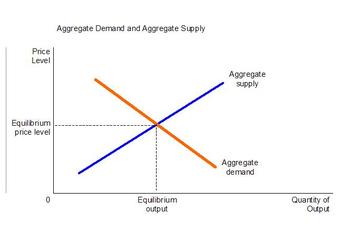
Aggregate Supply
Aggregate supply is the total quantity of goods and services supplied at a given price. Its intersection with aggregate demand determines the equilibrium quantity supplied and price.
Short-run Aggregate Supply
In the short-run, the aggregate supply is graphed as an upward sloping curve. The equation used to determine the short-run aggregate supply is: Y = Y* + α(P-Pe). In the equation, Y is the production of the economy, Y* is the natural level of production of the economy, the coefficient α is always greater than 0, P is the price level, and Pe is the expected price level from consumers.
The short-run aggregate supply curve is upward sloping because the quantity supplied increases when the price rises. In the short-run, firms have one fixed factor of production (usually capital). When the curve shifts outward the output and real GDP increase at a given price. As a result, there is a positive correlation between the price level and output, which is shown on the short-run aggregate supply curve.
Long-run Aggregate Supply
In the long-run, the aggregate supply is graphed vertically on the supply curve. The equation used to determine the long-run aggregate supply is: Y = Y*. In the equation, Y is the production of the economy and Y* is the natural level of production of the economy.
The long-run aggregate supply curve is vertical which reflects economists’ beliefs that changes in the aggregate demand only temporarily change the economy’s total output. In the long-run, only capital, labor, and technology affect aggregate supply because everything in the economy is assumed to be used optimally. The long-run aggregate supply curve is static because it is the slowest aggregate supply curve.
24.4.2: The Slope of the Short-Run Aggregate Supply Curve
In the short-run, the aggregate supply curve is upward sloping.
Learning Objective
Summarize the characteristics of short-run aggregate supply
Key Points
- The AS curve is drawn using a nominal variable, such as the nominal wage rate. In the short-run, the nominal wage rate is fixed. As a result, an increasing price indicates higher profits that justify the expansion of output.
- The AS curve increases because some nominal input prices are fixed in the short-run and as output rises, more production processes encounter bottlenecks.
- In the short-run, the production can be increased without much diminishing returns. The average price level does not have to rise much in order to justify increased production. In this case, the AS curve is flat.
- When demand is high, there are few production processes that have unemployed fixed outputs. Any increase in demand production causes the prices to increase which results in a steep or vertical AS curve.
Key Terms
- supply
-
The amount of some product that producers are willing and able to sell at a given price, all other factors being held constant.
- aggregate
-
A mass, assemblage, or sum of particulars; something consisting of elements but considered as a whole.
Aggregate Supply
Aggregate supply is the total supply of goods and services that firms in a national economy plan to sell during a specific period of time. It is the total amount of goods and services that firms are willing to sell at a given price level.
Short-run Aggregate Supply Curve
In the short-run, the aggregate supply curve is upward sloping. There are two main reasons why the quantity supplied increases as the price rises:
- The AS curve is drawn using a nominal variable, such as the nominal wage rate. In the short-run, the nominal wage rate is fixed. As a result, an increasing price indicates higher profits that justify the expansion of output.
- An alternate model explains that the AS curve increases because some nominal input prices are fixed in the short-run and as output rises, more production processes encounter bottlenecks. At low levels of demand, large numbers of production processes do not make full use of their fixed capital equipment. As a result, production can be increased without much diminishing returns. The average price level does not have to rise much in order to justify increased production. In this case, the AS curve is flat. Likewise, when demand is high, there are few production processes that have unemployed fixed outputs. Any increase in demand production causes the prices to increase which results in a steep or vertical AS curve.
Short-run Aggregate Supply Equation
The equation used to calculate the short-run aggregate supply is: Y = Y* + α(P-Pe). In the equation, Y is the production of the economy, Y* is the natural level of production, coefficient is always positive, P is the price level, and Pe is the expected price level.
In the short-run, firms possess fixed factors of production, including prices, wages, and capital. It is possible for the short-run supply curve to shift outward as a result of an increase in output and real GDP at a given price . As a result, the short-run aggregate supply curve shows the correlation between the price level and output.

Aggregate Supply Curve
This graph shows the aggregate supply curve. In the short-run the aggregate supply curve is upward sloping. When the curve shifts outward, it is due to an increase in output and real GDP.
24.4.3: The Slope of the Long-Run Aggregate Supply Curve
The long-run aggregate supply curve is perfectly vertical; changes in aggregate demand only cause a temporary change in total output.
Learning Objective
Assess factors that influence the shape and movement of the long run aggregate supply curve
Key Points
- The long-run is a planning and implementation phase. It is the conceptual time period in which there are no fixed factors of production.
- In the long-run, only capital, labor, and technology affect the aggregate supply curve because at this point everything in the economy is assumed to be used optimally.
- Aggregate supply is usually inadequate to supply ample opportunity. Often, this is fixed capital equipment. The AS curve is drawn given some nominal variable, such as the nominal wage rate.
- In the long run, the nominal wage rate varies with economic conditions (high unemployment leads to falling nominal wages — and vice-versa).
- The equation used to calculate the long-run aggregate supply is: Y = Y*. In the equation, Y is the level of economic production and Y* is the natural level of production.
Key Term
- long-run
-
The conceptual time period in which there are no fixed factors of production.
Aggregate Supply
In economics, aggregate supply is defined as the total supply of goods and services that firms in a national economy are willing to sell at a given price level.
Long-run in Economics
The long-run is the conceptual time period in which there are no fixed factors of production; all factors can be changed. In the long-run, firms change supply levels in response to expected economic profits or losses.
Long-run Aggregate Supply Curve
In the long-run, only capital, labor, and technology affect the aggregate supply curve because at this point everything in the economy is assumed to be used optimally. The long-run aggregate supply curve is static because it shifts the slowest of the three ranges of the aggregate supply curve. The long-run aggregate supply curve is perfectly vertical, which reflects economists’ belief that the changes in aggregate demand only cause a temporary change in an economy’s total output . In the long-run, there is exactly one quantity that will be supplied.

Aggregate Supply
This graph shows the aggregate supply curve. In the long-run the aggregate supply curve is perfectly vertical, reflecting economists’ belief that changes in aggregate demand only cause a temporary change in an economy’s total output.
The long-run aggregate supply curve can be shifted, when the factors of production change in quantity. For example, if there is an increase in the number of available workers or labor hours in the long run, the aggregate supply curve will shift outward (it is assumed the labor market is always in equilibrium and everyone in the workforce is employed). Similarly, changes in technology can shift the curve by changing the potential output from the same amount of inputs in the long-term.
For the short-run aggregate supply, the quantity supplied increases as the price rises. The AS curve is drawn given some nominal variable, such as the nominal wage rate. In the short run, the nominal wage rate is taken as fixed. Therefore, rising P implies higher profits that justify expansion of output. However, in the long run, the nominal wage rate varies with economic conditions (high unemployment leads to falling nominal wages — and vice-versa).
The equation used to calculate the long-run aggregate supply is: Y = Y*. In the equation, Y is the level of economic production and Y* is the natural level of production.
24.4.4: Moving from Short-Run to Long-Run
In the short-run, the price level of the economy is sticky or fixed; in the long-run, the price level for the economy is completely flexible.
Learning Objective
Recognize the role of capital in the shape and movement of the short-run and long-run aggregate supply curve
Key Points
- When capital increases, the aggregate supply curve will shift to the right, prices will drop, and the quantity of the good or service will increase.
- The short-run aggregate supply curve is an upward slope. The short-run is when all production occurs in real time.
- The long-run curve is perfectly vertical, which reflects economists’ belief that changes in aggregate demand only temporarily change an economy’s total output. The long-run is a planning and implementation stage.
- Aggregate supply moves from short-run to long-run by considering some equilibrium that is the same for both short and long-run when analyzing supply and demand. That state of equilibrium is then compared to the new short-run and long-run equilibrium state from a change that disturbs equilibrium.
Key Term
- capital
-
Already-produced durable goods available for use as a factor of production, such as steam shovels (equipment) and office buildings (structures).
In economics, the short-run is the period when general price level, contractual wages, and expectations do not fully adjust. In contrast, the long-run is the period when the previously mentioned variables adjust fully to the state of the economy.
Aggregate Supply
Aggregate supply is the total amount of goods and services that firms are willing to sell at a given price level.
When capital increases, the aggregate supply curve will shift to the right, prices will drop, and the quantity of the good or service will increase.
Short-run Aggregate Supply
During the short-run, firms possess one fixed factor of production (usually capital). It is possible for the curve to shift outward in the short-run, which results in increased output and real GDP at a given price. In the short-run, there is a positive relationship between the price level and the output . The short-run aggregate supply curve is an upward slope. The short-run is when all production occurs in real time.
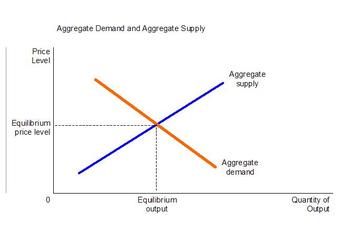
Aggregate Supply
This graph shows the relationship between aggregate supply and aggregate demand in the short-run. The curve is upward sloping and shows a positive correlation between the price level and output.
Long-run Aggregate Supply
In the long-run only capital, labor, and technology impact the aggregate supply curve because at this point everything in the economy is assumed to be used optimally. The long-run supply curve is static and shifts the slowest of all three ranges of the supply curve. The long-run curve is perfectly vertical, which reflects economists’ belief that changes in aggregate demand only temporarily change an economy’s total output. The long-run is a planning and implementation stage.
Moving from Short-run to Long-run
In the short-run, the price level of the economy is sticky or fixed depending on changes in aggregate supply. Also, capital is not fully mobile between sectors.
In the long-run, the price level for the economy is completely flexible in regards to shifts in aggregate supply. There is also full mobility of labor and capital between sectors of the economy.
The aggregate supply moves from short-run to long-run when enough time passes such that no factors are fixed. That state of equilibrium is then compared to the new short-run and long-run equilibrium state if there is a change that disturbs equilibrium.
24.4.5: Reasons for and Consequences of Shifts in the Short-Run Aggregate Supply Curve
The short-run aggregate supply shifts in relation to changes in price level and production.
Learning Objective
Identify common reasons for shifts in the short-run aggregate supply curve, Explain the consequences of shifts in the short-run aggregate supply curve
Key Points
- In the short-run, the aggregate supply curve is upward sloping because some nominal input prices are fixed and as the output rises, more production processes experience bottlenecks.
- At low levels of demand, production can be increased without diminishing returns and the average price level does not rise.
- When the demand is high, few production processes have unemployed fixed inputs. Any increase in demand and production increases the prices.
- Any event that results in a change of production costs shifts the short-run supply curve outwards or inwards if the production costs are decreased or increased.
Key Term
- short-run
-
When one or more factors are fixed.
Aggregate Supply
The aggregate supply is the relation between the price level and production of an economy. It is the total supply of goods and services that firms in a national economy plan on selling during a specific time period at a given price level.
Short-run Aggregate Supply
In the short-run, the aggregate supply curve is upward sloping because some nominal input prices are fixed and as the output rises, more production processes experience bottlenecks. At low levels of demand, production can be increased without diminishing returns and the average price level does not rise. However, when the demand is high, few production processes have unemployed fixed inputs. Any increase in demand and production increases the prices. In the short-run, the general price level, contractual wage rates, and expectations many not fully adjust to the state of the economy.
Shifts in the Short-run Aggregate Supply
The short-run aggregate supply shifts in relation to changes in price level and production. The equation used to determine the short-run aggregate supply is: Y = Y* + α(P-Pe). Y is the production of the economy, Y* is the natural level of production, coefficient α is always positive, P is the price level, and Pe is the expected price level.
In the short-run, examples of events that shift the aggregate supply curve to the right include a decrease in wages, an increase in physical capital stock, or advancement of technology. The short-run curve shifts to the right the price level decreases and the GDP increases. When the curve shifts to the left, the price level increases and the GDP decreases.
Any event that results in a change of production costs shifts the short-run supply curve outwards or inwards if the production costs are decreased or increased . Factors that impact and shift the short-run curve are taxes and subsides, price of labor (wages), and the price of raw materials. Changes in the quantity and quality of labor and capital also influence the short-run aggregate supply curve.

Short-run Aggregate Supply
This graph shows the Aggregate Suppy-Aggregate Demand model. In regards to aggregate supply, increases or decreases in the price level and output cause the aggregate supply curve to shift in the short-run.
24.5: The Aggregate Demand-Supply Model
24.5.1: Macroeconomic Equilibrium
In economics, the macroeconomic equilibrium is a state where aggregate supply equals aggregate demand.
Learning Objective
Analyze aggregate demand and supply in the long run
Key Points
- Equilibrium is the price-quantity pair where the quantity demanded is equal to the quantity supplied.
- In the long-run, increases in aggregate demand cause the output and price of a good or service to increase.
- In the long-run, the aggregate supply is affected only by capital, labor, and technology.
- The aggregate supply determines the extent to which the aggregate demand increases the output and prices of a good or service.
Key Terms
- aggregate
-
A mass, assemblage, or sum of particulars; something consisting of elements but considered as a whole.
- supply
-
The amount of some product that producers are willing and able to sell at a given price, all other factors being held constant.
- demand
-
The desire to purchase goods and services.
Economic Equilibrium
In economics, equilibrium is a state where economic forces (supply and demand) are balanced. Without any external influences, price and quantity will remain at the equilibrium value .

Equilibrium
Similar to microeconomic equilibrium, the macroeconomic equilibrium is the point at which the aggregate supply intersects the aggregate demand.
Supply and Demand
Determining the supply and demand for a good or services provides a model of price determination in a market. In a competitive market, the unit price for a good will vary until it settles at a point where the quantity demanded equals the quantity supplied. The result is the economic equilibrium for that good or service.
There are four basic laws of supply and demand. The laws impact both supply and demand in the long-run.
- If quantity demand increases and supply remains unchanged, a shortage occurs, leading to a higher price until the quantity demanded is pushed back to equilibrium.
- If quantity demand decreases and supply remains unchanged, a surplus occurs, leading to a lower price until the quantity demanded is pushed back to equilibrium.
- If quantity demand remains unchanged and supply increases, a surplus occurs, leading to a lower price until the quantity supplied is pushed back to equilibrium.
- If quantity demand remains unchanged and supply decreases, a shortage occurs, leading to a higher price until the quantity supplied is pushed back to equilibrium.
Aggregate Supply and Aggregate Demand
Aggregate supply is the total supply of goods and services that firms in a national economy plan on selling during a specific time period. It is the total amount of goods and services that firms are willing to sell at a specific price level in an economy .

Aggregate supply
This graph shows the three stages of aggregate supply. It is the total supply of goods and services that firms in a national economy plan to sell during a specific time period. Changes in aggregate supply cause shifts along the supply curve.
Aggregate demand is the total demand for final goods and services in an economy at a given time and price level. It is the demand for the gross domestic product (GDP) of a country.
Aggregate Supply-Aggregate Demand Model
Equilibrium is the price-quantity pair where the quantity demanded is equal to the quantity supplied. It is represented on the AS-AD model where the demand and supply curves intersect. In the long-run, increases in aggregate demand cause the price of a good or service to increase. When the demand increases the aggregate demand curve shifts to the right. In the long-run, the aggregate supply is affected only by capital, labor, and technology. Examples of events that would increase aggregate supply include an increase in population, increased physical capital stock, and technological progress. The aggregate supply determines the extent to which the aggregate demand increases the output and prices of a good or service.
When the aggregate supply and aggregate demand shift, so does the point of equilibrium. The aggregate demand curve shifts and the equilibrium point moves horizontally along the aggregate supply curve until it reaches the new aggregate demand point.
24.5.2: Reasons for and Consequences of Shift in Aggregate Demand
A short-run shift in aggregate demand can change the equilibrium price and output level.
Learning Objective
Explain the causes of economic fluctuations using aggregate demand curves
Key Points
- The aggregate supply curve determines the extent to which increases in aggregate demand lead to increases in real output or increases in prices.
- The equation used to calculate aggregate demand is: AD = C + I + G + (X – M).
- The aggregate demand curve shifts to the right as a result of monetary expansion.
- If the monetary supply decreases, the demand curve will shift to the left.
Key Terms
- aggregate demand
-
The the total demand for final goods and services in the economy at a given time and price level.
- Supply curve
-
A graph that illustrates the relationship between the price of a good and the quantity supplied.
- output
-
Production; quantity produced, created, or completed.
Aggregate Demand
In economics, aggregate demand is the total demand for final goods and services at a given time and price level. It gives the amounts of goods and services that will be demanded at all possible price levels, which, unless there are shortages, is equivalent to GDP. Aggregate demand equals the sum of consumption (C), investment (I), government spending (G), and net export (X -M). This is often written as an equation, which is given by:
AD = C + I + G + (X – M).
Shifts in the Aggregate Supply-Aggregate Demand Model
The aggregate supply-aggregate demand model uses the theory of supply and demand in order to find a macroeconomic equilibrium. The shape of the aggregate supply curve helps to determine the extent to which increases in aggregate demand lead to increases in real output or increases in prices. An increase in any of the components of aggregate demand shifts the AD curve to the right. When the AD curve shifts to the right it increases the level of production and the average price level. When an economy gets close to potential output, the price will increase more than the output as the AD rises .

AS-AD Model
The Aggregate Supply-Aggregate Demand Model shows how equilibrium is determined by supply and demand. It shows how increases and decreases in output and prices impact the economy in the short-run and long-run. The model is also used to show real and potential output.
When price increase dominates an economy, this means that the economy is near its potential output.
Reasons for Aggregate Demand Shift
The slope of the aggregate demand curve shows the extent to which the real balances change the equilibrium level of spending. The aggregate demand curve shifts to the right as a result of monetary expansion. In an economy, when the nominal money stock in increased, it leads to higher real money stock at each level of prices. The interest rates decrease which causes the public to hold higher real balances. This stimulates aggregate demand, which increases the equilibrium level of income and spending. Likewise, if the monetary supply decreases, the demand curve will shift to the left.
24.5.3: Reasons for and Consequences of Shift in Aggregate Supply
In economics, the aggregate supply shifts and shows how much output is supplied by firms at different price levels.
Learning Objective
Explain shifts in aggregate supply and their impact on the economy
Key Points
- The aggregate supply curve shows how much output is supplied by firms at different price levels.
- The short-run aggregate supply curve is affected by production costs including taxes, subsides, price of labor (wages), and the price of raw materials.
- The long-run aggregate supply curve is affected by events that change the potential output of the economy.
Key Term
- supply shock
-
An event that suddenly changes the price of a commodity or service. It may be caused by a sudden increase or decrease in the supply of a particular good.
Aggregate Supply
In economics, aggregate supply is defined as the total supply of goods and services that firms in a national economy produce during a specific period of time. It is the total amount of goods and services that firms are willing to sell at a specific price level in the economy.
Shift in Aggregate Supply
The aggregate supply curve may shift labor market disequilibrium or labor market equilibrium. If labor or another input suddenly becomes cheaper, there would be a supply shock such that supply curve may shift outward, causing the equilibrium price in to drop and the equilibrium quantity to increase.
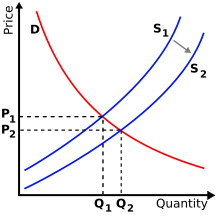
Supply Shift
A supply shock could be caused by changing regulations or a sudden change in the price of an input, among other reasons.
During the short-run, there is one fixed factor of production, usually capital. However, the fixed factor does not stop the curve’s ability to shift outward. When the curve shifts to the right, it causes an increase in the output and a decrease in the GDP at a given price. Examples of events that cause the curve to shift to the right in the short-run include a decrease in the wage rate, an increase in physical capital stock, and technological progress.
In the long-run only capital, labor, and technology affect the aggregate supply curve because at this point everything in the economy is assumed to be used optimally. The long run curve is often seen as static because it shift the slowest. The long-run aggregate supply curve is vertical which shows economist’s belief that changes in aggregate demand only have a temporary change on the economy’s total output. Examples of events that shift the long-run curve to the right include an increase in population, an increase in physical capital stock, and technological progress.
Reasons for Shifts
The short-run aggregate supply curve is affected by production costs including taxes, subsidies, price of labor (wages), and the price of raw materials. All of these factors will cause the short-run curve to shift. When there are changes in the quality and quantity of labor and capital the changes affect both the short-run and long-run supply curves. The long-run aggregate supply curve is affected by events that change the potential output of the economy.
Changes in short-run aggregate supply cause the price level of the good or service to drop while the real GDP increases. In the long-run the prices stabilize and the price level of the good or service increase in response to the changes.
Chapter 23: Inflation and Unemployment
23.1: The Relationship Between Inflation and Unemployment
23.1.1: The Phillips Curve
The Phillips curve shows the inverse relationship between inflation and unemployment: as unemployment decreases, inflation increases.
Learning Objective
Review the historical evidence regarding the theory of the Phillips curve
Key Points
- The relationship between inflation rates and unemployment rates is inverse. Graphically, this means the short-run Phillips curve is L-shaped.
- A.W. Phillips published his observations about the inverse correlation between wage changes and unemployment in Great Britain in 1958. This relationship was found to hold true for other industrial countries, as well.
- From 1861 until the late 1960’s, the Phillips curve predicted rates of inflation and rates of unemployment. However, from the 1970’s and 1980’s onward, rates of inflation and unemployment differed from the Phillips curve’s prediction. The relationship between the two variables became unstable.
Key Terms
- stagflation
-
Inflation accompanied by stagnant growth, unemployment, or recession.
- Phillips curve
-
A graph that shows the inverse relationship between the rate of unemployment and the rate of inflation in an economy.
The Phillips curve relates the rate of inflation with the rate of unemployment. The Phillips curve argues that unemployment and inflation are inversely related: as levels of unemployment decrease, inflation increases. The relationship, however, is not linear. Graphically, the short-run Phillips curve traces an L-shape when the unemployment rate is on the x-axis and the inflation rate is on the y-axis .
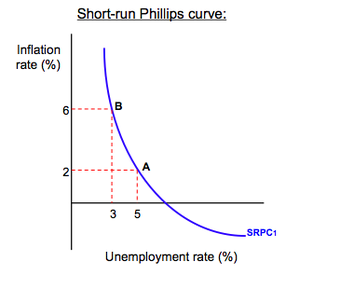
Theoretical Phillips Curve
The Phillips curve shows the inverse trade-off between inflation and unemployment. As one increases, the other must decrease. In this image, an economy can either experience 3% unemployment at the cost of 6% of inflation, or increase unemployment to 5% to bring down the inflation levels to 2%.
History
The early idea for the Phillips curve was proposed in 1958 by economist A.W. Phillips. In his original paper, Phillips tracked wage changes and unemployment changes in Great Britain from 1861 to 1957, and found that there was a stable, inverse relationship between wages and unemployment. This correlation between wage changes and unemployment seemed to hold for Great Britain and for other industrial countries. In 1960, economists Paul Samuelson and Robert Solow expanded this work to reflect the relationship between inflation and unemployment. Because wages are the largest components of prices, inflation (rather than wage changes) could be inversely linked to unemployment.
The theory of the Phillips curve seemed stable and predictable. Data from the 1960’s modeled the trade-off between unemployment and inflation fairly well. The Phillips curve offered potential economic policy outcomes: fiscal and monetary policy could be used to achieve full employment at the cost of higher price levels, or to lower inflation at the cost of lowered employment. However, when governments attempted to use the Phillips curve to control unemployment and inflation, the relationship fell apart. Data from the 1970’s and onward did not follow the trend of the classic Phillips curve. For many years, both the rate of inflation and the rate of unemployment were higher than the Phillips curve would have predicted, a phenomenon known as “stagflation. ” Ultimately, the Phillips curve was proved to be unstable, and therefore, not usable for policy purposes .
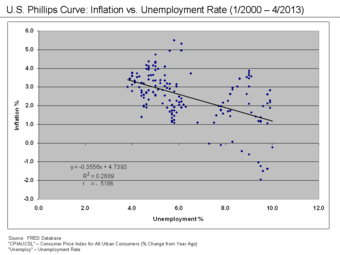
US Phillips Curve (2000 – 2013)
The data points in this graph span every month from January 2000 until April 2013. They do not form the classic L-shape the short-run Phillips curve would predict. Although it was shown to be stable from the 1860’s until the 1960’s, the Phillips curve relationship became unstable – and unusable for policy-making – in the 1970’s.
23.1.2: The Relationship Between the Phillips Curve and AD-AD
Changes in aggregate demand cause movements along the Phillips curve, all other variables held constant.
Learning Objective
Relate aggregate demand to the Phillips curve
Key Points
- Aggregate demand and the Phillips curve share similar components. The rate of unemployment and rate of inflation found in the Phillips curve correspond to the real GDP and price level of aggregate demand.
- Changes in aggregate demand translate as movements along the Phillips curve.
- If there is an increase in aggregate demand, such as what is experienced during demand-pull inflation, there will be an upward movement along the Phillips curve. As aggregate demand increases, real GDP and price level increase, which lowers the unemployment rate and increases inflation.
Key Terms
- Phillips curve
-
A graph that shows the inverse relationship between the rate of unemployment and the rate of inflation in an economy.
- aggregate demand
-
The the total demand for final goods and services in the economy at a given time and price level.
The Phillips Curve Related to Aggregate Demand
The Phillips curve shows the inverse trade-off between rates of inflation and rates of unemployment. If unemployment is high, inflation will be low; if unemployment is low, inflation will be high.
The Phillips curve and aggregate demand share similar components. The Phillips curve is the relationship between inflation, which affects the price level aspect of aggregate demand, and unemployment, which is dependent on the real output portion of aggregate demand. Consequently, it is not far-fetched to say that the Phillips curve and aggregate demand are actually closely related.
To see the connection more clearly, consider the example illustrated by . Let’s assume that aggregate supply, AS, is stationary, and that aggregate demand starts with the curve, AD1. There is an initial equilibrium price level and real GDP output at point A. Now, imagine there are increases in aggregate demand, causing the curve to shift right to curves AD2 through AD4. As aggregate demand increases, unemployment decreases as more workers are hired, real GDP output increases, and the price level increases; this situation describes a demand-pull inflation scenario.
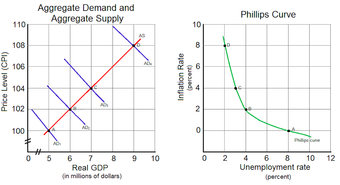
Phillips Curve and Aggregate Demand
As aggregate demand increases from AD1 to AD4, the price level and real GDP increases. This translates to corresponding movements along the Phillips curve as inflation increases and unemployment decreases.
As more workers are hired, unemployment decreases. Moreover, the price level increases, leading to increases in inflation. These two factors are captured as equivalent movements along the Phillips curve from points A to D. At the initial equilibrium point A in the aggregate demand and supply graph, there is a corresponding inflation rate and unemployment rate represented by point A in the Phillips curve graph. For every new equilibrium point (points B, C, and D) in the aggregate graph, there is a corresponding point in the Phillips curve. This illustrates an important point: changes in aggregate demand cause movements along the Phillips curve.
23.1.3: The Long-Run Phillips Curve
The long-run Phillips curve is a vertical line at the natural rate of unemployment, so inflation and unemployment are unrelated in the long run.
Learning Objective
Examine the NAIRU and its relationship to the long term Phillips curve
Key Points
- The natural rate of unemployment is the hypothetical level of unemployment the economy would experience if aggregate production were in the long-run state.
- The natural rate hypothesis, or the non-accelerating inflation rate of unemployment (NAIRU) theory, predicts that inflation is stable only when unemployment is equal to the natural rate of unemployment. If unemployment is below (above) its natural rate, inflation will accelerate (decelerate).
- Expansionary efforts to decrease unemployment below the natural rate of unemployment will result in inflation. This changes the inflation expectations of workers, who will adjust their nominal wages to meet these expectations in the future. This leads to shifts in the short-run Phillips curve.
- The natural rate hypothesis was used to give reasons for stagflation, a phenomenon that the classic Phillips curve could not explain.
Key Terms
- non-accelerating inflation rate of unemployment
-
(NAIRU); theory that describes how the short-run Phillips curve shifts in the long run as expectations change.
- Natural Rate of Unemployment
-
The hypothetical unemployment rate consistent with aggregate production being at the long-run level.
The Phillips curve shows the trade-off between inflation and unemployment, but how accurate is this relationship in the long run? According to economists, there can be no trade-off between inflation and unemployment in the long run. Decreases in unemployment can lead to increases in inflation, but only in the short run. In the long run, inflation and unemployment are unrelated. Graphically, this means the Phillips curve is vertical at the natural rate of unemployment, or the hypothetical unemployment rate if aggregate production is in the long-run level. Attempts to change unemployment rates only serve to move the economy up and down this vertical line.
Natural Rate Hypothesis
The natural rate of unemployment theory, also known as the non-accelerating inflation rate of unemployment (NAIRU) theory, was developed by economists Milton Friedman and Edmund Phelps. According to NAIRU theory, expansionary economic policies will create only temporary decreases in unemployment as the economy will adjust to the natural rate. Moreover, when unemployment is below the natural rate, inflation will accelerate. When unemployment is above the natural rate, inflation will decelerate. When the unemployment rate is equal to the natural rate, inflation is stable, or non-accelerating.
An Example
To get a better sense of the long-run Phillips curve, consider the example shown in . Assume the economy starts at point A and has an initial rate of unemployment and inflation rate. If the government decides to pursue expansionary economic policies, inflation will increase as aggregate demand shifts to the right. This is shown as a movement along the short-run Phillips curve, to point B, which is an unstable equilibrium. As aggregate demand increases, more workers will be hired by firms in order to produce more output to meet rising demand, and unemployment will decrease. However, due to the higher inflation, workers’ expectations of future inflation changes, which shifts the short-run Phillips curve to the right, from unstable equilibrium point B to the stable equilibrium point C. At point C, the rate of unemployment has increased back to its natural rate, but inflation remains higher than its initial level.

NAIRU and Phillips Curve
Although the economy starts with an initially low level of inflation at point A, attempts to decrease the unemployment rate are futile and only increase inflation to point C. The unemployment rate cannot fall below the natural rate of unemployment, or NAIRU, without increasing inflation in the long run.
The reason the short-run Phillips curve shifts is due to the changes in inflation expectations. Workers, who are assumed to be completely rational and informed, will recognize their nominal wages have not kept pace with inflation increases (the movement from A to B), so their real wages have been decreased. As such, in the future, they will renegotiate their nominal wages to reflect the higher expected inflation rate, in order to keep their real wages the same. As nominal wages increase, production costs for the supplier increase, which diminishes profits. As profits decline, suppliers will decrease output and employ fewer workers (the movement from B to C). Consequently, an attempt to decrease unemployment at the cost of higher inflation in the short run led to higher inflation and no change in unemployment in the long run.
The NAIRU theory was used to explain the stagflation phenomenon of the 1970’s, when the classic Phillips curve could not. According to the theory, the simultaneously high rates of unemployment and inflation could be explained because workers changed their inflation expectations, shifting the short-run Phillips curve, and increasing the prevailing rate of inflation in the economy. At the same time, unemployment rates were not affected, leading to high inflation and high unemployment.
23.1.4: The Short-Run Phillips Curve
The short-run Phillips curve depicts the inverse trade-off between inflation and unemployment.
Learning Objective
Interpret the short-run Phillips curve
Key Points
- The long-run Phillips curve is a vertical line at the natural rate of unemployment, but the short-run Phillips curve is roughly L-shaped.
- The inverse relationship shown by the short-run Phillips curve only exists in the short-run; there is no trade-off between inflation and unemployment in the long run.
- Economic events of the 1970’s disproved the idea of a permanently stable trade-off between unemployment and inflation.
Key Term
- Phillips curve
-
A graph that shows the inverse relationship between the rate of unemployment and the rate of inflation in an economy.
The Phillips curve depicts the relationship between inflation and unemployment rates. The long-run Phillips curve is a vertical line that illustrates that there is no permanent trade-off between inflation and unemployment in the long run. However, the short-run Phillips curve is roughly L-shaped to reflect the initial inverse relationship between the two variables . As unemployment rates increase, inflation decreases; as unemployment rates decrease, inflation increases.
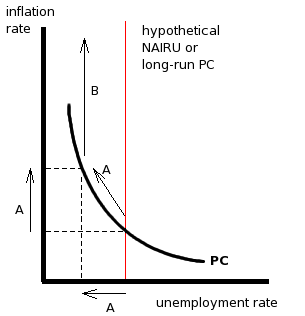
Short-Run Phillips Curve
The short-run Phillips curve shows that in the short-term there is a tradeoff between inflation and unemployment. Contrast it with the long-run Phillips curve (in red), which shows that over the long term, unemployment rate stays more or less steady regardless of inflation rate.
Consider the example shown in . When the unemployment rate is 2%, the corresponding inflation rate is 10%. As unemployment decreases to 1%, the inflation rate increases to 15%. On the other hand, when unemployment increases to 6%, the inflation rate drops to 2%.
Historical application
During the 1960’s, the Phillips curve rose to prominence because it seemed to accurately depict real-world macroeconomics. However, the stagflation of the 1970’s shattered any illusions that the Phillips curve was a stable and predictable policy tool. Nowadays, modern economists reject the idea of a stable Phillips curve, but they agree that there is a trade-off between inflation and unemployment in the short-run. Given a stationary aggregate supply curve, increases in aggregate demand create increases in real output. As output increases, unemployment decreases. With more people employed in the workforce, spending within the economy increases, and demand-pull inflation occurs, raising price levels.
Therefore, the short-run Phillips curve illustrates a real, inverse correlation between inflation and unemployment, but this relationship can only exist in the short run. The idea of a stable trade-off between inflation and unemployment in the long run has been disproved by economic history.
23.1.5: Relationship Between Expectations and Inflation
There are two theories of expectations (adaptive or rational) that predict how people will react to inflation.
Learning Objective
Distinguish adaptive expectations from rational expectations
Key Points
- Nominal quantities are simply stated values. Real quantities are nominal ones that have been adjusted for inflation.
- Adaptive expectations theory says that people use past information as the best predictor of future events. If inflation was higher than normal in the past, people will expect it to be higher than anticipated in the future.
- Rational expectations theory says that people use all available information, past and current, to predict future events. If inflation was higher than normal in the past, people will take that into consideration, along with current economic indicators, to anticipate its future performance.
- According to adaptive expectations, attempts to reduce unemployment will result in temporary adjustments along the short-run Phillips curve, but will revert to the natural rate of unemployment. According to rational expectations, attempts to reduce unemployment will only result in higher inflation.
Key Terms
- adaptive expectations theory
-
A hypothesized process by which people form their expectations about what will happen in the future based on what has happened in the past.
- rational expectations theory
-
A hypothesized process by which people form their expectations about what will happen in the future based on all relevant information.
The short-run Phillips curve is said to shift because of workers’ future inflation expectations. Yet, how are those expectations formed? There are two theories that explain how individuals predict future events.
Real versus Nominal Quantities
To fully appreciate theories of expectations, it is helpful to review the difference between real and nominal concepts. Anything that is nominal is a stated aspect. In contrast, anything that is real has been adjusted for inflation. To make the distinction clearer, consider this example. Suppose you are opening a savings account at a bank that promises a 5% interest rate. This is the nominal, or stated, interest rate. However, suppose inflation is at 3%. The real interest rate would only be 2% (the nominal 5% minus 3% to adjust for inflation).
The difference between real and nominal extends beyond interest rates. In an earlier atom, the difference between real GDP and nominal GDP was discussed. The distinction also applies to wages, income, and exchange rates, among other values.
Adaptive Expectations
The theory of adaptive expectations states that individuals will form future expectations based on past events. For example, if inflation was lower than expected in the past, individuals will change their expectations and anticipate future inflation to be lower than expected.
To connect this to the Phillips curve, consider . Assume the economy starts at point A at the natural rate of unemployment with an initial inflation rate of 2%, which has been constant for the past few years. Accordingly, because of the adaptive expectations theory, workers will expect the 2% inflation rate to continue, so they will incorporate this expected increase into future labor bargaining agreements. This way, their nominal wages will keep up with inflation, and their real wages will stay the same.
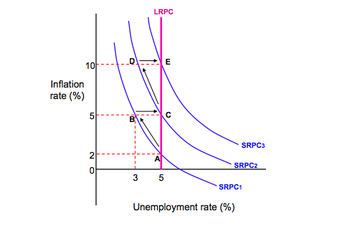
Expectations and the Phillips Curve
According to adaptive expectations theory, policies designed to lower unemployment will move the economy from point A through point B, a transition period when unemployment is temporarily lowered at the cost of higher inflation. However, eventually, the economy will move back to the natural rate of unemployment at point C, which produces a net effect of only increasing the inflation rate.According to rational expectations theory, policies designed to lower unemployment will move the economy directly from point A to point C. The transition at point B does not exist as workers are able to anticipate increased inflation and adjust their wage demands accordingly.
Now assume that the government wants to lower the unemployment rate. To do so, it engages in expansionary economic activities and increases aggregate demand. As aggregate demand increases, inflation increases. Because of the higher inflation, the real wages workers receive have decreased. For example, assume each worker receives $100, plus the 2% inflation adjustment. Each worker will make $102 in nominal wages, but $100 in real wages. Now, if the inflation level has risen to 6%. Workers will make $102 in nominal wages, but this is only $96.23 in real wages.
Although the workers’ real purchasing power declines, employers are now able to hire labor for a cheaper real cost. Consequently, employers hire more workers to produce more output, lowering the unemployment rate and increasing real GDP. On , the economy moves from point A to point B.
However, workers eventually realize that inflation has grown faster than expected, their nominal wages have not kept pace, and their real wages have been diminished. They demand a 4% increase in wages to increase their real purchasing power to previous levels, which raises labor costs for employers. As labor costs increase, profits decrease, and some workers are let go, increasing the unemployment rate. Graphically, the economy moves from point B to point C.
This example highlights how the theory of adaptive expectations predicts that there are no long-run trade-offs between unemployment and inflation. In the short run, it is possible to lower unemployment at the cost of higher inflation, but, eventually, worker expectations will catch up, and the economy will correct itself to the natural rate of unemployment with higher inflation.
Rational Expectations
The theory of rational expectations states that individuals will form future expectations based on all available information, with the result that future predictions will be very close to the market equilibrium. For example, assume that inflation was lower than expected in the past. Individuals will take this past information and current information, such as the current inflation rate and current economic policies, to predict future inflation rates.
As an example of how this applies to the Phillips curve, consider again. Assume the economy starts at point A, with an initial inflation rate of 2% and the natural rate of unemployment. However, under rational expectations theory, workers are intelligent and fully aware of past and present economic variables and change their expectations accordingly. They will be able to anticipate increases in aggregate demand and the accompanying increases in inflation. As such, they will raise their nominal wage demands to match the forecasted inflation, and they will not have an adjustment period when their real wages are lower than their nominal wages. Graphically, they will move seamlessly from point A to point C, without transitioning to point B.
In essence, rational expectations theory predicts that attempts to change the unemployment rate will be automatically undermined by rational workers. They can act rationally to protect their interests, which cancels out the intended economic policy effects. Efforts to lower unemployment only raise inflation.
23.1.6: Shifting the Phillips Curve with a Supply Shock
Aggregate supply shocks, such as increases in the costs of resources, can cause the Phillips curve to shift.
Learning Objective
Give examples of aggregate supply shock that shift the Phillips curve
Key Points
- In the 1970’s soaring oil prices increased resource costs for suppliers, which decreased aggregate supply. The resulting cost-push inflation situation led to high unemployment and high inflation (stagflation), which shifted the Phillips curve upwards and to the right.
- Stagflation is a situation where economic growth is slow (reducing employment levels) but inflation is high.
- The Phillips curve was thought to represent a fixed and stable trade-off between unemployment and inflation, but the supply shocks of the 1970’s caused the Phillips curve to shift. This ruined its reputation as a predictable relationship.
Key Terms
- stagflation
-
Inflation accompanied by stagnant growth, unemployment, or recession.
- supply shock
-
An event that suddenly changes the price of a commodity or service. It may be caused by a sudden increase or decrease in the supply of a particular good.
The Phillips curve shows the relationship between inflation and unemployment. In the short-run, inflation and unemployment are inversely related; as one quantity increases, the other decreases. In the long-run, there is no trade-off. In the 1960’s, economists believed that the short-run Phillips curve was stable. By the 1970’s, economic events dashed the idea of a predictable Phillips curve. What could have happened in the 1970’s to ruin an entire theory? Stagflation caused by a aggregate supply shock.
Stagflation and Aggregate Supply Shocks
Stagflation is a combination of the words “stagnant” and “inflation,” which are the characteristics of an economy experiencing stagflation: stagnating economic growth and high unemployment with simultaneously high inflation. The stagflation of the 1970’s was caused by a series of aggregate supply shocks. In this case, huge increases in oil prices by the Organization of Petroleum Exporting Countries (OPEC) created a severe negative supply shock. The increased oil prices represented greatly increased resource prices for other goods, which decreased aggregate supply and shifted the curve to the left . As aggregate supply decreased, real GDP output decreased, which increased unemployment, and price level increased; in other words, the shift in aggregate supply created cost-push inflation.
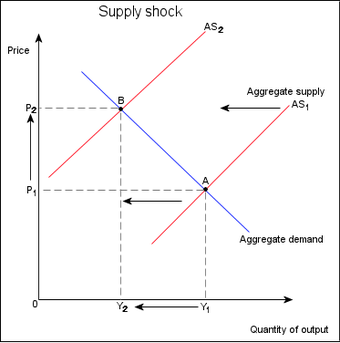
Aggregate Supply Shock
In this example of a negative supply shock, aggregate supply decreases and shifts to the left. The resulting decrease in output and increase in inflation can cause the situation known as stagflation.
Shifting the Phillips Curve
The aggregate supply shocks caused by the rising price of oil created simultaneously high unemployment and high inflation. At the time, the dominant school of economic thought believed inflation and unemployment to be mutually exclusive; it was not possible to have high levels of both within an economy. Consequently, the Phillips curve could not model this situation. For high levels of unemployment, there were now corresponding levels of inflation that were higher than the Phillips curve predicted; the Phillips curve had shifted upwards and to the right. Thus, the Phillips curve no longer represented a predictable trade-off between unemployment and inflation.
23.1.7: Disinflation
Disinflation is a decline in the rate of inflation, and can be caused by declines in the money supply or recessions in the business cycle.
Learning Objective
Identify situations with disinflation
Key Points
- Disinflation is not the same as deflation, when inflation drops below zero.
- During periods of disinflation, the general price level is still increasing, but it is occurring slower than before.
- The short-run and long-run Phillips curve may be used to illustrate disinflation.
Key Terms
- disinflation
-
A decrease in the inflation rate.
- inflation
-
An increase in the general level of prices or in the cost of living.
- deflation
-
A decrease in the general price level, that is, in the nominal cost of goods and services.
Inflation is the persistent rise in the general price level of goods and services. Disinflation is a decline in the rate of inflation; it is a slowdown in the rise in price level. As an example, assume inflation in an economy grows from 2% to 6% in Year 1, for a growth rate of four percentage points. In Year 2, inflation grows from 6% to 8%, which is a growth rate of only two percentage points. The economy is experiencing disinflation because inflation did not increase as quickly in Year 2 as it did in Year 1, but the general price level is still rising. Disinflation is not to be confused with deflation, which is a decrease in the general price level.
Causes
Disinflation can be caused by decreases in the supply of money available in an economy. It can also be caused by contractions in the business cycle, otherwise known as recessions. The Phillips curve can illustrate this last point more closely. Consider an economy initially at point A on the long-run Phillips curve in . Suppose that during a recession, the rate that aggregate demand increases relative to increases in aggregate supply declines. This reduces price levels, which diminishes supplier profits. As profits decline, employers lay off employees, and unemployment rises, which moves the economy from point A to point B on the graph. Eventually, though, firms and workers adjust their inflation expectations, and firms experience profits once again. As profits increase, employment also increases, returning the unemployment rate to the natural rate as the economy moves from point B to point C. The expected rate of inflation has also decreased due to different inflation expectations, resulting in a shift of the short-run Phillips curve.
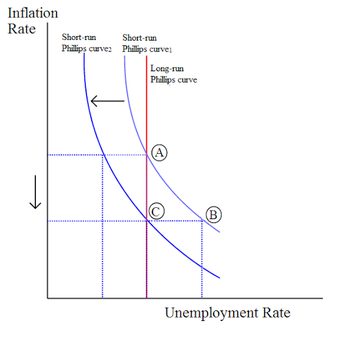
Disinflation
Disinflation can be illustrated as movements along the short-run and long-run Phillips curves.
Inflation vs. Deflation vs. Disinflation
To illustrate the differences between inflation, deflation, and disinflation, consider the following example. Assume the following annual price levels as compared to the prices in year 1:
- Year 1: 100% of Year 1 prices
- Year 2: 104% of Year 1 prices
- Year 3: 106% of Year 1 prices
- Year 4: 107% of Year 1 prices
- Year 5: 105% of Year 1 prices
As the economy moves through Year 1 to Year 4, there is a continued growth in the price level. This is an example of inflation; the price level is continually rising. However, between Year 2 and Year 4, the rise in price levels slows down. Between Year 2 and Year 3, the price level only increases by two percentage points, which is lower than the four percentage point increase between Years 1 and 2. The trend continues between Years 3 and 4, where there is only a one percentage point increase. This is an example of disinflation; the overall price level is rising, but it is doing so at a slower rate.
Between Years 4 and 5, the price level does not increase, but decreases by two percentage points. This is an example of deflation; the price rise of previous years has reversed itself.
Chapter 22: Unemployment
22.1: Introduction to Unemployment
22.1.1: Defining Unemployment
Unemployment, also referred to as joblessness, occurs when people are without work and actively seeking employment.
Learning Objective
Classify the different measures and types of unemployment
Key Points
- Types of unemployment determine what the causes, consequences, and solutions. The types of unemployment include: classical, cyclical, structural, frictional, hidden, and long-term.
- Unemployment is calculated as a percentage by dividing the number of unemployed individuals by the number of all the individuals currently employed in the work force.
- When unemployment rates are high and steady, there are negative impacts on the long-run economic growth.
- Demand side and supply side solutions are used to reduce unemployment rates.
Key Term
- unemployment
-
The state of being jobless and looking for work.
Unemployment, also referred to as joblessness, occurs when people are without work and are actively seeking employment. During periods of recession, an economy usually experiences high unemployment rates. There are many proposed causes, consequences, and solutions for unemployment.
Types of Unemployment
- Classical: occurs when real wages for jobs are set above the market-clearing level. It causes the number of job seekers to be higher than the number of vacancies.
- Cyclical: occurs when there is not enough aggregate demand in the economy to provide jobs for everyone who wants to work. Demand for goods and services decreases, less production is needed, and fewer workers are needed.
- Structural: occurs when the labor market is not able to provide jobs for everyone who wants to work. There is a mismatch between the skills of the unemployed workers and the skills needed for available jobs. It differs from frictional unemployment because it lasts longer.
- Frictional: the time period in between jobs when a worker is searching for work or transitioning from one job to another.
- Hidden: the unemployment of potential workers that is not taken into account in official unemployment statistics because of how the data is collected. For example, workers are only considered unemployed if they are looking for work so those without jobs who have stopped looking are no longer considered unemployed.
- Long-term: usually defined as unemployment lasting longer than one year.
Measuring Unemployment
Unemployment is calculated as a percentage by dividing the number of unemployed individuals by the number of all individuals currently employed in the workforce. The final measurement is called the rate of unemployment .
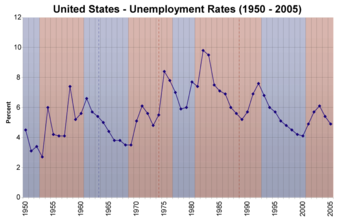
Unemployment Rate
Unemployment is calculated as a percentage by dividing the number of unemployed individuals by the number of individual employed in the labor force.
Effects of Unemployment
When unemployment rates are high and steady, there are negative impacts on the long-run economic growth. Unemployment wastes resources, generates redistributive pressures and distortions, increases poverty, limits labor mobility, and promotes social unrest and conflict. The effects of unemployment can be broken down into three types:
- Individual: people who are unemployed cannot earn money to meet their financial obligations. Unemployment can lead to homelessness, illness, and mental stress. It can also cause underemployment where workers take on jobs that are below their skill level.
- Social: an economy that has high unemployment is not using all of its resources efficiently, specifically labor. When individuals accept employment below their skill level the economies efficiency is reduced further. Workers lose skills which causes a loss of human capital.
- Socio-political: high unemployment rates can cause civil unrest in a country.
Reducing Unemployment
There are numerous solutions that can help reduce the amount of unemployment:
- Demand side solutions: many countries aid unemployed workers through social welfare programs. Individuals receive unemployment benefits including insurance, compensation, welfare, and subsidies to aid in retraining. An example of a demand side solution is government funded employment of the able-bodied poor.
- Supply side solutions: the labor market is not 100% efficient. Supply side solutions remove the minimum wage and reduce the power of unions. The policies are designed to make the market more flexible in an attempt to increase long-run economic growth. Examples of supply side solutions include cutting taxes on businesses, reducing regulation, and increasing education.
22.1.2: Defining Full Employment
Full employment is defined as an acceptable level of unemployment somewhere above 0%; there is no cyclical or deficient-demand unemployment.
Learning Objective
Define full employment
Key Points
- Full employment represents a range of possible unemployment rates based on the country, time period, and political biases.
- Full employment is often seen as an “ideal” unemployment rate. Ideal unemployment excludes types of unemployment where labor-market inefficiency is reflected.
- The full employment unemployment rate is also referred to as “natural” unemployment.
- The Non-Accelerating Inflation Rate of Unemployment (NAIRU) corresponds to the unemployment rate when real GDP equals potential output.
Key Term
- full employment
-
A state when an economy has no cyclical or deficient-demand unemployment.
Full Employment
In macroeconomics, full employment is the level of employment rates where there is no cyclical or deficient-demand unemployment. Mainstream economists define full employment as an acceptable level of unemployment somewhere above 0%. Full employment represents a range of possible unemployment rates based on the country, time period, and political biases .
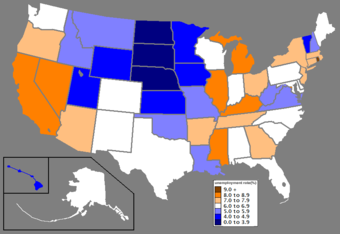
U.S. Unemployment
The graph shows the unemployment rates in the United States. Full employment is defined as “ideal” unemployment. It is important because it keeps inflation under control.
Ideal Unemployment
Full employment is often seen as an “ideal” unemployment rate. Ideal unemployment excludes types of unemployment where labor-market inefficiency is reflected. Only some frictional and voluntary unemployment exists, where workers are temporarily searching for new jobs. This classifies the unemployed individuals as being without a job voluntarily. Ideal unemployment promotes the efficiency of the economy.
Lord William Beveridge defined “full employment” as the situation where the number of unemployed workers equaled the number of job vacancies available. He preferred that the economy be kept above the full employment level to allow for maximum economic production.
Non-Accelerating Inflation Rate of Unemployment (NAIRU)
The full employment unemployment rate is also referred to as “natural” unemployment. In an effort to avoid this normative connotation, James Tobin introduced the term “Non-Accelerating Inflation Rate of Unemployment” also known as the NAIRU. It corresponds to the level of unemployment when real GDP equals potential output. The NAIRU has been called the “inflation threshold. ” The NAIRU states the inflation does not rise or fall when unemployment equals the natural rate.
As an example, the United States is committed to full employment. The “Full Employment Act” was passed in 1946 and revised in 1978. It states that full employment in the United States is no more than 3% unemployment for persons 20 and older, and 4% for persons aged 16 and over.
22.1.3: Types of Unemployment: Frictional, Structural, Cyclical
In economics, unemployment is occurs when people are without work while actively searching for employment.
Learning Objective
Discuss structural unemployment, frictional unemployment, and the natural unemployment rate
Key Points
- Structural unemployment focuses on the structural problems within an economy and inefficiencies in labor markets.
- Frictional unemployment is the time period between jobs when a worker is searching for or transitioning from one job to another.
- Cyclical unemployment is a type of unemployment that occurs when there is not enough aggregate demand in the economy to provide jobs for everyone who wants to work.
- Classical unemployment occurs when real wages for a jobs are set above the marketing clearing level.
- The natural unemployment rate represents the hypothetical unemployment rate that is consistent with aggregate production being at a long-run level.
Key Terms
- structural unemployment
-
A mismatch between the requirements of the employers and the properties of the unemployed.
- frictional unemployment
-
When people being temporarily between jobs, searching for new ones.
Unemployment
In economics, unemployment occurs when people are without work while actively searching for employment . The unemployment rate is a percentage, and calculated by dividing the number of unemployed individuals by the number of all currently employed individuals in the labor force. The causes, consequences, and solutions vary based on the specific type of unemployment that is present within a country.
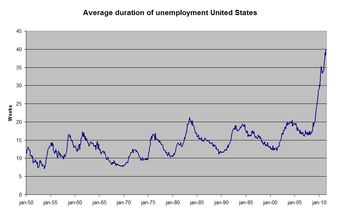
U.S. Unemployment
This graph shows the average duration of unemployment in the United States from 1950-2010. Unemployment occurs when there are more individuals seeking jobs than there are vacancies.
Structural Unemployment
Structural unemployment is one of the main types of unemployment within an economic system. It focuses on the structural problems within an economy and inefficiencies in labor markets. Structural unemployment occurs when a labor market is not able to provide jobs for everyone who is seeking employment. There is a mismatch between the skills of the unemployed workers and the skills needed for the jobs that are available. It is often impacted by persistent cyclical unemployment. For example, when an economy experiences long-term unemployment individuals become frustrated and their skills become obsolete. As a result, when the economy recovers they may not fit the requirements of new jobs due to their inactivity .

Retraining
When there is structural unemployment, workers may seek to learn different skills so that they can apply to new types of jobs.
Frictional Unemployment
Frictional unemployment is another type of unemployment within an economy. It is the time period between jobs when a worker is searching for or transitioning from one job to another. Frictional unemployment is always present to some degree in an economy. It occurs when there is a mismatch between the workers and jobs. The mismatch can be related to skills, payment, work time, location, seasonal industries, attitude, taste, and other factors. Frictional unemployment is influenced by voluntary decisions to work based on each individual’s valuation of their own work and how that compares to current wage rates as well as the time and effort required to find a job.
Cyclical Unemployment
Cyclical unemployment is a type of unemployment that occurs when there is not enough aggregate demand in the economy to provide jobs for everyone who wants to work. In an economy, demand for most goods falls, less production is needed, and less workers are needed. With cyclical unemployment the number of unemployed workers is greater that the number of job vacancies.
The Natural Unemployment Rate
The natural unemployment rate, sometimes called the structural unemployment rate, was developed by Friedman and Phelps in the 1960s. It represents the hypothetical unemployment rate that is consistent with aggregate production being at a long-run level. The natural rate of unemployment is a combination of structural and frictional unemployment. It is present in an efficient and expanding economy when labor and resource markets are at equilibrium. The natural unemployment rate occurs within an economy when disturbances are not present.
22.2: Measuring Unemployment
22.2.1: Measuring the Unemployment Rate
The labor force is the actual number of people available for work; economists use the labor force participation rate to determine the unemployment rate.
Learning Objective
Classify the six measures of unemployment calculated by the Bureau of Labor Statistics (BLS)
Key Points
- Unemployment occurs when people are without work and are actively seeking employment.
- There are three types of unemployment: cyclical, structural, and frictional.
- The CPS and CES are two surveys that the U.S. Bureau of Labor Statistics uses to determine the unemployment rate for households, businesses, and government agencies.
- The U.S. Bureau of Labor Statistics uses six measurements when calculating the unemployment rate. The measures range from U1 – U6 and were reported from 1950 through 2010. They calculate different aspects of unemployment.
Key Term
- unemployment
-
The state of being jobless and looking for work.
Unemployment Rate
Unemployment occurs when people are without work and are actively seeking employment. In an economy, the labor force is the actual number of people available for work. Economists use the labor force participation rate to determine the unemployment rate.
Unemployment can be broken down into three types of unemployment:
- Cyclical unemployment: occurs when there is not enough aggregate demand in the economy to provide jobs for everyone who wants to work.
- Structural unemployment: occurs when the labor market is unable to provide jobs for everyone who wants to work. There is a mismatch between the skills of the unemployed workers and the skills necessary for the jobs available.
- Frictional unemployment: the time period between jobs when a worker is looking for a job or transitioning from one job to another.
Measuring Unemployment
The U.S. Bureau of Labor Statistics measures employment and unemployment for individuals over the age of 16. The unemployment rate is measured using two different labor force surveys.
- The Current Population Survey (CPS): also known as the “household survey” the CPS is conducted based on a sample of 60,000 households. The survey measures the unemployment rate based on the ILO definition.
- The Current Employment Statistics Survey (CES): also known as the “payroll survey” the CES is conducted based on a sample of 160,000 businesses and government agencies that represent 400,000 individual employees.
The unemployment rate is also calculated using weekly claims reports for unemployed insurance. The government provides this data. The unemployment rate is updated on a monthly basis.
Six Measures of Unemployment
The U.S. Bureau of Labor Statistics uses six measurements when calculating the unemployment rate. The measures range from U1 – U6 and were reported from 1950 through 2010 . They calculate different aspects of unemployment. The measures are:

Unemployment Rate
The U.S. Bureau of Labor Statistics used the six employment measures to calculate the unemployment rate in the United States from 1950 to 2010.
- U1: the percentage of labor force unemployed for 15 weeks or longer.
- U2: the percentage of labor force who lost jobs or completed temporary work.
- U3: the official unemployment rate that occurs when people are without jobs and they have actively looked for work within the past four weeks.
- U4: the individuals described in U3 plus “discouraged workers,” those who have stopped looking for work because current economic conditions make them think that no work is available for them.
- U5: the individuals described in U4 plus other “marginally attached workers,” “loosely attached workers,” or those who “would like” and are able to work, but have not looked for work recently.
- U6: the individuals described in U5 plus part-time workers who want to work full-time, but cannot due to economic reasons, primarily underemployment.
22.2.2: Shortcomings of the Measurement
Unemployment is not an absolute calculation and it is prone to errors and biases related to data assembly and inconsistencies in reporting.
Learning Objective
Describe the rates in the U.S. of those who are employed, unemployed, and not in the labor force
Key Points
- The rate of unemployment is a percentage that is calculated by dividing the number of unemployed individuals by the number of individuals currently employed in the work force.
- The rate of unemployment is calculated using four methods: the Labor Force Sample Surveys, Official Estimates, Social Insurance Statistics, and Employment Office Statistics.
- The measurement of unemployment does have some shortcomings based on who is and is not measured.
- By not including all under-employed or unemployed individuals in the measurement of the unemployment rate, the calculation does not provide an accurate assessment of how unemployment truly impacts society.
Key Terms
- labor force
-
The collective group of people who are available for employment, i.e. including both the employed and the unemployed.
- unemployment
-
The state of being jobless and looking for work.
Unemployment
Unemployment, also called joblessness, occurs when people are without work and are actively seeking employment. Unemployment is measured in order to determine the unemployment rate. The rate is a percentage that is calculated by dividing the number of unemployed individuals by the number of individuals currently employed in the labor force .

U.S. Unemployment Rate
This image shows the unemployment rates by county throughout the United States in 2008. The unemployment rate is the percentage of unemployment calculated by dividing the number of unemployed individuals by the number of individuals currently employed in the labor force.
Measurements
In order to find the rate of unemployment, four methods are used:
- Labor Force Sample Surveys: provide the most comprehensive results. Calculates unemployment by different categories such as race and gender. This method is the most internationally comparable.
- Official Estimates: combines information from the three other methods. The method is not the preferred method to use when calculating the rate of unemployment.
- Social Insurance Statistics: these statistics are calculated based on the number of individuals receiving unemployment benefits. The method is criticized because unemployment benefits can expire before an individual finds employment which makes the calculations inaccurate.
- Employment Office Statistics: only include a monthly total of unemployed individuals who enter unemployment offices. This method is the least effective for measuring unemployment.
Measurement Shortcomings
The measurement of unemployment is not an absolute calculation and is prone to errors. For example, the unemployment rate does not take into account individuals who are not actively seeking employment, such as individuals attending college or even individuals who are in U.S. prisons. Individuals who are self-employed, those who were forced to take early retirement, those with disability pensions who would like to work, and those who work part-time and seek full-time employment are not factored in to the unemployment rate. Some individuals also choose not to enter the labor force and these statistics are also not considered. By not including all underemployed or unemployed individuals in the measurement of the unemployment rate, the calculation does not provide an accurate assessment of how unemployment truly impacts society. Errors and biases are also present due to data assembly and reporting inconsistencies.
22.2.3: Typical Lengths of Unemployment
Short-term unemployment is any period of joblessness that lasts fewer than 27 weeks. Long-term unemployment lasts 27 or more weeks.
Learning Objective
Distinguish between short-term and long-term unemployment and the impact on people and economy
Key Points
- Unemployment occurs when people are without work and are actively seeking employment.
- Unemployment impacts the economy and society by increasing inequality, impeding long-term economic growth, wasting resources, and reducing economic efficiency.
- Unemployment impacts individuals because they are not able to meet their financial obligations which can lead to poverty, poor labor mobility, and low self-esteem. Unemployment is also know to cause civil unrest and conflict.
- Unemployment impacts individuals because they are not able to meet their financial obligations which can lead to poverty, poor labor mobility, and low self-esteem. Unemployment is also know to cause civil unrest and conflict.
Key Terms
- poverty
-
The quality or state of being poor or indigent; want or scarcity of means of subsistence; indigence; need.
- unemployment
-
The state of being jobless and looking for work.
Unemployment
Unemployment, also referred to as joblessness, occurs when people are without work and actively seeking employment. Generally, unemployment is high during recessions. Individuals struggle to find work when there are more job-seekers than vacant positions.
There are three types of unemployment:
- Cyclical: occurs when there is not enough aggregate demand in the economy to provide jobs for everyone who wants to work. The demand for most goods and services declines, less production is needed, and fewer workers are needed. Wages are sticky and do not fall to meet the equilibrium level which results in mass unemployment.
- Structural: occurs when the labor market is not able to provide jobs for everyone who wants to work. There is a mismatch between the skills of the workers and the skills needed for the jobs that are available.Structural unemployment is similar to frictional unemployment, but it lasts longer.
- Frictional: when a worker is searching for a job or transitioning from one job to another. Frictional unemployment is always present in an economy.
Lengths of Unemployment
Short-term unemployment is considered any unemployment period that lasts less than 27 weeks. The unemployment period is temporary and often includes the time needed to switch from one job to another. Also, if an individual is searching for employment the search period is relatively short.
Long-term unemployment is classified as unemployment that lasts for 27 weeks or longer. Being unemployed for a long period of time can have substantial impacts on individuals. Jobs skills, certifications, and qualifications lessen over time. When the job market finally increases many individuals will no longer match the requirements for the new positions. Long-term unemployment can also result in older workers taking early retirement .
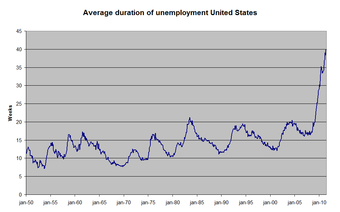
Average Length of Unemployment
This graph shows the average length of unemployment in the United States from 1950-2010. Short-term unemployment is considered less than 27 weeks, while long-term unemployment is joblessness that lasts 27 weeks or longer.
Social and Individual Impacts
Unemployment can have lasting impacts of individual people as well as the economy as a whole.
- Social: Within the economy, long-term unemployment increases the inequality present in the economy and impedes long-run economic growth. Unemployment wastes resources and generates redistributive pressures and distortions within the economy. When unemployment is high, the economy is not using all of the available resources, specifically labor. Unemployment can also reduce the efficiency of the economy because unemployed workers are willing to accept employment that is below their skill level.
- Individual: For individual people, unemployment increases poverty, creates poor labor mobility, and impacts self-esteem. When individuals are unemployed they are unable to meet their financial obligations. It is not uncommon for social unrest and conflict that get worse during times of mass unemployment.
22.3: Understanding Unemployment
22.3.1: Reasons for Unemployment
There are three reasons for unemployment which are categorizes as frictional, structural, and cyclical unemployment.
Learning Objective
Explain why the unemployment rate may fluctuate
Key Points
- The natural rate of unemployment is the unemployment rate when the economy is producing at its full potential output. This natural rate is positve, rather than zero, due to frictional and structural unemployment.
- Frictional unemployment is caused by an inability for workers and employers to find each other immediately.
- Structural unemployment is caused by mismatches between the skills offered by potential employees and those sought by employers.
- Cyclical unemployment occurs whenever the economy is not operating at its full, long-term potential. During low periods in the business cycle, firms demand fewer workers and the result is an unemployment level above the natural rate.
Key Terms
- structural unemployment
-
A mismatch between the requirements of the employers and the properties of the unemployed.
- frictional unemployment
-
When people being temporarily between jobs, searching for new ones.
- cyclical unemployment
-
A type of unemployment explained by the demand for labor going up and down with the business cycle.
There are four types of unemployment. The distinction between them is important to economists because the policy prescriptions for addressing each type vary.
Natural Level of Unemployment
The natural level of unemployment is the unemployment rate when an economy is operating at full capacity. This is the unemployment rate that occurs when production is at its long-run level, removing any temporary fluctuations and frictions. It is mainly determined by an economy’s production possibilities and economic institutions. At this level of unemployment, the quantity of labor supplied equals the quantity of labor demanded, though this does not imply that unemployment is zero. The reason why the natural rate of unemployment is still positive is due to frictional and structural unemployment.
Frictional Unemployment
Frictional unemployment is the time period between jobs when a worker is searching for or transitioning from one job to another. It is sometimes called search unemployment and can be voluntary based on the circumstances of the unemployed individual. Frictional unemployment exists because both jobs and workers are heterogenous, and a mismatch can result between the characteristics of supply and demand. Such a mismatch can be related to skills, payment, work-time, location, seasonal industries, attitude, taste, and a multitude of other factors.
There is always at least some frictional unemployment in an economy, so the level of involuntary unemployment is properly the unemployment rate minus the rate of frictional unemployment.
Though economists accept that some frictional unemployment is okay because both potential workers and employers take some time to find the best employee-position match, too much frictional unemployment is undesirable. Governments will seek ways to reduce unnecessary frictional unemployment through multiple means including providing education, advice, training, and assistance such as daycare centers.
Structural Unemployment
Structural unemployment is a form of unemployment where, at a given wage, the quantity of labor supplied exceeds the quantity of labor demanded, because there is a fundamental mismatch between the number of people who want to work and the number of jobs that are available. The unemployed workers may lack the skills needed for the jobs, or they may not live in the part of the country or world where the jobs are available. It is generally considered to be one of the “permanent” types of unemployment, where improvement if possible, will only occur in the long run.
A common cause of structural unemployment is technological change. With the advent of telephones, for example, some telegraph operators were put out of work. Their inability to find work was due to an oversupply of skilled telegraph operators relative to the demand for workers with that ability.
Cyclical Unemployment
Of course, the economy may not be operating at its natural level of employment, so unemployment may be above or below its natural level. This is often attributed to the business cycle: the expansion and contraction of the economy around the long-term growth trend. During periods in the business cycle when the economy is producing below its long-run, optimum level, firms demand fewer workers and the result is cyclical unemployment. In this case the long-run demand for labor is higher than the temporary demand, so the rate of unemployment is higher than its natural rate .
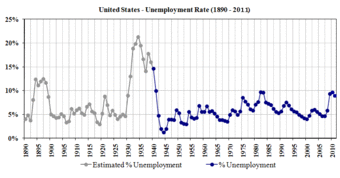
U.S. Unemployment Rate
The short-term fluctuations in the graph are the result of cyclical unemployment that changes when economic activity is above or below its long-term potential. Over time, unemployment has returned to about 5%, which is the approximate natural rate of unemployment.
22.3.2: Impact of Public Policy on Unemployment
Public policy seeks to minimize unemployment by providing information, training, facilities, and other programs to assist the unemployed.
Learning Objective
Review the importance of unemployment benefits in the American social welfare program
Key Points
- Policies to combat unemployment differ depending on the type of unemployment.
- Policies to combat frictional unemployment include providing free and clear information to help match available job-seekers and jobs, providing facilities to increase availability and flexibility, and combating prejudice against certain types of workers, jobs, or locations.
- Unemployment insurance alleviates the short-term hardship faced by the unemployed and allows workers more time to search for a job that fits their skills and preferences.
- Job training and education to equip workers with the skills firms demand are public policy responses to structural unemployment.
Key Terms
- frictional unemployment
-
When people being temporarily between jobs, searching for new ones.
- structural unemployment
-
A mismatch between the requirements of the employers and the properties of the unemployed.
- unemployment insurance
-
Insurance against loss of earnings during the time that an able-bodied worker is involuntarily unemployed.
Most governments strive to achieve low levels of unemployment. However, the types of policies differ depending on what type of unemployment they address.
Frictional Unemployment
Frictional unemployment is the period between jobs in which an employee is searching for or transitioning from one job to another. It exists because the labor market is not perfect and there may be mismatches between job-seekers and jobs before workers are hired for the right position. If the search takes too long and mismatches are too frequent, the economy suffers, since some work will not get done.
Governments can enact policies to try to reduce frictional unemployment. These include offering advice and resources for job-seekers and providing clear and transparent information on available jobs and workers. This can take the form of free career counseling and job boards or job fairs. The government can provide facilities to increase availability and flexibility – for example, providing daycare may allow part-time or non-workers to transition into full-time jobs, and public transportation may widen the number of jobs available to somebody without a car. The government may also fund publicity campaigns or other programs to combat prejudice against certain types of workers, jobs, or locations.
On the other hand, some frictional unemployment is a good thing – if every worker was offered, and accepted, the first job they encountered, the distribution of workers and jobs would be quite inefficient. Many governments offer unemployment insurance to both alleviate the short-term hardship faced by the unemployed and to allow workers more time to search for a job. These benefits generally take the form of payments to the involuntarily unemployed for some specified period of time following the loss of the job. In order to achieve the goal of reducing frictional unemployment, governments typically require beneficiaries to actively search for a job while receiving payments and do not offer unemployment benefits to those who are fired or leave their job by choice.
Structural Unemployment
Structural unemployment is due to more people wanting jobs than there are jobs available. The unemployed workers may lack the skills needed for the jobs, or they may not live in the part of the country or world where the jobs are available.
Public policy can respond to structural unemployment through programs like job training and education to equip workers with the skills firms demand. A worker who was trained in an obsolete field, such as a typesetter who lost his job when printing was digitized, may benefit from free retraining in another field with strong demand for labor .

Job Training Programs
Many organizations seek to minimize structural unemployment by offering job training and education to provide workers with in-demand skills.
22.3.3: Impact of Unions on Unemployment
If the labor market is competitive, unions will typically raise wages but increase unemployment.
Learning Objective
Discuss the impact of unionization on unemployment
Key Points
- Unions function by negotiating with employers to create a collective agreement that applies to all union members and typically lasts for a set time period.
- Unions are able to raise wages because, when they are powerful, they may turn the labor market into a monopoly market.
- Many economists criticize unionization, arguing that it frequently produces higher wages at the expense of fewer jobs. Essentially, unionization benefits the already employed at the expense of the unemployed.
- In labor markets that are not competitive, the equilibrium without unionization may result in wages that are lower than the competitive equilibrium. In this case, unions may be able to raise wages without increasing unemployment.
Key Terms
- marginal product of labor
-
the change in output that results from employing an added unit of labor.
- oligopsony
-
An economic condition in which a small number of buyers exert control over the market price of a commodity.
- bargaining power
-
The ability to influence the setting of prices or wages, usually arising from some sort of monopoly or monopsony position — or a non-equilibrium situation in the market.
A union is a formal organization of workers who have banded together to achieve common goals such as protecting the integrity of its trade, achieving higher pay, increasing the number of employees an employer hires, and better working conditions. They function by negotiating with employers to create a collective agreement that applies to all union members and typically lasts for a set time period. For example, in a unionized industry, rather than each employee negotiating his or her own vacation time with the employer, a union will negotiate with the firm in order to create a contract governing vacation time that applies to every union member. This gives workers as a whole a stronger bargaining position when negotiating working conditions and pay.
Trade unions in their current form became popular during the industrial revolution, when most jobs required little skill or training and therefore almost all of the bargaining power fell with employers rather than employees. While unions have many goals, their primary objective has historically been to achieve higher wages for members of the union – that is, those who are already employed in an industry.
Unions are able to raise wages because, when they are powerful, they may turn the labor market into a monopoly market. Rather than a competitive market with many buyers (employers) and sellers (employees), there are many buyers but only one seller: the union. Like any monopoly market, the outcome will be an equilibrium with higher prices and lower supply than in the competitive equilibrium. In the case of the labor market, this means that wages will be higher, but so will unemployment. This is illustrated in the graphic, in which a union successfully raises the wage rate above the equilibrium wage. The gap between the point where the new wage rate intersects the demand curve and where it intersects the supply curve represents the resulting unemployment .
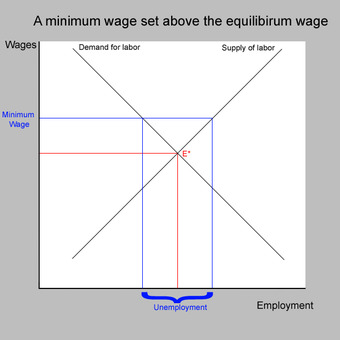
Raising Wages Above Equilibrium
If a union is able to raise the minimum wage for their members above the equilibrium wage, then wages will be higher but fewer workers will be employed.
Many economists criticize unionization, arguing that it frequently produces higher wages at the expense of fewer jobs. Essentially, unionization benefits the already employed at the expense of the unemployed. Further, by charging higher prices than the equilibrium wage rate, unions promote deadweight loss. Critics also argue that if some industries are unionized and others are not, wages will decline in non-unionized industries.
Unions in Imperfect Labor Markets
The above arguments assume that without unions, the labor market would be competitive – that is, there would be many buyers and many sellers of labor. In this competitive equilibrium, the wage rate would equal the marginal revenue product of labor and the outcome would be efficient. In reality this is often not the case. Rather, many industries are dominated by only a few firms, making the labor market an oligopsony – a market with many sellers of labor but only a few buyers. In an oligopsony firms have the advantage over workers, and wages may be lower than they would be at the competitive equilibrium.
If we assume that the labor market is imperfect and that wages are naturally lower than the marginal revenue product of labor, unions may increase efficiency by raising wage rates closer to the efficient level. In this case, wages will rise without a resulting rise in unemployment.
Unions, Productivity, and Unemployment
The above arguments focus on how unions affect unemployment by negotiating for higher wages, but unions may also affect unemployment in other ways. Many argue that unions are capable of raising productivity by reducing turnover, increasing coordination between workers and management, and by increasing workers’ motivation. More productive workers means a higher marginal product of labor. Since the demand for labor is determined by its marginal product, increased productivity will cause demand to shift to the right and lead to an efficient equilibrium with both higher wages and lower unemployment.
22.3.4: Efficiency Wage Theory
Efficiency wage theory is the idea that firms may permanently hold to a real wage greater than the equilibrium wage.
Learning Objective
Define Efficiency Wage Theory
Key Points
- Efficiency wages are wages that are higher than the market equilibrium. Firms that pay efficiency wages could lower their wages and hire more workers, but choose not to do so.
- Some reasons that managers might choose to pay efficiency wages are to avoid shirking, reduce turnover, and attract productive employees.
- The consequence of the efficiency wage theory is that the market for labor does may not clear, even in the long run, and unemployment may be persistenly higher than its natural rate.
Key Terms
- turnover
-
The number of times a worker is replaced after leaving.
- shirking
-
To provide less quality work than is required.
Efficiency-Wage Theory
The market-clearing wage is the wage at which supply equals demand; there is no excess supply of labor (unemployment) and no excess demand for labor (labor shortage). In the basic economic theory, in the long run the economy will achieve this market-clearing equilibrium and will experience the natural level of unemployment. However, firms may choose to pay wages higher than the market-clearing equilibrium in order to incentivize increased worker productivity or to reduce turnover. This is called efficiency-wage theory.
Why Pay Efficiency Wages?
There are several theories of why managers might pay efficiency wages:
- Avoiding shirking: If it is difficult to measure the quantity or quality of a worker’s effort, there may be an incentive for him or her to “shirk” (do less work than agreed). The manager thus may pay an efficiency wage in order to increase the cost of job loss, which gives a sting to the threat of firing. This threat can be used to prevent shirking .
- Minimizing turnover: As mentioned above, by paying above-market wages, the worker’s motivation to leave the job and look for a job elsewhere will be reduced. This strategy makes sense when it is expensive to train replacement workers.
- Selection: If job performance depends on workers’ ability and workers differ from each other in those terms, firms with higher wages will attract more able job-seekers, and this may make it profitable to offer wages that exceed the market clearing level.
Consequence of Efficiency Wage
The consequence of the efficiency wage theory is that the market for labor does may not clear and unemployment may be persistently higher than its natural rate. Instead of market forces causing the wage rate to adjust to the point at which supply equals demand, the wage rate will be higher and supply will exceed demand. This produces higher wages for those who are employed but higher levels of unemployment.
22.3.5: Job Creation and Destruction
Jobs are created when workers become more productive, the price of output increases, or when total economic output increases.
Learning Objective
Summarize how jobs are created and destroyed on a firm, industry, and economy wide level
Key Points
- Firms will continue to demand labor until the marginal revenue product of labor equal the wage rate – that is, until the marginal benefit of one more employee equals the marginal cost of that employee.
- Any factor that increases the marginal revenue product of labor or that decreases the marginal cost of labor will create jobs.
- At a macroeconomic level, jobs are created when the general level of output rises and jobs are destroyed when the general level of output falls.
- In general, output rises when the demand for consumer goods increases. Thus, factors that stimulate consumer demand also encourage job creation.
Key Terms
- business cycle
-
A fluctuation in economic activity between growth and recession.
- marginal productivity
-
The extra output that can be produced by using one more unit of the input
Job Creation at the Microeconomic Level
Firms decide to create or lose jobs based on the price of output, the price of inputs, and the marginal productivity of inputs. Firms will continue to demand labor until the marginal revenue product of labor equals the wage rate – that is, until the marginal benefit of one more employee equals the marginal cost of that employee. For example, suppose a shoe factory can sell shoes for $50 a pair, and hiring an additional employee to work for an hour allows the factory to produce one extra pair of shoes. As long as the wage rate is less than $50/hour, the firm can increase its profit by hiring more worker and producing more shoes. Eventually, however, the factory will become crowded, workers will need to wait in line for access to necessary tools and machinery, or the supply of materials will fail to keep up with the production pace. This will cause the marginal productivity of labor to fall, so that an additional hour of work produces less than one extra pair of shoes. If the prevailing wage rate is $25/hour, the firm will hire until it takes two hours of work to produce one pair of shoes. At this point, the marginal benefit of hiring labor is $25, equal to the marginal cost.
Factors that increase the productivity of labor will increase demand for labor and create jobs. Suppose a new type of sewing machine is invented that is smaller and allows shoemakers to work more quickly. This increases the productivity of labor, so that at its previous employment levels the firm can now earn $35 for every hour of labor it employs. Just as before, the firm will create more jobs and continue to hire until the marginal revenue product of labor is again equal to the wage rate. Similarly, if the price of output rises firms will hire more employees. If the price of shoes increases to $60, for example, workers that were previously making $25 worth of shoes in an hour will be making $30 worth of shoes each hour instead. Since the wage rate is still $25, the firm will hire more workers until the marginal revenue product of labor is equal to the wage rate.
Job Creation at the Macroeconomic Level
At a macroeconomic level, jobs are created when the general level of output rises and jobs are destroyed when the general level of output falls. The quantity of labor employed and the wage rate are determined by the intersection of labor supply (the number of people willing to enter the workforce at any given wage) and the labor demand (the amount of labor producers are willing to employ at any given wage rate). Labor supply is based primarily upon the size of the population and therefore remains fairly stable. The labor demand, however, shifts to the left when an economy’s output falls, since firms will need fewer workers to produce fewer goods. Likewise, labor demand shifts to the right when an economy’s output rises. These shifts will destroy job and lower wages or create jobs and increase wages, respectively .
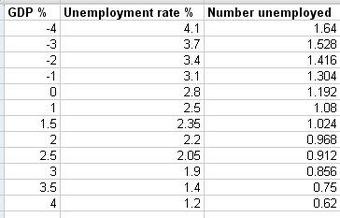
Output and Employment
As this hypothetical graph shows, when output (GDP) is rising, jobs are created and unemployment falls. When output is falling, jobs are destroyed and unemployment rises.
One reason that economic activity might rise or fall is the business cycle. The business cycle refers to the periods of expansions and contractions in the level of economic activities around the long-term growth trend. This is typically due to an increase or decrease in the economy-wide demand for consumer goods, but these cycles could also take place due to changes in production technology, changes in governmental policy, and many other factors.
At the macroeconomic level jobs may also shift between industries due to changes in demand or technology. For example, when health researchers uncovered facts about the health risks of smoking, the demand for cigarettes dropped and many jobs were lost in the tobacco industry. As for technology, the invention of the telephone created many jobs in telecommunications, but destroyed most of the jobs associated with telegraphs.
Chapter 21: Inflation
21.1: Defining, Measuring, and Assessing Inflation
21.1.1: Defining Inflation
Inflation is an increase in average price levels.
Learning Objective
Use the quantity theory of money to explain inflation
Key Points
- Inflation refers to the average changes in price economy-wide, not the change in price in a particular industry. Further, inflation refers to the rate of change in prices, not the level of prices at any one time.
- Most economists agree that in the long run, inflation depends on the money supply.
- The idea that increasing the supply of money increases the price levels is known as the quantity theory of money.
- In mathematical terms, the quantity theory of money is based upon the following relationship: M x V = P x Q; where M is the money supply, V is the velocity of money, P is the price level, and Q is total output.
- While most agree with the basic principles behind the quantity theory of money in the long run, many argue that it does not apply in the short run.
Key Terms
- money supply
-
The total amount of money (bills, coins, loans, credit, and other liquid instruments) in a particular economy.
- velocity of money
-
The average frequency with which a unit of money is spent on new goods and services produced domestically in a specific period of time.
- inflation
-
An increase in the general level of prices or in the cost of living.
Inflation is a persistent increase in the general price level of goods and services in an economy over a period of time. Specifically, the rate of inflation is the percent increase of prices from the start to the end of the given time period (usually measured annually).
When the general price level rises, each unit of currency buys fewer goods and services. Consequently, inflation reflects a reduction in the purchasing power per unit of money – a loss of real value in the medium of exchange and unit of account within the economy.
The decrease in purchasing power means that inflation is good for debtors and bad for creditors. Since debtors usually pay back loans in a nominal amount, they want to give up the least purchasing power possible. For example, if you borrowed money and have to pay back $100 next year, you’d like that $100 to be worth as little as possible. Conversely, creditors don’t like inflation because the money they are getting paid is can purchase less than if there were no inflation.
What Causes Inflation?
When looking at individual goods, price changes may result from changes in consumer preferences, changes in the price of inputs, changes in the price of substitute or complement goods, or many other factors. When looking at the inflation rate for an entire economy, however, these microeconomic factors are relatively unimportant.
Instead, most economists agree that in the long run, inflation depends on the money supply. Specifically, the money supply has a direct, proportional relationship with the price level, so if, for example, the currency in circulation increased, there would be a proportional increase in the price of goods. To understand this, imagine that tomorrow, every single person’s bank account and salary doubled. Initially we might feel twice as rich as we were before, but prices would quickly rise to catch up to the new status quo. Before long, inflation would cause the real value of our money to return to its previous levels. Thus, increasing the supply of money increases the price levels. This idea is known as the quantity theory of money .

Inflation and the Money Supply
While the two variables are not exactly equivalent in the short run, over time the money supply has had a direct relationship to the level of inflation. This is consistent with the quantity theory of money.
In mathematical terms, the quantity theory of money is based upon the following relationship: M x V = P x Q; where M is the money supply, V is the velocity of money, P is the price level, and Q is total output. In the long run, the velocity of money (that is, how quickly money flows through the economy) and total output (that is, an economy’s Gross Domestic Product) are exogenous. If all other factors are held constant, an increase in M will require an increase in P. Thus, an increase in the money supply requires an increase in the price level (inflation).
While most agree with the basic principles behind the quantity theory of money in the long run, many argue that it does not apply in the short run. John Maynard Keynes, for example, disagreed that V and Q are exogenous and stable in the near-term, and therefore a change in the money supply may not produce a proportional change in the price level. Instead, for example, an increase in the money supply could boost total output or cause the velocity of money to fall.
21.1.2: Measuring Inflation
Inflation is measured as a percentage rate of change in the level of prices.
Learning Objective
Describe inflation and how to measure it
Key Points
- Economists typically measure the price level with a price index.
- A price index is a number whose movement reflects movement in the average level of prices. If a price index rises 10%, it means the average level of prices has risen 10%.
- The price index is the proportion of the cost of a basket of goods in one period to the cost of the same basket of goods in a previous base period. If the price index is currently 103, for example, the inflation rate was 3% between the base period and today.
Key Terms
- market basket
-
A list of items used specifically to track the progress of inflation in an economy or specific market.
- purchasing power
-
The amount of goods and services that can be bought with a unit of currency or by consumers.
The inflation rate is widely calculated by calculating the movement or change in a price index, usually the consumer price index (CPI) The consumer price index measures movements in prices of a fixed basket of goods and services purchased by a “typical consumer”.
CPI is usually expressed as an index, which means that one year is the base year. The base year is given a value of 100. The index for another year (say, year 1) is calculated by
The percent change in the CPI over time is the inflation rate.
For example, assume you spend your money on bread, jeans, DVDs, and gasoline, and you’d like to measure the inflation that you experience with this basket of goods. In the base period you purchased three loaves of bread ($4 each), two pairs of jeans ($30 each), five DVDs ($20 each), and 10 gallons of gasoline ($3.50 each). The price of the basket of goods in the base period is the total money spent on this quantity of items at the base period prices; in this case, this equals $207.
Now imagine that in the current period, bread still costs $4, jeans are $35, DVDs are $18, and gasoline is $4. Using the quantities from the base period, the total cost of the market basket in the current period is $212. The price index is (212/207)*100, or 102.4. This means that the inflation rate between the base period and the current period was 2.4%.
In everyday life, we experience inflation as a loss in the purchasing power of money. When the inflation rate is 2.4%, it means that a dollar can buy 2.4% fewer goods and services than it could in the previous period. When inflation is steady, incomes will generally compensate for the effects of inflation by rising or falling at approximately the same rate as the general price level. Money saved as currency, however, will lose its value if inflation occurs .
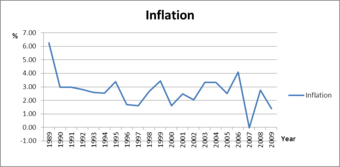
U.S. Inflation Rate
The U.S. inflation rate is measured by comparing the price of goods in one year to the price of goods in a previous base year.
21.1.3: Price Indices and the Rate of Change of Prices
Price indices are tools used to measure price changes for a specific subset of goods and services.
Learning Objective
Explain how inflation is measured through price indices
Key Points
- Price indices are often normalized and compared to a base year.
- The basket of goods determines which prices are being compared.
- The most commonly used formula is the Laspeyres price index, which determines a basket of goods during a base period, finds the price of this basket, and then compares that to the price of the same basket of goods in a later period of time.
- An alternate type of index, the Paasche index, finds a basket of goods in the current period, determines it’s total price, and compares that price to what the current basket of goods would have cost in the base period.
- The Consumer Price Index (CPI) and the Producer Price Index (PPI) are commonly used inflation indices. The CPI reflects changes in the prices of goods and services typically purchased by consumers.
- The PPI reflects changes in the revenue that producers receive for goods and services.
Key Terms
- cost of living
-
The average cost of a standard set of basic necessities of life, especially of food, shelter and clothing
- price index
-
A statistical estimate of the level of prices of some class of goods or services.
Price Indices
Price indices are tools used to measure price changes for a specific subset of goods and services. A price index is a statistic designed to help compare how a normalized average of prices differ between time periods. Broad price indices, such as the consumer price index (CPI) or the GDP deflator are often used to measure inflation throughout the entire economy, while narrower ones, such as the consumer price index for the elderly (CPI-E) measure the inflation experienced by specific groups of people or industries.
In order to calculate a price index, one must specify a base period and a basket of goods. The base period is the time period against which costs in other periods will be compared. Most often, the base period for an index is a single year and normalized. For example, a the CPI could select 1950 as the base year. In 1950, the CPI would have a value of 100 (this is not the cost of the basket, just a normalized value). Suppose that in 1960, the cost of the basket has increased 15%. The CPI in 1960 would then be listed as 115 (15% greater than the base year).
The basket of goods determines which prices are being compared. If a price index wanted to measure the inflation experienced by young people on the west coast of the United States, for example, it would first have to calculate which goods these particular consumers purchase and in what quantities. For example, this population may spend 40% of its income on housing, 10% on food, 10% on transportation, 20% on entertainment, and 20% on surfing supplies. The basket of goods should reflect these proportions.
Calculating Price Indices
There are different ways to calculate price indices. Suppose we want to find the inflation rate for consumers who, in the base period, bought an average of five CDs ($10 each), eight cans of soda ($1.5 each), and two pairs of shoes ($40 each). In the current period, the same type of consumer bought an average of four CDs ($12 each), six cans of soda ($2 each), and two pair of shoes ($45 each). One very basic approach to finding this price index might multiply the items’ cost and the quantity bought in the base period, and compare that to the cost and quantity in the current period. This calculation would give:
5*10+8*1.5+2*40 = 142 (base period)
4*12+6*2+2*45 = 150 (current period)
Price index = (150/142)*100 = 105.6
This would show that inflation was 5.6%.
However, this is not a very practical way to measure the change in prices since it compares two different baskets of goods. In this type of approach, a higher index number in the current period might mean that prices have gone up, but it might also mean that incomes have risen and people are simply buying more goods. The Laspeyres index and the Paasche index are two price indexes that attempt to compensate for this difficulty.
The most commonly used formula is a form of the Laspeyres price index, which determines a basket of goods during a base period, finds the price of this basket, and then compares that to the price of the same basket of goods in a later period of time. Using the example above, the base period index would be 5*10+8*1.5+2*40=142, and the current period index would be 5*12+8*2+2*45 = 166. The Laspeyres price index is (166/142)*100=116.9, giving an inflation rate of 16.9%.
An alternate type of index, the Paasche index, finds a basket of goods in the current period, determines it’s total price, and compares that price to what the current basket of goods would have cost in the base period. Again, using the above example, the base period index would be 4*10+6*1.5+2*40=129, and the current period index would be 4*12+6*2+2*45=150. The Paasche index is (150/129)*100=116.3, giving an inflation rate of 16.3%.
Common Price Indices
Two common price indices are the Consumer Price Index (CPI) and the Producer Price Index (PPI). The CPI reflects changes in the prices of goods and services typically purchased by consumers, and includes price changes in imported goods. The CPI is often used to measure changes in the cost of living .
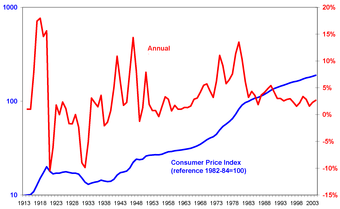
Consumer Price Index and Inflation
The above graph shows the annual inflation rate and the consumer price index from 1913 to 2003. As long as the inflation rate was above zero, the CPI was increasing.
The PPI, on the other hand, reflects changes in the revenue that producers receive in return for goods and services. The PPI, unlike the CPI, includes price changes for goods produced within the US but exported abroad. It also does not include sales and excise taxes, nor does it include distribution costs. While we often expect the CPI and PPI to show similar rates of inflation, they measure two different sets of price changes.
21.1.4: The Costs of Inflation
The costs of inflation include menu costs, shoe leather costs, loss of purchasing power, and the redistribution of wealth.
Learning Objective
Show inflation’s impact on purchasing power
Key Points
- In economics, a menu cost is the cost to a firm resulting from changing its prices. With high inflation, firms must change their prices often in order to keep up with economy-wide changes.
- Shoe leather cost refers to the cost of time and effort that people spend trying to counter-act the effects of inflation, such as holding less cash and having to make additional trips to the bank.
- Money loses value with inflation, leading to a drop in the purchasing power of an individual dollar. Unless wages increase with inflation, individuals’ purchasing power will also drop.
- Unexpected inflation redistributes wealth from creditors to debtors.
- Other costs of high and/or unexpected inflation include the economic costs of hoarding and social unrest.
Key Terms
- purchasing power
-
The amount of goods and services that can be bought with a unit of currency or by consumers.
- shoeleather costs
-
The cost of time and effort that people spend trying to counter-act the effects of inflation.
- menu costs
-
The cost to a firm resulting from changing its prices.
Economists generally regard a relatively low, stable level of inflation as desirable. When inflation is stable and expected, the economy is generally able to adjust easily to slowly rising prices. Further, a low level of inflation encourages people to invest their money in productive projects rather than keeping savings in the form of unproductive currency, since inflation will slowly erode the value of money. However, inflation does have some economic costs, especially when it is high or unexpected.
Menu Costs
In economics, a menu cost is the cost to a firm resulting from changing its prices. The name stems from the cost of restaurants literally printing new menus, but economists use it to refer to the costs of changing nominal prices in general. With high inflation, firms must change their prices often in order to keep up with economy-wide changes, and this can be a costly activity: explicitly, as with the need to print new menus, and implicitly, as with the extra time and effort needed to change prices constantly .

Menu Costs
The cost to a restaurant to change the prices on menus is incurred even with low and expected inflation.
Shoeleather Costs
Shoeleather cost refers to the cost of time and effort that people spend trying to counteract the effects of inflation, such as holding less cash, investing in different currencies with lower levels of inflation, and having to make additional trips to the bank. The term comes from the fact that more walking is required (historically, although the rise of the Internet has reduced it) to go to the bank and get cash and spend it, thus wearing out shoes more quickly. A significant cost of reducing money holdings is the additional time and convenience that must be sacrificed to keep less money on hand than would be required if there were less or no inflation.
Loss of Purchasing Power
By definition, inflation causes the value of an individual dollar to decrease over time. Each dollar has less purchasing power with inflation. Thus, individuals who have the same wage next year as this year will be able to purchase less. Purchasing power can be maintained if wages increase exactly at the rate of inflation, but this is not always the case. When wages increase less than the rate of inflation, people lose purchasing power.
Redistribution of Wealth
The effect of inflation is not distributed evenly in the economy, and as a consequence there are hidden costs to some and benefits to others from this decrease in the purchasing power of money. For example, with inflation, those segments in society which own physical assets (e.g. property or stocks) benefit from the price of their holdings going up, while those who seek to acquire them will need to pay more for them.
Their ability to do so will depend on the degree to which their income is fixed. For example, increases in payments to workers and pensioners often lag behind inflation, and for some people income is fixed.
Other Costs
Other costs of high and/or unexpected inflation include the economic costs of hoarding and social unrest. When prices are rising quickly, people will buy durable and nonperishable goods quickly as a store of wealth, to avoid the losses expected from the declining purchasing power of money. This can create shortages of hoarded goods and removes an economy from the efficient equilibrium. Further, inflation can lead to social unrest . For example, rises in the price of food is considered to be a contributing factor to the 2010-2011 Tunisian revolution and the 2011 Egyptian revolution (though it was certainly not the only one).

Hyperinflation in Zimbabwe
The photo shows bills worth millions and billions of dollars that were printed by the Zimbabwe government as a response to massive inflation. At one point the 50 billion dollar note was worth less than three US dollars.
21.1.5: Distribution Effects of Inflation
Unexpectedly high inflation tends to transfer wealth from creditors to debtors and from the rich to the poor.
Learning Objective
Discuss how inflation affects distribution and creates winners and losers
Key Points
- Inflation is good for borrowers and bad for lenders because it reduces the value of the money paid back to the lenders.
- The inflation rate is built in to the nominal interest rate, which is the sum of the real interest rate and expected inflation. When the inflation rate rises or falls unexpectedly, wealth is redistributed between creditors and debtors.
- In general, this means that those with savings in the form of currency or bonds lose money from inflation. Those with negative savings (debt) or savings in the form of stocks, however, are better off with higher inflation.
- In demographic terms, unexpected inflation often manifests as a wealth transfer from older individuals to younger individuals.
Key Terms
- nominal interest rate
-
The rate of interest before adjustment for inflation.
- Real interest rate
-
The rate of interest an investor expects to receive after allowing for inflation.
Whether one regards inflation as a “good” thing or a “bad” thing depends very much on one’s economic situation. Assuming that loans must be paid back according to a nominal amount (i.e. the borrower must pay back $100 in one year), inflation is good for borrowers and bad for lenders. When there is inflation, the value of the money borrowers pay back is less.
When inflation is expected, it has few distribution effects between borrowers and lenders. This is because the inflation rate is built in to the nominal interest rate, which is the sum of the real interest rate and expected inflation. For example, if the real cost of borrowing money is 3% and inflation is expected to be 4%, the nominal interest rate on a loan would be 7%. If the inflation rate unexpectedly jumps to 8% after the loan is made, however, then the creditor is essentially transferring purchasing power to the borrower. Since it benefits debtors and hurts creditors, in practice unexpected inflation is often a transfer of wealth from the rich to the poor .
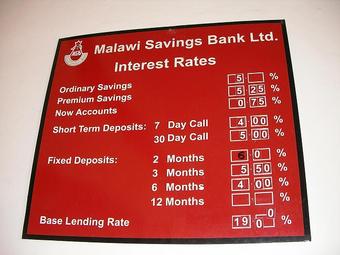
Interest Rates and Inflation
Part of the reason that lenders charge interest is to recoup the cost of inflation over time.
In general, this means that those with savings in the form of currency or bonds lose money from inflation. The lower purchasing power of money erodes the value of currency, and inflation reduces the real interest rate earned on bonds. Those with negative savings (debt) or savings in the form of stocks, however, are better off with higher inflation. Debtors find themselves paying a lower real interest rate than expected, and stocks tend to rise in value to reflect the inflation level. In demographic terms, this often manifests as a transfer from older individuals, who are wealthier and tend to hold their savings in more conservative assets such as cash and bonds, to younger individuals, who have more debt and tend to hold their savings in more aggressive assets such as stocks.
21.1.6: Deflation
Deflation is a decrease in the general price levels of goods and services.
Learning Objective
Define deflation and analyze its effects
Key Points
- When deflation occurs, the general price level is falling and the purchasing power of money is increasing.
- While there are problems associated with high inflation, economists generally believe that deflation is a more serious problem because it increases the real value of debt and may worsen recessions.
- Deflation discourages consumption because consumers know that if they wait to make a purchase, the price will likely drop.
- Deflation discourages borrowing and investment because the real value of the money to be repaid will be higher than the real value of the money borrowed.
- Some economists believe that deflation is caused by a fall in the general level of demand, while others attribute it to a fall in the money supply.
Key Terms
- deflationary spiral
-
A situation where decreases in price lead to lower production, which in turn leads to lower wages and demand, which leads to further decreases in price.
- purchasing power
-
The amount of goods and services that can be bought with a unit of currency or by consumers.
Deflation
Deflation is a decrease in the general price levels of goods and services. It occurs when the inflation rate falls below 0%. When this happens, the nominal prices of goods are falling on average and the purchasing power of money is increasing.
Effects of Deflation
While there are some problems associated with high levels of inflation, economists generally believe that deflation is a more serious problem because it increases the real value of debt and may worsen recessions.
Suppose you are a borrower that has borrowed $100 at a 5% interest rate to pay back in one year. Next year, you will give your lender $105 regardless of inflation. If there is no inflation, $105 next year buys the same amount as it does today. If there is inflation, $105 next year buys less than $105 does today. And if there is deflation, $105 next year buys more than $105 does today.
Deflation is good for lenders and bad for borrowers: when loans are paid back, the cash is worth more. Thus, deflation discourages borrowing, and by extension, consumption and investment today.
What Causes Deflation?
There are several theories about the causes of deflation. In the IS/LM model, deflation is caused by a shift in the supply and demand curve for goods and services. If there is a fall in how much the whole economy is willing to buy, for example, then the general demand curve shifts to the left and overall prices fall. Because the price of goods is falling, consumers have an incentive to delay purchases and consumption until prices fall further, which in turn reduces overall economic activity. Unemployment rises and investment falls, which in turn leads to further reductions in aggregate demand. This cycle of continuing inflation is called a deflationary spiral.
Recall that in monetarist theory, Money Supply*Velocity of Money = Price Level*Output. According to monetarist economists, therefore, deflation is caused by a reduction in the money supply, a reduction in the velocity of money, or an increase in the number of transactions. However, any of these may occur separately without causing deflation as long as they are offset by another change – for example, the velocity of money could rise and the money supply could fall without causing a change in price levels.
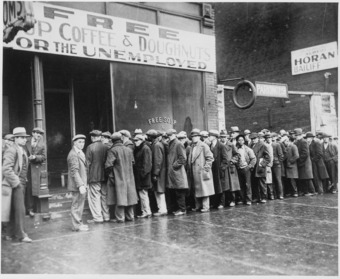
The Great Depression
Most economists agree that the high levels of deflation during the 1930s made the Great Depression much more severe and long-lasting. It discouraged consumption, borrowing, and investment that would increase economic activity.
Chapter 20: Economic Growth
20.1: Comparing Economies
20.1.1: Economic Growth as a Measuring Stick
Economic growth is measured as the increase in real gross domestic product (GDP) in the long-run, through higher resources or productivity.
Learning Objective
Examine the components that cause economic growth
Key Points
- Economic growth could also be described as an outward shift in the production-possibility frontier, allowing for the generation of a higher quantity of goods.
- While measuring real GDP is useful in some ways, and considered a standard measure of economic growth, there is a great deal more complexity than is being captured (both quantitatively and qualitatively).
- Classic growth theory uses the production function to measure economic growth, which ultimately implies that economic growth constantly compounds.
- Growth accounting came into popularity after the classic model, identifying the crucial role of technology in economic growth.
- A more educated workforce will result in increases in real output, as will advances in technology and innovation.
Key Terms
- inflation
-
The rise in the general level of prices of goods and services in an economy over a period of time.
- gross domestic product
-
A measure of the economic production of a particular territory in financial capital terms over a specific time period.
Economic growth can be defined as the increase in real gross domestic product (GDP) in the long-run, or as increased productivity or via an increase in the natural resources (inputs) that create output. It is important to note that real GDP adjusts for inflation, rather than looking at output in nominal dollars. Economic growth could also be described as an outward shift in the production-possibility frontier, allowing for the production of a higher quantity of goods (see ).

Production-Possibility Frontier
This outward shift in the Production-Possibility frontier is indicative of economic growth within the economy it represents.
Standard Measures of Economic Growth
Measuring economic growth is reasonably straight-forward, primarily focusing on either increases in productivity or increases in the available production inputs in a given system. This increase in productivity is converted into a relative percent based upon previous years, and expressed as a growth or decline. For example, if a given economy is producing $1,000,000 in 1900 and 1,050,000 in 1901, the economic growth rate (or GDP growth) will be expressed as 5%. If inflation is calculated to be 3% between 1900 and 1901, real economic growth will equate to 2%.
Alternative Economic Growth Models
While measuring real GDP is useful in some ways, and considered a standard measure of economic growth, there is a great deal more complexity than is being captured (both quantitatively and qualitatively). An outline of the perspectives of economic growth over time include:
- Classical Growth Theory: Dating back to Adam Smith and the foundation of capitalism, classical growth theory uses the production function to measure economic growth.
, where Y, K, L and N represent output, capital, labor and land respectively. In this model, the overall growth of an economy will compound exponentially and capture economies of scale, implying that economic expansion via consistent growth is a reasonable proposition. - Growth Accounting: Growth accounting came into popularity after the classical model, identifying the crucial role of technology in economic growth. Using the same classical growth equation, this method of measuring economic growth replaces the ‘land’ variable with ‘technology’ (technology including all of the contextual components that enable growth). In this scenario, technological leaps and bounds can be captured in the overall growth model.
- Salter Cycle: Economic growth is ultimately enabled by increases in productivity, and thus reductions in the required inputs to achieve each subsequent output per unit. As a result, an economy will continuously decrease price and thus increase demand, minimizing marginal utility over time and saturating markets.
- Endogenous Growth Model: This model takes into account technology, as in the growth accounting system discussed above, alongside increases in skills and intellectual capital. A more educated workforce will result in increases in real output, as will advances in technology and innovation.
- Energy Growth Theory: There has been a consistent correlation between economic growth and energy increase, alongside a paradox that increased energy and resource utilization efficiency actually increases consumption of that resource (similar to the Salter Cycle concept). As a result, energy growth theory economists identify a critical role of energy and resources in measuring overall economic growth.
20.1.2: How to Compare Economies Throughout History
Economies throughout history are defined by an evolution towards common currencies, global trade, and technologies driving productivity.
Learning Objective
Describe historical trends in rates of economic growth
Key Points
- Comparing historical economies and economic trends over the course of human history is a difficult endeavor, as the comparisons are not always equal.
- Babylonians are credited with generating the first metric to measure economic value (i.e. currency) and standardizing trade through leveraging this metric.
- The creation of the first official paper currency (or banknotes) by the Tang Dynasty in China around the 9th century.
- As the 20th century dawned, real world GDP is estimated to have quadrupled as a result of the advances in industry (see, technology, and intellectual innovations.
- Modern economies have been consistently measured for growth over the past couple centuries, underlining useful economic data on overall growth between nations. To simplify these comparisons, economic growth is generally assessed as general GDP.
Key Terms
- Bartering
-
Exchange goods or services without involving money.
- evolution
-
Gradual directional change especially one leading to a more advanced or complex form; growth; development.
- economic growth
-
The increase of the economic output of a country.
Comparing historical economies and economic trends over the course of human history is a difficult endeavor, as the comparisons are not always equal. The evolution of trade and the construction of measurement systems, currencies, standards, and the accuracy of historical record present a challenge to economists evaluating economies over time. That being said, timelines have been generated that capture useful insights, and modern economic comparisons (country to country) are growing increasingly accurate. Both of these perspectives shed light as to the overall patterns of economic growth over time.
Relevant Time Periods
For the sake of this discussion, four general time frames are useful to highlight:
- Stone Age: Including the Paleolithic, Mesolithic, and Neolithic time frames (up to 3500 B.C.), economics was virtually basic trade between small, local groups. This age is particularly worthy of note due to the crucial development of bartering and specialization. Specialization refers to the fact that a small group of people performing (and specializing) in different tasks can create substantially more value than every individual learning all tasks (think of Henry Ford’s assembly line).
- Antiquity: This includes the Bronze Age and the Iron Age, antiquity spans from 3500 B.C. around 500 A.D. As the names imply, the leveraging of natural resources (such as metals) were a critical step forward for trade. During this time frame the Babylonians are credited with generating the first metric to measure economic value (i.e. currency), and standardizing trade through leveraging this metric. This is an absolutely critical component to the ultimately measurement and comparison of economies from this time period forward.
- Middle Ages: The Silk Road is a famous economic historical element of this time frame, as is the creation of the first official paper currency (or banknotes) by the Tang Dynasty in China around the 9th century. The Middle Ages stretched from 500 A.D.-1500 A.D., and eventually saw the roots of accounting and financial trade roles in society.
- Modernity: From 1500 A.D. forward, trade grew increasingly global and increasingly standardized as a result. This era is marked by the Industrial Revolution, and the exponential productivity growth inherently found in technological advancement and standardized education systems. As the 20th century dawned, real world GDP is estimated to have quadrupled as a result of the advances in industry (see ), technology and intellectual innovations. Subsequently, population expanded as well.
With these four eras in mind, it is easy to empathize with economists attempting to unveil relative economic strength in the context of capitalist evolution. The modern age provides the most consistent data in which to analyze growth.
Comparing Modern Economies
Modern economies have been consistently measured for growth over the past couple centuries, underlining useful economic data on overall growth between nations. To simplify these comparisons, economic growth is generally assessed as general GDP (or increased productivity within a nation). The figure demonstrates these comparisons between 1990 and 2006, with a few countries standing out (China in particular).
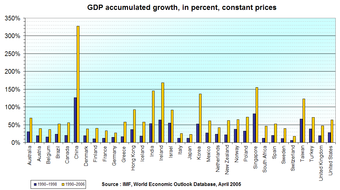
GDP Growth Across Nations
This graph underlines the important fact that economic growth is not mutually or equally distributed, resulting from a wide variety of factors with external and global systems.
Over time, countries can change significantly, and these changes must be considered in order to make accurate comparisons. Inflation, for example, changes the value of one unit of currency across time, so comparisons across time should be made using Real GDP, a GDP index, or another measure that accounts for changes in price.
There are also a number of other factors that must be taken into account such as GDP per capita, energy consumption, pollution metrics, education levels, innovation, etc. As you can imagine, it is difficult to compare countries across large time horizons, but, after controlling for as many of these effects as you can, comparisons are possible.
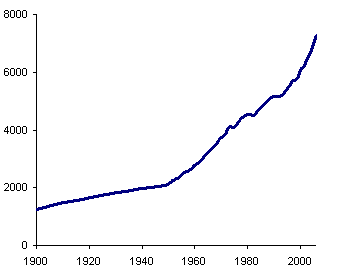
Economic Growth in the 20th Century
As a result of technological advances and increased intellectual capacity, real productivity increased by over 400% during this time frame.
20.1.3: Is Economic Growth a Good Goal?
Economic growth is typically viewed as positive, but there are mixed repercussions of increased productivity within an economic system.
Learning Objective
Identify the value of economic growth objectives.
Key Points
- The relationship between economic growth and the well-being of a society has largely been viewed as positive throughout the course of history.
- Economic growth increases consumer purchasing power and leisure time along with governmental purchasing power for societal benefits.
- The concept of uneconomic growth postulates that the costs of economic growth may outweigh the benefits, those costs being the environmental and societal repercussions.
- It is imperative that increased productivity can be created in a context in which the value can be captured in a positive and meaningful way.
- It is imperative that increased productivity can be created in a context in which the value can be captured in a positive and meaningful way.
Key Term
- Jevon’s Paradox
-
The proposition that technological progress that increases the efficiency with which a resource is used tends to increase the rate of consumption of that resource.
Throughout history, economists have typically assumed a positive relationship between economic growth (increased productivity) and the well-being of a society. It seems logical to assume that a stronger economy would create a higher standard of living. However, there is some debate surrounding the validity of this assumption. Is economic growth the appropriate objective?
Why is Growth Good?
Economic growth is the increase in the market value of the goods and services produced by an economy over time. Simply, more economic growth means that people are able to buy more of the things they like. Presumably, this translates into higher overall utility.
On a societal level, increases in GDP growth and overall productivity generates high prospective tax revenues, both on business profits and consumer purchases. Higher tax revenues will allow governments more financial flexibility to invest in social services such as education, welfare, transportation, etc.
Drawbacks to Economic Growth
There are, however, some downsides to economic growth, which are summarized in the idea of uneconomic growth. The concept of uneconomic growth postulates that the costs of economic growth – primarily environmental and social costs – may outweigh the benefits. There are a few specific observations of this that are worth noting:
- Jevon’s Paradox:Interestingly, increases in efficiency which drive increased economic growth often result in higher consumption. For example, when an economic system creates higher efficiency for generating electricity it will often increase the amount of electricity consumer in spite of that increased efficiency. This creates a culture of consumerism which is often wasteful.
- Malthusian Trap: Named after a political economist named Thomas Robert Malthus, the Malthusian trap simply states that increases in efficiency tend to result in population growth rather than wealth growth. Increased productivity within a system is only useful if it translates to an increase in per capita wealth.
- Imbalanced Distribution:Another issue is income distribution. This is what was meant by the adage that the rich get richer while the poor get poorer. It is quite common to see the rich absorb the vast majority of the value generated through increased productivity, creating a larger relative gap between the rich and the poor. In this circumstance there is limited utilitarian value to economic growth.
- Environmental Degradation: The final criticism is often the most discussed, particularly in light of the overwhelming evidence of global warming and the destructive nature of excessive consumption. It is also reasonable to consider the finite nature of natural resources (see ). Scientific modeling by environmental scientists often demonstrate significant long-term risks for the well-being of the ecosystem, posing a very real threat to the overall value in continued economic growth. Is it worth having more to consume if there is no ecosystem in which to enjoy it?
The important takeaway from this is to think carefully about the value created by economic growth. It is imperative that increased productivity can be created in a context in which the value can be captured in a positive and meaningful way.

Petroleum Consumption Over Time
This figure demonstrates the risk of over-consuming our natural resources, ultimately resulting in scarcity of necessary goods. A continued drive for economic growth could lead to overconsumption of natural resources.
20.2: Assessing Growth
20.2.1: Calculating Economic Growth
Economic growth is the increase in the market value of goods and services produced by an economy over time; the percentage rate of increase in the GDP.
Learning Objective
Calculate various measures of economic growth
Key Points
- In economics, economic growth refers to the growth of potential output. It shows how a country is developing its economy.
- The short-run variation in economic growth is called the business cycle. Economists use it to distinguish between short-run variations in economic growth and long-run economic growth.
- Long-run economic growth is measured as the percentage rate increase in the real gross domestic product.
- The GDP can be calculated using the product approach, income approach, or expenditure approach. The GDP is defined as the market value of all officially recognized final goods and services produced within a country in a given period of time.
Key Terms
- business cycle
-
A fluctuation in economic activity between growth and recession.
- gross domestic product
-
A measure of the economic production of a particular territory in financial capital terms over a specific time period.
- economic growth
-
The increase of the economic output of a country.
Economic Growth
Economic growth is defined as the increase in the market value of goods and services produced by an economy over time. It is usually measured as a percentage rate of increase in the real gross domestic product. In economics, economic growth refers to the growth of potential output. It shows how a country is developing its economy. Economic growth is directly impacted by human capital, which is the level of school or knowledge attainment in a country. The cognitive skills of a population directly impact economic growth. In general, economic growth is recorded and studied over the short-run and long-run.
Short-run Economic Growth
The business cycle refers to economy-wide fluctuations in production, trade, and economic activity over several months or years. The short-run variation in economic growth is called the business cycle. Economists use it to distinguish between short-run variations in economic growth and long-run economic growth. The cycle is made up of increases and decreases in production that occur over months and years. The changes in the business cycle are a result of fluctuations in aggregate demand .

The Business Cycle
The business cycle is used to determine the short-run variation in economic growth. Variations in the business cycle fluctuation over months and years and are attributed to fluctuations in aggregate demand.
Long-run Economic Growth
Long-run economic growth is measured as the percentage rate increase in the real gross domestic product. The GDP is defined as the market value of all officially recognized final goods and services produced within a country in a given period of time. There are three approaches used to determine the GDP:
- Product (output) approach: adds together the outputs of every class of enterprise to provide the total.
- Income approach: calculates the sum of all the producers’ incomes.
- Expenditure approach: the value of the total product must be equal to the people’s total expenditures.
In principle, all of the approaches should yield the same result for the GDP of a country.
For example, the equation for the expenditure approach is: GDP = C + I + G + (X – M).
Written out in full, the gross domestic product (GDP) equals private consumption (C) plus, gross investment (I), government spending (G), and the exports minus the imports (X – M).
For economic purposes, the economic growth is calculated and compared to the population, also know as per capita income (indicator of a country’s standard of living). When the per capita income increases it is called intensive growth. When the GDP growth is only caused by increases in population or territory it is called extensive growth.
20.2.2: Growth in the United States
The economy in the United States is the world’s largest single national economy; 2013 GDP estimation was $16.6 trillion.
Learning Objective
Describe historical growth in the US
Key Points
- Currently, the U.S. has a mixed economy, a stable GDP growth rate, moderate unemployment, and high levels of research and capital investment.
- Throughout its history, the U.S. has experienced economic growth in varying degrees. Time periods can be broken down by century and by decades.
- The U.S. economy experienced its most extensive growth from 1961 to 1969.
Key Terms
- financial crisis
-
A period of serious economic slowdown characterized by devaluing of financial institutions often due to reckless and unsustainable money lending.
- recession
-
A period of reduced economic activity
- economic growth
-
The increase of the economic output of a country.
Economic Growth
Economic growth is defined as the increase in the market value of the goods and services produced by an economy over time. It is measured as the percentage rate of increase in the real gross domestic product (GDP). To determine economic growth, the GDP is compared to the population, also know as the per capita income. When the per capita income increases it is called intensive growth . When the GDP growth is only cause by an increase in population or territory it is called extensive growth.
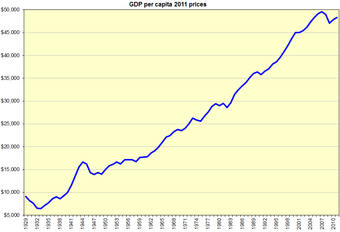
U.S. GDP per capita (1929-2010)
This graph shows the GDP per capita in the United States from 1929 to 2010. The GDP per capita is the ratio of the GDP to the population. This graph shows the intensive growth of the United States during this time period.
U.S. Economy
The economy in the United States is the world’s largest single national economy. In 2013, the estimated GDP was $16.6 trillion, which is a quarter of the nominal global GDP. Currently, the U.S. has a mixed economy, a stable GDP growth rate, moderate unemployment, and high levels of research and capital investment.
U.S. Economic Growth
Throughout its history, the U.S. has experienced economic growth in varying degrees. Various historical time periods illustrate the rate of growth:
- Prior to industrialization: technological progress caused an increase in population, which was kept in check by food supply and other resources. The per capita income was limited.
- Industrial Revolution: a period of rapid economic growth. Despite the initial excess of population growth, the growth did eventually slow down; a condition called demographic transition. During the first Industrial Revolution mechanization was introduced. During the second Industrial Revolution, wind and water power replaced human and animal labor. This increased the level of production.
- 20th century growth: most economic growth in the 20th century was due to reduced inputs of labor, materials, energy, and land per unit of economic output. The growth was more balanced because more inputs were used due to the growth of output. Also, this time period experienced the production of new goods and services through innovations.
- 1920s: during this time period there was overproduction which was one cause of the Great Depression in the 1930s. Economic growth resumed following the depression and was aided by the demand for new goods and services (telephones, radios, televisions, etc. ).
- 1940 to 1970: the U.S. economy grew by an average of 3.8% and the real median household income surged 74% (2.1% a year).
- 1960s: the U.S. economy experienced its most extensive periods of economic growth from 1961 to 1969 with an expansion of 53% (5.1% a year).
- 1970s: the economy experienced slower growth after 1973. The average growth was 2.7%, there were stagnant living conditions, and household incomes increased by 10% (0.3% annually). The 1973 oil crisis caused the GDP to fall 3.7%. The GDP fell again in late 1973 to 1975 (3.1%).
- 1980s: the U.S. share of the world GDP peaked in 1985 with 23.78% of global GDP. There was a recession from 1981 to 1982 when the GDP dropped by 2.9% .
- 1990s: there was a mild recession in 1990 to 1991 when the output fell by 1.3%.
- 2000s: one of the worst recessions in recent decades occurred in 2008 when the GDP fell by 5.% in one year. The 2008 financial crisis was caused by a derivatives market, the subprime mortgage crisis, and a declining dollar value.
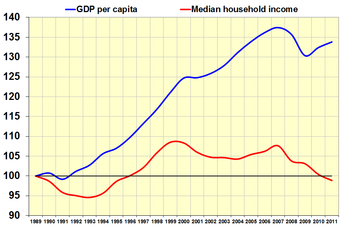
U.S. GDP vs. Household Income (1989-2011)
This graph shows the relationship of the GDP in the United States to the household income. This period from 1989 to 2011 was hit by a number of recessions.
20.2.3: Growth in the Rest of the World
On a global scale, economic growth is the sum of the growth of individual countries to give a worldwide total.
Learning Objective
Describe historical growth in developing and developed countries
Key Points
- Economic growth and global impact varies by country based on the individual economy, the development of the country, accumulation of human and physical capital, and level of productivity.
- Due to the vast number of countries globally, the world economy is usually determined in monetary terms, even in cases where no efficient market is available to evaluate goods and services.
- From 1990 to 2000 the U.S. dominated in expansion. From 2006 to 2006, China’s expansion moved closer to that of the United States. China led in expansion in 2007.
- The global credit crisis started in 2008 and expanded in 2009. By 2010, the U.S. had experienced some economic recovery while the global economic growth had lost momentum.
- From 2010 to 2018, China is expected to led in expansion. The global economic output is projected to expand.
Key Terms
- economic growth
-
The increase of the economic output of a country.
- purchasing power
-
The amount of goods and services that can be bought with a unit of currency or by consumers.
- gross domestic product
-
A measure of the economic production of a particular territory in financial capital terms over a specific time period.
Economic Growth
Economic growth is the increase in the market value of goods and services produced by an economy over a period of time. It is measured as the percentage rate increase in the real gross domestic product (GDP). On a global scale, economic growth is the sum of the growth of individual countries to give a worldwide total. Economic growth and global impact varies by country based on the individual economy, the development of the country, accumulation of human and physical capital, and level of productivity .
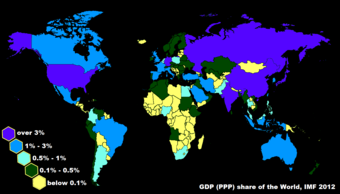
Share of World GDP
This image shows the share of GDP worldwide. The economic growth and global impact that each country has is influenced by the individual economy, the development of the country, accumulation of human and physical capital, and level of productivity.
Global Economic Growth
Due to the vast number of countries globally, the world economy is usually determined in monetary terms, even in cases where no efficient market is available to evaluate goods and services. The market valuations are translated into a single monetary unit using the idea of purchasing power. Analyzing economic growth in prominent countries provides an overview of global economic growth .
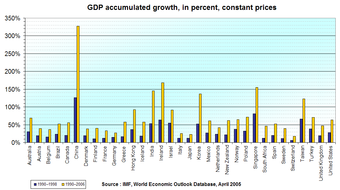
Change in GDP
This graph shows the change in GDP for countries around the world for 1900 to 1999 and 1999 to 2006. The GDP for each individual country is used to determine the global economic growth.
- 1980 to 1990: during this time period the economic output of 112 countries expanded while the output of 34 countries contracted. The purchasing power expanded for 145 markets and contracted for two. The five largest contributors to global output contraction were Argentina, Saudi Arabia, Nigeria, Venezuela, and Vietnam.
- 1990 to 2000: the United States dominated expansion during these years. The economic output expanded for 122 countries and contracted for 29. The purchasing power increased for 148 markets and contracted for three. The five largest contributors to global output contraction were Italy, Finland, Bulgaria, Algeria, and the Demographic Republic of Congo.
- 2000 to 2006: Expansion in China moved the country closer to the United States. The economic output for 176 countries expanded and four contracted. The five largest contributors to the expansion were the United States, China, Germany, the United Kingdom, and France. The purchasing power increased for 180 markets. The largest global output contributors were the United States, China, India, Japan, and Russia. From 2000 to 2010 these was a rise in developing and emerging economies.
- 2007: The nominal GDP expanded in 183 countries. The largest contributors were China, the U.S., Germany, and the United Kingdom.
- 2008: the credit crisis started. Economic output expanded in 171 countries, but 11 countries experienced output contractions. The United Kingdom accounted for half the global contraction while South Korea accounted for two-fifths. The crisis impacted most countries, but it was not deep enough to reverse growth.
- 2009: the credit crisis spread. The economic output of 127 countries contracted. The United Kingdom was impacted the most, followed by Russia and Germany. 56 countries experienced expansion of economic output, including China, Japan, and Indonesia. The purchasing power contracted for 79 markets. The U.S. was the largest victim and accounted for 18%, followed by Japan and Russia. 104 markets expanded purchasing power including China, India, and Indonesia.
- 2010: the economic output expanded for 148 countries and contracted for 35. The purchasing power increased for 169 markets and contracted for 14. It was noted that banks faced a “wall” of maturing debt. The U.S. experienced economic recovery, but the global economic growth lost momentum.
- 2011 to 2012: in 2011 it was projected that global growth would drop 4% followed by another 3.5% drop in 2012.
- 2010 to 2018: it is projected that China will lead economic growth during this period. The global economic output is expected to expand by $32.9 trillion.
Power of Annual Growth
Over long periods of time, small rates of growth have large economic effects. For example, the United Kingdom experienced a 1.97% average annual increase in its GDP from 1830 to 2008. The growth rate averaged 1.97% over 178 years and resulted in a 32-fold increase in the GDP by 2008. The GDP in 1830 was £41,373. It grew to £1,330,088 by 2008.
A growth rate of 2.5% a year leads to a doubling of the GDP within 29 years. A growth rate of 8% a year leads to a doubling of the GDP in 10 years. As a result, small differences in economic growth rates between countries can produced very different standards of living for the populations if the small growth rate continues for many years.
20.2.4: Catch-Up: Possible, but not Certain
Developing countries can catch up to developed countries by achieving growing faster, which is determined by a wide number of country-specific factors.
Learning Objective
Describe different factors that affect the growth rate of developing economies
Key Points
- Every country is unique based on population, technology, government, wealth, ect. Economic growth can be compared between countries, although no two countries are the same.
- Factors that influence economic growth include: growth of productivity, demographics, labor force participation, human capital, inequality, trade, quality of life, and employment rate.
- The economic growth of any country takes time to develop. Some countries have much larger, stronger, and more developed economies than other countries.
- It is possible, but not certain that smaller, underdeveloped economies can experience economic growth and catch-up to more prominent economies.
Key Terms
- economic growth
-
The increase of the economic output of a country.
- gross domestic product
-
A measure of the economic production of a particular territory in financial capital terms over a specific time period.
- demographics
-
The characteristics of human populations for purposes of social studies.
Economic Growth
Economic growth is defined as the increase in the market value of the goods and services produced by an economy over time. In order to assess economic growth it must be measured. It is the percentage rate of increase in real gross domestic product (GDP). When looking at the long-term economic growth of a country, it is important to analyze the ratio of the GDP to the population (GDP per capita).
For a developing country to catch up to a developed country, it must not only grow, but grow faster than the developed country. It is possible for such accelerated growth to occur, but there are many country-specific factors that affect a country’s ability to catch up to developed countries.
Factors that Impact Economic Growth
There are specific factors that have a direct impact on the economic growth of a country. Every country is unique based on population, technology, government, wealth, etc. Economic growth can be compared between countries, although no two countries are the same. Some of the factors that impact economic growth include:
- Growth of productivity: the growth of productivity is the ratio of economic output to input (capital, labor, energy, materials, and services). When productivity increases the cost of goods decreases causing an increase in the per capita GDP. Lower prices create an increase in higher aggregate demand. The growth of productivity is the driving force behind economic growth.
- Demographics: demographics change the employment to population ratio as well as the labor force participation rate. The age structure of the population affects the labor force participation rate. For example, when women entered the workforce in the U.S. it contributed to economic growth, as did the entrance of the baby boomers into the workforce.
- Labor force participation: the rate of labor force participation impacts economic growth. It is the number of people working in the labor force. When manufacturing increased, it created a higher productivity rate, but lowered the labor force participation, prices fell, and employment shrank.
- Human capital: human capital is referred to as the skills of the population. Education is a commonly used measurement for human capital. Human capital increases the society’s skill which increases economic growth.
- Inequality: inequality in wealth and income has a negative impact on economic growth. Inequality results in high and persistent unemployment. This has a negative effect on long-run economic growth.
- Trade: international trade represents a significant part of GDP for most countries. It is the exchange of goods and services across national borders.
- Quality of life: happiness has been shown to increase with a higher GDP per capita. Quality of life is a direct result of economic growth. When poverty is alleviated and society has access to what it needs, the quality of life increases. Consistent quality of life leads to continued economic growth.
- Employment rate: in order for the employment rate to have a positive impact on economic growth there must also be increases in productivity. If employment increases, but productivity does not, then there is a higher number of working poor.
Economic Growth in Developing Countries
The economic growth of any country takes time to develop. Some countries have much larger, stronger, and more developed economies than other countries . The study of the economic aspects of development in low-income countries is called development economics. It focuses on methods for promoting economic development. All of the factors listed previously impact economic growth – most of them positively. It is possible, but not certain that smaller, underdeveloped economies can experience economic growth and catch-up to more prominent economies.
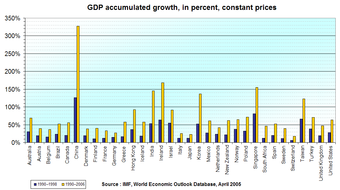
Change in GDP
This graph shows the change in GDP for various countries for the periods of 1990 to 1998 and 1990 to 2006. It is obvious that certain countries have larger and more developed economies than other countries. It is possible for countries with weaker economies to catch up with larger countries, but it is not certain.
20.3: Productivity
20.3.1: The Importance of Productivity
Increasing productivity is a rare win-win, improving the standard of living from a governmental, commercial and consumer perspective.
Learning Objective
Use the production function to determine how different variables affect output and productivity
Key Points
- Productivity is essentially the efficiency in which a company or economy can transform resources into goods, potentially creating more from less.
- Productivity can effectively raise living standards through decreasing the required monetary investment in everyday necessities (and luxuries), making consumers wealthier and business more profitable and in turn enabling higher government tax revenues.
- Economists looking to measure this productivity within a given system generally leverage production functions to determine how different factors of production (i.e. inputs) affect the overall output.
- The final important consideration in assessing productivity potential is the production-possibility frontier (PPF), which outlines the maximum production quantity of two goods in the scope of our current technological capacity and supply.
Key Terms
- productivity
-
the rate at which goods or services are produced by a standard population of workers.
- Production function
-
Relates physical output of a production process to physical inputs or factors of production.
Productivity is essentially the efficiency in which a company or economy can transform resources into goods, potentially creating more from less. Increased productivity means greater output from the same amount of input. This is a value-added process that can effectively raise living standards through decreasing the required monetary investment in everyday necessities (and luxuries), making consumers wealthier (in a relative sense) and businesses more profitable.
From a broader perspective, increased productivity increases the power of an economy through driving economic growth and satisfying more human needs with the same resources. Increased gross domestic product (GDP) and overall economic outputs will drive economic growth, improving the economy and the participants within the economy. As a result, economies will benefit from a deeper pool of tax revenue to draw on in generating necessary social services such as health care, education, welfare, public transportation and funding for critical research. The benefits of increasing productivity are extremely far-reaching, benefiting participants within the system alongside the system itself.
Productivity Beneficiaries
To expand upon this, there are three useful perspectives in which to frame the value in improving productivity within a system from an economic standpoint:
- Consumers/Workers: At the most micro level we have improvements in the standard of living for everyday consumers and workers as a result of increased productivity. The more efficiency captured within a system, the lower the required inputs (labor, land and capital) will be required to generate goods. This can potentially reduce price points and minimize the necessary working hours for the participants within an economy while retaining high levels of consumption.
- Businesses: Businesses that can derive higher productivity from a system also benefit from creating more outputs with the same or fewer inputs. Simply put, higher efficiency equates to better margins through lower costs. This allows for better compensation for employees, more working capital and an improved competitive capacity.
- Governments:Higher economic growth will also generate larger tax payments for governments. This allows governments to invest more towards infrastructure and social services (as noted above).
Factors Affecting Productivity
The final important consideration in assessing productivity potential is the production-possibility frontier (PPF), which essentially outlines the maximum production quantity of two goods (in the scope of our current technological capacity and supply). This demonstrates the confinement of productivity, and thus is well captured in the Leontief production function. The critical takeaway here is that the production function will generally be affected by two things: overall supply and technological capabilities. Note that demand does not come into account in altering the production function or overall productivity potential. The illustration in the following figure demonstrates an increase in PPF, thus affecting the production function.

Production-Possibility Frontier Expansion
In this graph, the prospective production-possibility frontier shifts to the right, implying a higher supply or improved technological production ability of the two goods being discussed (in this case guns and butter).
20.3.2: Measuring Productivity
Productivity is represented by production functions, and is the amount of output that can be generated from a set of inputs.
Learning Objective
Discuss different ways to measure productivity and productivity growth
Key Points
- From an economic standpoint, the production function demonstrates the tangible output created as a result of a production process including all tangible inputs.
- The objective in employing this perspective is to pursue allocative efficiency within the process (as opposed to technical or logistical efficiency, as engineers or supply chain managers may be pursuing).
- Generally speaking, the factors of production include land, labor and capital.
- There are a variety of ways to approach the measuring of productivity in the context of production functions, including the functional form, the linear form, the Cobb-Douglas production Function and the Leontief Production Function.
Key Terms
- Allocative efficiency
-
A type of economic efficiency in which economy/producers produce only those types of goods and services that are more desirable in the society and also in high demand.
- Liquid assets
-
An asset in the form of money or cash in hand, or an asset which can be quickly converted into cash without losing much value.
Productivity, in economic terms, measures inputs and outputs to derive overall production efficiency within a system. Simply put, it measures how much can you get out of what you put into a given system. Increased productivity means more output is produced from the same amount of inputs. In order to generate meaningful information about the productivity of a given system, production functions are used to measure it. Understanding the way in which productivity metrics function, one can more comprehensively grasp the concept and employ it in a meaningful way.
Production Function
From an economic standpoint, the production function demonstrates the tangible output created as a result of a production process including all tangible inputs. The objective in employing this perspective is to pursue allocative efficiency within the process (as opposed to technical or logistical efficiency, as engineers or supply chain managers may be pursuing). This means that the production function identifies optimal inputs (and consequent outputs) to satisfy the needs of a given population via a particular production process. While different economic perspectives often identify different factors of production (i.e. inputs in the system), it is useful to identify the following:
- Land/Natural Resources:Products of nature that have economic value, including metals/agriculture/livestock/land/etc.
- Capital: This is a broad term, capturing more than just financing and investment. Capital can also be fixed capital (i.e. machinery, equipment, buildings, computers, etc.) or working capital (i.e. goods, inventory and liquid assets). Concepts of human, intellectual and social capital is also highlighted, separate from the concept of labor below, which can affect the efficiency of a process.
- Labor: The human skills, time and efforts necessary to add value to the production process. This can range from highly tangible inputs (working hours, products assembled) to highly intangible inputs (entrepreneurship, experience, technology skills, etc.).
Conceptually, the production function makes certain assumptions of the maximum potential production, availability of inputs and demand for outputs to create a boundary of potential production. This will include the derivation of a marginal product for each factor (see ), or essentially the extra output that can be created for each additional unit of input. Naturally, this is theoretically subjected to the concept of diminishing marginal returns, where the marginal product of a given input (in the figure we are illustrating labor) will fall as the starting points for quantity rise.
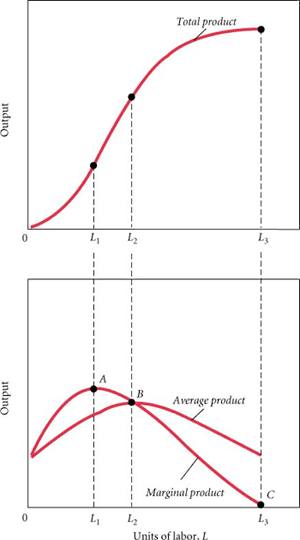
Product Function
This graph illustrates the way in which a production function identifies the relationship between a quantity of inputs and the resulting output of a given product. This takes into account marginal and average product, which are indicative of the change in efficiency based upon inputs.
Forms of the Production Function
There are a variety of ways to approach the measuring of productivity in the context of production functions:
- Functional Form: One way a production function can be illustrated is through the following equation
. In this circumstance ‘Q’ is the quantity of output while each ‘x’ is a factor input. - Linear Form: While this is generally not practical in practice, it is also possible to represent this in a linear mathematical fashion if parameters (a, b, c, and d below) are identified:
- Cobb-Douglas Production Function: One of the most useful frameworks, that allow for a technological relationship to be illustrated between the amount of two (or more) inputs is the Cobb-Douglas model. This is most often used to illustrate how physical capital and labor effect one another (see ). In the equation, ‘Y’ is total production while ‘L’ is labor, ‘K’ is capital, ‘A’ is total factor productivity and the alpha and beta are the elasticity of the two inputs.
- Leontief Production Function: The Leontief Production Function assumes a technologically pre-determined set of proportions for the factors of production (i.e. no ability to substitute between factors. This is specifically designed to capture minimums or limiting cases of production. The ‘z’s in the equation are inputs of specific goods while the a and b represent the technological determined constants and ‘q’ being the overall output:
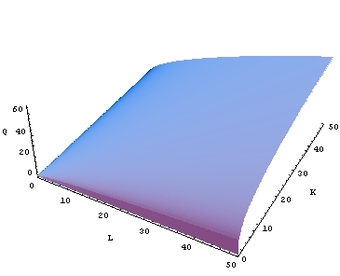
Cobb-Douglas Production Function
This is an illustration of a two-input Cobb-Douglas Production Function, where the ability to benchmark an output in comparison to two separate quantities of inputs is feasible.
20.3.3: Impacts of Technological Change on Productivity
Technological advances play a crucial role in improving productivity, and thus the standard of living in a system.
Learning Objective
Analyze how changes in technology affect productivity and productivity growth
Key Points
- Productivity growth is bound by what is called the production-possibility frontier (PPF), which essentially stipulates a series of maximum amounts of two commodities that can be generated using a fixed amount the relevant factors of production.
- The variance in technological advances that have driven productivity upwards is remarkable, underlining the ongoing importance of focusing on technology as a primary change agent.
- Advances in energy systems, transportation, communication, logistics, and a variety of other technological trajectories have greatly enabled an increased standard of living through advancing productivity.
- Measuring the affects of technology on productivity is a difficult pursuit. It is generally approached through metrics such as Gross Domestic Product (GDP), GDP per capita, and Total Factor Productivity (TFP).
Key Terms
- Production-Possibility Frontier (PPF)
-
A graph that shows the various combinations of amounts of two commodities that could be produced using the same fixed total amount of each of the factors of production.
- productivity
-
A ratio of production output to what is required to produce it (inputs).
Productivity measures the way in which an economic system or business can leverage available functional inputs to generate meaningful outputs. This concept drives economies towards higher degrees of efficiency in production and thus higher economic growth and standards of living. As a result, improving productivity is a critical objective for societies to increase their relative wealth. Technological advances play a crucial role in improving productivity, and thus the standard of living in a system.
Production-Possibility Frontier
Productivity growth is bound by what is called the production-possibility frontier (PPF), which essentially stipulates a series of maximum amounts of two commodities that can be generated using a fixed amount the relevant factors of production . In the context of a given PPF, only an increase in overall supply of inputs or a technological advancement will allow for the PPF to shift out and allow for an increase in potential outputs of both goods simultaneously (represented by point ‘X’ in the figure). The shift due to changes in technology represents increased productivity. This is a critical component in understanding the role of technology in productivity, as it is a primary influence on increasing the prospective production possibilities.

Production-Possibility Frontier (PPF)
This graph illustrates the varying theoretical takeaways from a PPF chart. On this, points B, C, and D all lie on a maximum output level, while A is representative of a realistic but inefficient amount. X is beyond the scope of the PPF graph, and thus requires a technological improvement or increase in supply.
Technological Advances: Past, Present, and Future
The variance in technological advances that have driven productivity upwards is remarkable, underlining the ongoing importance of focusing on technology as a primary change agent. Innovative advances in technologies can be either leaps or increments, although the larger technological advances tend to take the limelight. In general, there are a particularly notable categories:
- Energy: Historically, animals and humans were the primary energy input for the generation of products. This was extremely expensive and time-consuming relative to more modern ways to power things, and has been improved upon dramatically over time. Electricity, heat, steam, water, solar, and a wide variety of other energy capturing methodologies have dramatically increased efficiency while freeing up man hours.
- Transportation and Industrial Machinery: Trade has been a part of human history for nearly as long as civilizations knew of one another, bartering being the a central component of human interaction. The improvement of trade venues, such as boats, cars, planes, trains, etc. have enabled rapid increases in trade quantity and efficiency. Similarly, industrial machinery utilizing similar vehicles have enabled mass increases in scale and efficiency, particularly agriculture .
- Communication:Needless to say, the internet and mobile communications have rapidly expedited the transmission of knowledge, data, information, and networking. This has resulted in a massive increase in synergy across the world, alongside the development of economic learning and development.
- Logistics: Increases in technological systems is generally considered to be a tangible innovation, but is not limited to such. Improvements in the ways in which we do things is often just as useful. Henry Ford is a classic example of this, innovating the assembly line to maximize the efficiency the production process through strategic implementation of labor roles.
Implications on Productivity
Measuring the effects of technology on productivity is a difficult pursuit. It is generally approached through metrics such as Gross Domestic Product (GDP), GDP per capita, and Total Factor Productivity (TFP). The former two attempt to capture the overall output of a given economy from a macro-environmental perspective. The latter is slightly more interesting, attempting to measure technologically driven advancement through noting increases in overall output without increases in inputs. This is done through utilizing production function equations and identifying when the output is greater than the supposed input, implying an advance in the external technological environment. This system is more specifically tailored for technological change than GDP.
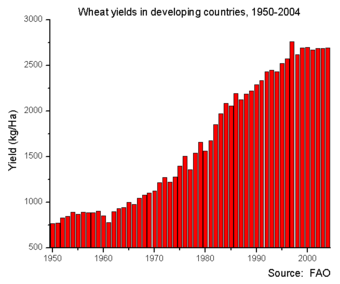
Wheat Yield
Over the past 60 years, wheat yield (PPF) has dramatically improved as a result of critical technological and logistic advancements.
20.4: Long-Run Growth
20.4.1: Determinants of Long-Run Growth
Long-run growth is defined as the sustained rise in the quantity of goods and services that an economy produces.
Learning Objective
Predict how population growth will affect the level of capital per worker
Key Points
- Economic growth is the increase in the market value of the goods and services that an economy produces over time. It is measured as the percentage rate change in the real gross domestic product (GDP).
- Determinants of long-run growth include growth of productivity, demographic changes, and labor force participation.
- When the economic growth matches the growth of money supply, an economy will continue to grow and thrive.
- Inflation occurs in an economy when the prices of goods and services continue to rise while the purchasing power decreases.
- When the GDP growth is only caused by increases in population, the growth is excessive.
Key Terms
- inflation
-
An increase in the general level of prices or in the cost of living.
- economic growth
-
The increase of the economic output of a country.
Long-Run Growth
Economic growth is the increase in the market value of the goods and services that an economy produces over time. It is measured as the percentage rate change in the real gross domestic product (GDP) .
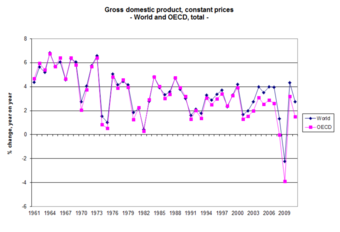
Measuring the GDP
Economic growth is the percentage rate increase in the GDP. Long-run growth is directly impacted by the GDP.
Long-run growth is defined as the sustained rise in the quantity of goods and services that an economy produces. The GDP of a country is closely tied to the growth of the population in addition to prices and supply and demand.
Determinants of Long-Run Growth
There are specific determinants that impact the long-run growth of an economy:
- Growth of productivity: is the ratio of economic outputs to inputs (capital, labor, energy, materials, and services). When the productivity increases the cost of goods is lowered. Lower prices increase the demand for the product or service. An increase in demand can lead to higher revenue.
- Demographic changes: demographic factors influence economic growth by changing the employment to population ratio. Factors include the quantity and quality of available natural resources. Age structure of the population also influences employment and long-run growth.
- Labor force participation: the amount of labor force participation and the size of economic sectors influence economic growth. The labor force participation is the amount of workers available. In countries with high development and industrialization, labor force participation is high because of low birth and death rates.
Inflation and Excessive Growth
When the economic growth matches the growth of money supply, an economy will continue to grow and thrive. In this case, population growth would increase, but the need for goods and services would also increase. As a result, more jobs would be available and the employment rate would also increase.
However, when economic growth is not balanced, the result can include inflation and excessive growth. Inflation occurs when the price of goods and services are rising which causes purchasing power to fall if wages don’t also rise . A decrease in the demand for goods and services will lead to a decrease in revenue and employment. A high rate of population growth will cause less capital per worker, lower productivity, and lower GDP growth.

Inflation
Inflation occurs when the price of goods and services are rising which causes purchasing power to fall if wages don’t also rise. Inflation is a negative effect of economic growth that is not balanced.
When the GDP growth is only caused by increases in population (not increases in supply, demand, revenue) the growth is excessive. In order for an economy to be successful, it must meet the needs of the population (supply, demand, revenue, and employment). When a population grows too fast the economic system cannot support the changes. Excessive growth leads to an imbalance in supply and demand and higher levels of unemployment. The quality of living decreases when the economy cannot support the population growth.
20.4.2: Aggregate Production
The aggregate production function examines how the productivity depends on the quantities of physical capital per worker and human capital per worker.
Learning Objective
Discuss how aggregate production impacts long-run growth
Key Points
- Aggregate production functions create an estimated framework to determine how much of an economies’ growth is related to changes in capital or changes in technology.
- The aggregate production function describes the boundary representing the limit of output attainable from each feasible combination of input.
- The aggregate production takes the physical outputs and inputs into account to determine the allocative efficiency of the economy as a whole.
- The long-run growth of a firm can change the scale of operations by adjusting the level of inputs that are fixed in the short-run, which shifts the production function upward as plotted against the variable input.
Key Terms
- physical capital
-
A physical factor of production (or input into the process of production), such as machinery, buildings, or computers.
- human capital
-
The stock of competencies, knowledge, social and personality attributes, including creativity, embodied in the ability to perform labor so as to produce economic value.
Aggregate Production
The aggregate production function examines how productivity, or real GDP per worker, depends on the quantities of physical capital per worker and human capital per worker. The production function relates the physical outputs of production to the physical inputs or factors of production. The aggregate production takes the physical outputs and inputs into account to determine the allocative efficiency of the economy as a whole.
Aggregate production functions create an estimated framework to determine how much of an economy’s growth is related to changes in capital or changes in technology. Production functions assume that the maximum output is attainable from a given set on inputs. The aggregate production function describes the boundary representing the limit of output attainable from each feasible combination of input.
To understand how the aggregate production impacts long-run growth, it is important to understand the stages of production :
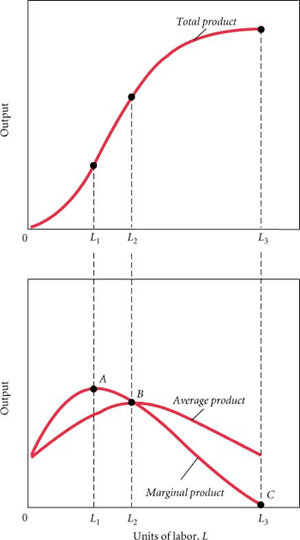
Graphing Production
The production function of a firm or economy can be graphed using the total, average, and marginal products. The aggregate production is determined based on the stages of production and the results of the graph.
- Stage 1: the variable input is being used with increasing output per unit. The average physical product is at its maximum.
- Stage 2: output increases at a decreasing rate and the average and marginal physical product are declining. The average product of fixed inputs are still rising. The optimum input/output combination will be reached.
- Stage 3: variable input is too high relative to the available fixed inputs. The output of both fixed and variable input declines.
Aggregate Production and Long-Run Growth
The long-run growth of a firm can change the scale of operations by adjusting the level of inputs that are fixed in the short-run, which shifts the production function upward as plotted against the variable input. Aggregate production functions study the short-run inputs and outputs of a firm or economy. The results allow adjustments to be made which improves the long-run growth by balancing the inputs and outputs.
20.4.3: Changing Worker Productivity
In economics and long-run growth, worker productivity is influenced directly by fixed capital, human capital, physical capital, and technology.
Learning Objective
Examine the role of human capital in production and economic growth
Key Points
- Human capital is defined as the stock of competencies, skills, and knowledge that allows individuals to produce economic value.
- Human capital has been show to increase economic development, productivity growth, and innovation.
- When individuals and societies invest in human capital it strengthens the future of the long-run economic growth. The qualitative and quantitative progress of a country is inevitable when human development is a priority.
- When a society invests in human capital, it increases worker productivity and economic growth. Human capital grows cumulatively over a long period of time.
Key Terms
- human capital
-
The stock of competencies, knowledge, social and personality attributes, including creativity, embodied in the ability to perform labor so as to produce economic value.
- productivity
-
A ratio of production output to what is required to produce it (inputs).
Worker Productivity
In economics and long-run growth, worker productivity is influenced directly by fixed capital. The four types of fixed capital include: useful machines, instruments of the trade; buildings as the means of procuring revenue; improvements of land; and the acquired and useful abilities of all the inhabitants or members of society.
One way to increase worker productivity is to invest in better machinery, for example. A worker with a more productive tool in more productive.
Another way to increase productivity is to find ways to increase the revenue of the product generated by the workers. Since productivity is measured in dollars per worker, being able to generate more revenue from the same output is reflected in an increase in worker productivity.
Perhaps most interesting, though, is how to change worker productivity through human capital.
Human Capital
Human capital is defined as the stock of competencies, knowledge, social and personal attributes, including creativity, embodied in the ability to perform labor so as to produce economic value. Many economic theories tie education to economic growth explaining that it is an investment in human capital development . Human capital has been shown to increase economic development, productivity growth, and innovation.

Education
Education increases human capital and worker productivity.
A human resource is transformed into human capital with the effective inputs of education, health, and moral values. When individuals and societies invest in human capital it strengthens the future of the long-run economic growth. The qualitative and quantitative progress of a country is inevitable when human development is a priority. Over time, when worker productivity increases the quality and quantity of the goods and services will also increase.
Importance of Worker Productivity
When a society invests in human capital, it increases worker productivity and economic growth. Human capital and increased worker productivity are critical because they are different from the tangible monetary capital or revenue. It is important thought that an economy recognizes the importance of monetary capital. Worker productivity in the long-run is related to real income. If the real income falls over time it will negatively impact worker productivity. Economic revenue goes up and down due to shocks in the business cycle. Human capital grows cumulatively over a long period of time. When a society focuses on human capital and in turn worker productivity, the long-run economic growth will be steady. Economic inputs towards education, health, and worker productivity impacts future generations by ensuring that they will be more advanced and efficient than the current generation. The increase in worker efficiency is the direct result of a superior quality of manpower created through increased human capital.
20.4.4: Technological Change
In economics, technological change is a term used to describe the change in a set of feasible production possibilities.
Learning Objective
Assess the value of technology to a nation’s economic growth
Key Points
- Growth is defined as the increase in output per capita of a country over a long period of time. One primary factor that influences the growth of an economy is technological change.
- When looking at long-run growth, technological change in the economic environment makes production more or less efficient.
- Technology is defined as the making, modification, usage, and knowledge of tools, machines, techniques, systems, and methods of organization in order to solve a problem, improve a preexisting solution to a problem, or achieve a goal.
- The expansion and sharing of technology leads to the further development of goods, processes, applications, materials, and services. All of these areas are critical to the advancement of an economy in the long-run.
- The expansion and sharing of technology leads to the further development of goods, processes, applications, materials, and services. All of these areas are critical to the advancement of an economy in the long-run.
Key Terms
- technology
-
The study of or a collection of techniques.
- output
-
Production; quantity produced, created, or completed.
Technological Change
In economics, growth is defined as the increase in output per capita of a country over a long period of time. One primary factor that influences the growth of an economy is technological change. Technological change is a term used to describe the change in a set of feasible production possibilities. Technological improvement has the ability to increase the amount of output an economy can produce, even if the level of inputs remains constant .

Technological Change
Technological change causes the production possibility frontier to shift outward and initiate economic growth.
Technology and Long-Run Growth
Technology is defined as the making, modification, usage, and knowledge of tools, machines, techniques, systems, and methods of organization in order to solve a problem, improve a preexisting solution to a problem, or achieve a goal . In economics, improvements in technology have helped develop more advanced economies (for example, today’s global economy).
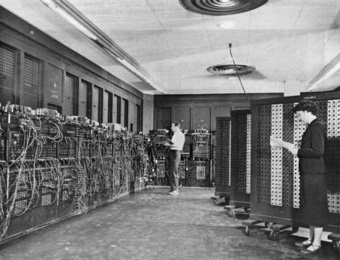
ENIAC
ENIAC, the first general purpose computer, was a technological advancement that affected both productivity and the types of outputs that could be produced.
In a developing country, the government works to ensure that the technologies, skills, knowledge, and methods of manufacturing are tested and developed so that they can be passed on to a broader audience. The expansion and sharing of technology leads to the further development of goods, processes, applications, materials, and services. All of these areas are critical to the advancement of an economy in the long-run.
The field of economics is constantly evolving as is the production of goods and services. In order to advance and continue to grow all markets need to make use of new technology to stay competitive. In the case of long-run economic growth, using the most advanced technology provides a market with a competitive advantage. Advances in technology creates an increased level of output with the same inputs, which improves productivity.
20.4.5: Government Activity
Government activity and policies have a direct impact on long-run growth. It can invest, and operate through monetary and fiscal policy.
Learning Objective
Discuss the long-run implications on growth from government policies
Key Points
- Long-run growth is the increase in the market value of goods and services produced by an economy over a period of time.
- The government may choose to invest in projects that are associated with long-term growth, such as infrastructure.
- Monetary and fiscal policy are used to regulate the economy, economic growth, and inflation so that long-run growth is possible.
- Government activities used to improve long-run growth include stimulating economic growth, enacting monetary policies, fixing the exchange rates, and using wage and price controls.
Key Terms
- economic growth
-
The increase of the economic output of a country.
- monetary policy
-
The process by which the central bank, or monetary authority manages the supply of money, or trading in foreign exchange markets.
Economic Growth
In macroeconomics, long-run growth is the increase in the market value of goods and services produced by an economy over a period of time. The long-run growth is determined by percentage of change in the real gross domestic product (GDP) . In order for an economy to experience positive long-run growth its outputs and inputs must be in balance for an increase to occur in supply, demand, revenue, and employment. The long-run economic growth is determined by short-run economic decisions.
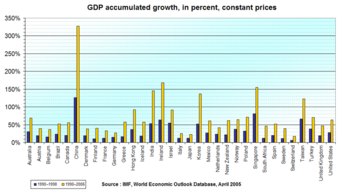
Gross Domestic Product
The change in GDP is used to determine economic growth within a country.
Government Activity
Government activity and policies have a direct impact on long-run growth. Long-run growth can be redirected and improved when changes are made to short-run actions. When an economy or industry experiences imbalanced in economic growth, the government can respond in order to assist in securing the market. Examples of possible government activity include:
- Investment: the government can stimulate economic growth by investing in the economy. Examples of stimulants include investing in market production, infrastructure, education, and preventative health care. This is especially important when excessive growth occurs. The government must stimulate economic growth to meet the needs of an increasing population.
- Monetary policy: the government enacts monetary policies to keep the growth rate of money steady. This helps to control excess inflation and excess short-term growth, both of which can negatively affect long-run growth. It’s important to note, however, that fiscal policy can also affect the level of inflation within an economy.
- Fiscal Policy: Choices in tax structure, government spending, and economic regulation can all impact long-run growth by affecting the choices that businesses and individuals make.
Government activity impacts long-run growth. It is critical that increasing populations have access to productive resources. It is also important that markets stay balanced in order to be successful and thrive.
20.4.6: Arguments in Favor and Opposed to Economic Growth
Economic growth has the potential to make all people richer, but may have downsides such as increased inequality and environmental impacts.
Learning Objective
Compare and contrast the consequences of economies in which growth is a goal
Key Points
- Over the long-run economic growth looks at the growth of the ratio of GDP to the population. Economic growth is an expansion of the economic output of a country.
- Arguments in support of economic growth include increased productivity, the expansion of power, and an increase in the quality of life.
- Arguments opposed to economic growth include resource depletion, environmental impacts, and equitable growth.
Key Terms
- quality of life
-
The general well-being of societies, including not only wealth and employment, but also the environment, physical and mental health, education, recreation and leisure time, and social belonging.
- economic growth
-
The increase of the economic output of a country.
Economic Growth
Economic growth is defined as the increase in the market value of goods and services produced by an economy over a period of time. It is measured as the percentage increase in the real gross domestic product (GDP) . In other words, economic growth is an expansion of the economic output of a country. Over the long-run economists might look at the per-capita rate of GDP growth (the growth of the ratio of GDP to the population).

GDP
The percentage increase in the GDP of a country is used to measure the country’s economic growth.
Arguments in Favor of Growth
There are numerous arguments in support of economic growth that describe its positive impact on society. Arguments in favor of economic growth include:
- Increased productivity: in countries that experience positive economic growth, the growth is often attributed to an increase in human and physical capital. Also, economic growth is usually accompanied by new and improved technological innovations.
- Expansion of power: economic growth is influential within a country even if the percentage of growth is small. With a small growth rate, a country will experience a substantial increase in power over the long-run. For example, a growth rate of 2.5% per annum leads to a doubling of the GDP within 29 years. In contrast, a growth rate of 8% per annum leads to a doubling of the GDP within 10 years. The power expansion associated with economic growth has long-run influences on a country.
- Quality of life: the quality of life increases in countries that experience economic growth. Economic growth alleviates poverty by increasing employment opportunities and labor productivity. It has been found that happiness increases with a higher GDP per capita, up to a level of at least $15,000 per person.
Arguments Opposed to Growth
There are a series of arguments that are opposed to economic growth. Arguments opposed to growth include:
- Resource depletion: economic growth has the potential to deplete resources if science and technology do not produce viable substitutes or new resources. Also, some arguments state that better technology and more efficient production will deplete resources quicker in the long-run even though advancements are perceived as positive right now.
- Environmental impact: some argue that a narrow view of economic growth combined with globalization could collapse the world’s natural resources. Portions of society have advocated the ideas of uneconomic growth and de-growth (economic contraction) in an attempt to lessen these effects of economic growth.
- Equitable growth: it has been found that while economic growth has a positive impact on society as a whole, it is common that poor sections of society are not able to participate in economic growth. Economic growth has many positive effects, but a society must not favor economic growth over solving pressing social issues such as poverty. For example, in a country with low inequality, a country with a growth rate of 2% per head and 40% of the population living in poverty can halve the poverty in 10 years. In contrast, if the same country has high inequality it will take nearly 60 years to achieve the same level of poverty reduction.
20.5: The Impact of Policy on Growth
20.5.1: Incentivizing Saving and Investment
The government can incentivize savings and investment by changing the relative cost of taking each action.
Learning Objective
Explain how the governments incentivize saving and investment
Key Points
- Monetary policy seeks to encourage investment by lowering interest rates and to encourage savings by borrowing them.
- Governments give tax breaks to industries in which it wants to encourage investment.
- Governments can also make certain types of savings tax exempt if it wishes to encourage savings.
Key Term
- monetary policy
-
The process of controlling the supply of money in an economy, often conducted by central banks.
Governments have a strong interest in affecting the savings and investments in an economy. Both savings and investment affect the overall economy. For example, if an economy is overheating, a government might want to disincentivize investment or consumption, and would therefore be interested in increasing the savings rate. If an economy is in a recession, a government would want to encourage savers to start spending or investing their money .
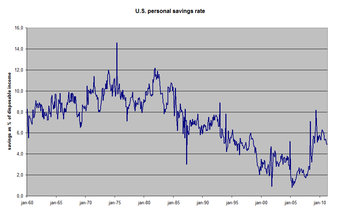
US Savings Rate
The US government may want to increase the savings rate if the economy is in a downturn, and increase it if the economy is overheating.
There are a number of ways in through which a government can incentivize savings and investment. Broadly, each incentive adjusts the cost of saving or investing. We will discuss two main ways to affect the savings and investment rates here.
Monetary Policy
One of the main tools of central banks is the interest rate that it charges banks to hold their money overnight. This rate is ultimately passed on to the bank’s depositors. Depositors, in turn, adjust their levels of savings and investment based on that rate.
Take, for example, a high interest rate. At a high interest rate, it is very expensive to borrow money: investors will not want to invest because they have to pay a lot of interest on their loans. Savers, on the other hand, love high interest rates: they earn a lot simply by keeping their cash in the bank. High interest rates encourage savings and discourage investment.
The precise opposite is true for low interest rates. When rates are low, investors know they can borrow money to finance investments cheaply. At the same time, savers aren’t earning much by keeping their money in the bank. Low interest rates encourage investment and discourage savings.
Much of a central bank’s actions are focused on adjusting how much people save and invest.
Taxes
The government can also incentivize savings and investment in a number of ways. The most common way of doing so is by adjusting tax rates. Governments offer individuals and firms who take the action it desires. For example, a government can offer a tax break to companies that are investing in a desirable area (e.g. medicine). It can also encourage savings through tax breaks. Roth IRAs are an instrument for saving for retirement that the US has made tax exempt (under certain conditions). In the first example, the government uses tax reductions to encourage investment for companies. In the second, the government encourages saving by helping savers earn more of the interest they earn over time in the savings vehicle.
20.5.2: Improving Education and Health Outcomes
A country can impact its long-term growth by affecting human capital through education and healthcare investments.
Learning Objective
Analyze the long-run implications on growth from education and healthcare policies
Key Points
- Both education and healthcare systems have short- and long-term costs, but can also be viewed as investments in human capital.
- Education economics studies the relationship between schooling and the labor market.
- Health economics is the branch of economics that focuses on issues relating to the efficiency, effectiveness, value, and behavior in the production and consumption of health and healthcare.
- According to the World Health Organization, a successful health policy defines a vision for the future, it outlines national priorities regarding health, and it builds a consensus and informs the public.
Key Terms
- economic growth
-
The increase of the economic output of a country.
- human capital
-
The stock of competencies, knowledge, social and personality attributes, including creativity, embodied in the ability to perform labor so as to produce economic value.
Both education and healthcare are important because they have short- and long-term costs, and significantly affect the level of human capital in an economy. If a country can set up its education and healthcare systems to maximize the growth of human capital, it can also significantly impact its long-term economic growth prospects.
Education Economics and Policies
Education economics studies economic issues related to education, such as the demand for education and the financial cost of education. It studies the relationship between schooling and the labor market. By making educational policies and spending money now, a country ensures that it will have the necessary human capital to expand its economy.
Human capital requires investment, but also provides economic returns. As education increases human capital increases, countries will also expect to see higher productivity, wages, and the GDP .
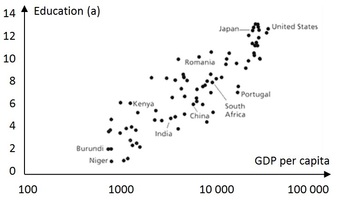
Impact of Education on GDP
This graph shows the positive relationship between education and per capita GDP of a country. As the number of years of education within a country increase, so does the per capita GDP.
Economics is one field of study that researches the effectiveness of education policies. Education policies are designed to cover all education fields from early childhood education through college graduate programs. Policies focus on school size, class size, school choice, tracking, teacher education and certification, teacher pay, teaching methods, curricular content, and graduation requirements. To ensure economic growth, a country must have strong education policies.
Health Economics and Policies
Health economics is the branch of economics that focuses on issues relating to the efficiency, effectiveness, value, and behavior in the production and consumption of health and healthcare. In this field, economists study the function of healthcare systems and public health-affecting behaviors. Health economics focuses on the following topics:
- What influences health
- What is health and what is its value
- What is the demand for healthcare
- What is the supply for healthcare
- Macro-economic evaluation at treatment level
- Market equilibrium
- Evaluation of the whole healthcare system
- Planning, budgeting, and monitoring the system
Although health is not directly related to human capital, it is obvious that without health and life human capital will be impacted negatively. Health policies are the decisions, plans, and actions that are undertaken in a country to achieve specific healthcare goals. According to the World Health Organization, a successful health policy defines a vision for the future, it outlines national priorities regarding health, and it builds a consensus and informs the public.
Health policies can have positive long-run effects on not only human capital, but also economic growth as a whole. Health policies are designed to educate society and improve the current and long-term health of a country. Examples of health policy topics include: vaccination policies, tobacco control, and pharmaceutical policies.
Furthermore, healthcare can constitute a large part of a country’s expenditures. Determining the structure of the healthcare system (private, public, regulated, etc.) can have large economic consequences, and therefore is of great interest to the government.
20.5.3: Defining and Defending Property Rights
Property rights are theoretical constructs that determine how a resource is used and owned.
Learning Objective
Explain the economic consequences of property rights
Key Points
- There are four broad components that property rights consist of: the right to use the good, the right to earn income from the good, the right to transfer the good to others, and the right to enforcement of property rights.
- Property usually refers to ownership and control over a good or resource. Ownership means that the entity or individual has the rights to the proceeds of the output that the property generates.
- There are four types of property rights: open access, state, common, and private.
Key Terms
- resource
-
Something that one uses to achieve an objective, e.g. raw materials or personnel.
- property rights
-
The exclusive rights pertaining to the ownership of a given asset.
Property Rights
Property rights are theoretical constructs that determine how a resource is used and owned. Resources can be owned and used by governments, collective bodies, or individuals. There are four broad components of property rights. They are the right to:
- use the good,
- earn income from the good,
- transfer the good to others, and
- enforce the property rights.
Property usually refers to ownership and control over a good or resource. Ownership means that the entity or individual has the rights to the proceeds of the output that the property generates.
Types of Property Rights
Property rights are determined based on the level of transaction costs associated with the rights. The transaction costs are the costs of defining, monitoring, and enforcing the property rights. The four types of property rights are:
- Open access property: this type of property is not owned by anyone. For this reason, no one can exclude anyone else from using it. It is possible though that one’s person use of the property will reduce the quantity available to others. Open access property is not managed by anyone and access to it is not controlled. Examples include the atmosphere or ocean fisheries.
- State property: also known as public property, this type of property is owned by all, but its access and use is controlled by the state. An example would be a national park .
- Common property: also called collective property, this type of property is owned by a group of individuals. The joint owners control the access, use, and exclusion of the property.
- Private property: use of this type of property is exclude. Private property use and access is managed and controlled by a private owner or a legal group of owners.
Defending Property Rights
For any good, property rights must be monitored and the possession of the rights must be enforced. The rights are put in place to control, monitor, and exclude the use of the stated property. Property rights protect not only land, but also goods, services, and finances associated with the land itself. Corruption impacts the private and public sectors because it increases the cost of doing business and distorts markets.
The concept of property rights are closely related to the law in terms of defending the rights. There is a difference between an economist’s view of property rights and the view of the law, but both work together to reach the final goal of securing and maintaining the rights. For example, suppose a thief steals a good. The thief has economic property right to the good because it is in his possession – he has the ability to use the good. However, the thief does not have legal property right to use the good – by law he is not permitted to have access to or use of the good. Economics sets the property rights and the law is used to enforce the rights. Each of the four types of property rights differ in the amount of money and defense needed to ensure that the rights are upheld. The greater the restrictions that property rights place, the more likely that defense of the rights will be needed.

Yosemite National Park
This picture is a view at Yosemite National Park. National parks in the United States are state property. Access and use of the park is controlled and enforced by the state.
20.5.4: Promoting Free Trade
Government can promote free trade by reducing tariffs, quotas, and non-tariff barriers.
Learning Objective
Describe the effects of free trade and trade barriers on long run growth
Key Points
- Free trade allows countries to produce the good in which they have a comparative advantage, which increases overall welfare.
- Tariffs and quotas are explicit government economic protections that reduce the efficiency of global markets.
- Non-tariff barriers like quality standards and customs paperwork are other government-implemented barriers to trade.
- Governments can reduce barriers to free trade unilaterally, bilaterally, or multilaterally.
Key Terms
- tariff
-
A system of government-imposed duties levied on imported or exported goods; a list of such duties, or the duties themselves.
- comparative advantage
-
The ability of a party to produce a particular good or service at a lower margin and opportunity cost over another.
Free trade is a policy by which a government does not discriminate against imports or interfere with exports by applying tariffs (to imports), subsidies (to exports), or quotas. According to the law of comparative advantage, the policy permits trading partners mutual gains from trade of goods and services.
Government Barriers to Free Trade
There are a number of barriers to free trade that governments can mitigate, most importantly, tariffs (government imposed import taxes) and quotas (government imposed limits on the quantity of a good that can be imported). Tariffs and quotas are explicit government policies that are designed to protect domestic producers, even if they are not the most efficient producers .

Loss Due to Tariffs
There are a number of reasons why governments place tariffs or other barriers to free trade, but they necessarily reduce overall societal welfare. Governments can promote free trade and impact economic growth.
In addition to tariffs and quotas, there are a number of other barriers to free trade that countries use. Broadly, they are categorized as non-tariff barriers (NTBs). NTBs come in a variety of forms. One example of an NTB are product standard requirements. A country can set high quality standards for a product, knowing that not all foreign producers will be able to meet the standard. Another way that countries can implement NTBs is through customs procedures. Countries can force foreign exporters to fill out arduous paperwork over the course of months, and perhaps in a language the foreign producer does not speak. NTBs act just like tariffs and quotas in that they are barriers to free trade.
Government Promotion of Free Trade
Countries that recognize the benefits for growth from promoting free trade can take unilateral, bilateral, or multilateral action to reduce some of these barriers to trade.
Unilateral promotion of free trade is when a country decides to reduce its own trade barriers without any promise of action from its trading partners. This would lead to a reduction in import prices, but could be unpopular with domestic industries who are not afforded lower barriers in the countries with which they wish to trade.
Bilateral promotion of free trade is when two countries come to an agreement to reduce barriers together. This solves the problem of one country giving the benefit of reduced barriers to foreign exporters without any promise of similar benefits in return.
Multilateral promotion of free trade is when a group of countries agree to reduce their barriers together. Examples of multilateral promotion of free trade are trade agreements such as the North American Free Trade Agreement (NAFTA) in which the US, Mexico, and Canada agreed to allow free trade among one another.
Reducing barriers to free trade may be politically difficult, but due to the law of comparative advantage, will allow for increased overall surplus for each trading partner in the long run.
20.5.5: Investing in Research and Development
The government can establish intellectual property laws, directly conduct research, or finance research and development.
Learning Objective
Describe the appropriate role of government in research and development
Key Points
- Patents are a form of intellectual property rights protection that encourages researchers to invest in research.
- The government can conduct research itself. NASA is an example of a government agency that conducts research and development directly.
- The government offers funding to non-government researchers, often through grants.
Key Terms
- intellectual property
-
Any product of someone’s knowledge that has commercial value: copyrights, patents, trademarks and trade secrets.
- research and development
-
The process of discovering and creating new knowledge about scientific and technological topics in order to develop new products
The government has the ability to encourage or discourage research and development. The government can do so by creating a good structure of intellectual property protection, called, broadly, patent law. It can also directly intervene and encourage or discourage research and development in a specific area of interest to the government or society that is not currently being addressed by the market.
Investing in research and development is important because it can result in new products, technologies, or processes. Thus, research and development can improve productivity or simply improve the welfare of society.
This atom will first discuss how the government can establish a patent system, and then ways in which it can directly affect the level of research and development in an economy.
Patents
Patents are temporary monopolies granted to inventors by the government, in exchange for public disclosure of how the invention works. They are one of the basic forms of intellectual property. Essentially, a patent gives the holder the right to exclude others from, among other things, using, selling, and making the claimed invention.
Patents and, more broadly, intellectual property rights, are important because they encourage investment in research. Without intellectual property protection, researchers would be worried that, once they make a breakthrough, competitors would simply sell their product. The original researcher would have made the investment in the research, but would have to compete with others once the research becomes able to generate revenue.
Direct Government Research
When the government directly conducts research, it hires its own scientists, engineers, etc. to study a particular issue. For example, NASA is a government agency that also does research.
Indirect Government Research
The government also finances research and development that it does not directly conduct. Such financing often takes the form of grants given to researchers in companies or organizations by the government. The government incentivizes the researches by making the research financially affordable (or more affordable). Not all research is financed, however. The grants are given to projects that are valuable either to the government or to society as a whole. Such grants can be viewed through the lens of market failure: the open market is not financing a socially or government-desirable project, so the government steps in to correct the failure.
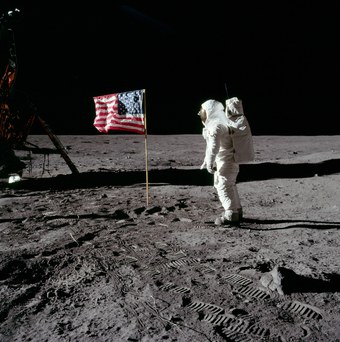
NASA’s Research and Development
The moon landing was the result of research and development conducted directly by a government agency.
